The Northern Pike is an extremely exciting fish: It is fast, aggressive, likes to feed (as well as feed a lot) and can reach a considerable size. All these characteristics make it not only the ultimate predator but also an extremely popular target fish.
Since the pike can also be a rather difficult and consequently intimidating species to fish for – especially for beginners – we have written this article with our best tips on pike fishing as a help to catch (big) pike.
-
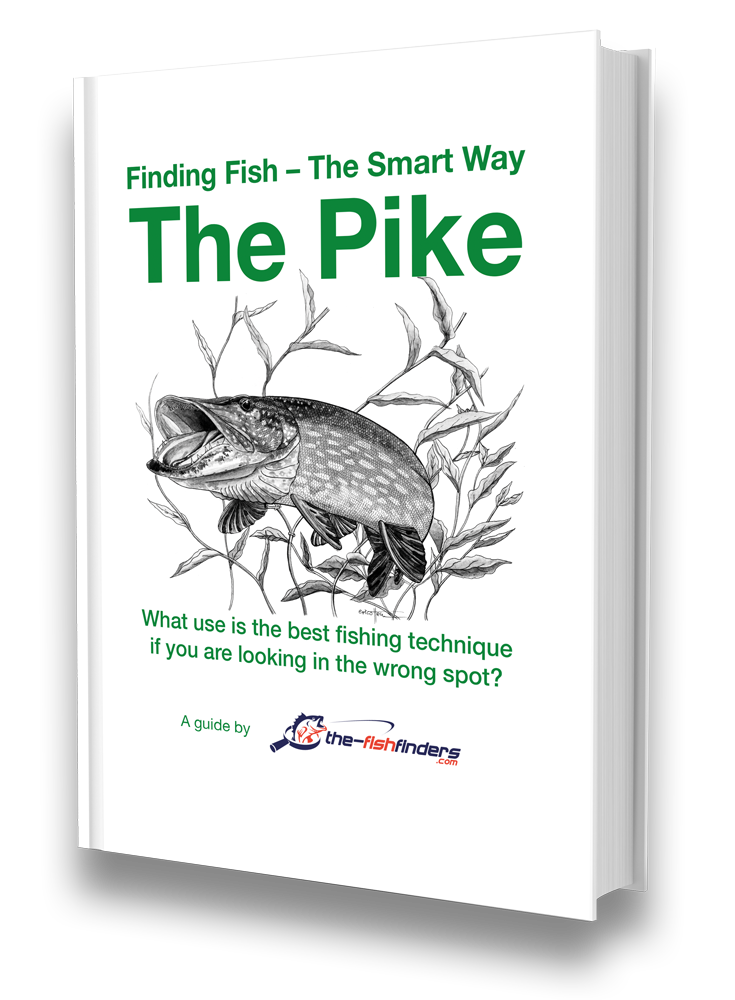
Finding Fish The Smart Way – The Pike
Download 40 pages now for free
This article is an excerpt from:
Reviews ( 64 )
Why some pike are easy and many are hard to catch
Everyone knows them: Days on which not even an old shoe wants to bite. And at the latest after the second day without a bite, even the angler on the water starts to wonder and suspects that something is wrong.
However, be careful: If you act too hastily now, you only risk extending your negative streak even further.
While failing at fishing, strange thoughts slowly creep into one’s consciousness. Questions like
- “Am I using the wrong lures?” – motivating us to buy new baits. Or
- “Am I fishing in the right place?” – to which the answer is a change of location. As well as last but not least.
- “Is it even the right time to fish (for fish xy)?” – which makes us quietly doubt our basic suitability as fishermen.
And the longer the lack of success, the more vulnerable we become for buying a new bait, fishing rod or technical equipment such as an expensive fish finder ( echo sounder).
If all this does not bring any success either, in our desperation we already start to believe that there are no more fish left in the respective body of water. But anyone who has ever been present when a club pond was drained, knows how many fin carriers even the smallest body of water can harbor.
So how is it that not a single fish wants to be hooked, even though they swim around in the waters in greater numbers than suspected?
Commercial fishing companies talk about two fish populations in this context. One is the total stock and the other is the fishable stock. Huh? Fishable?
Yes, not every fish in a body of water is fishable. As Sebastian Paetsch from the Müritz fishermen told us, there are far fewer fish you can hook than are actually swimming around in the water.
That this is the case is essentially due to 3 reasons:
1.1 The digestion
We also deal with the fish stock that can be fished in several places in our book “Modern fish finding – the pike”. For example in chapter 3.3.2 “The digestion of the prey”. As a rule, a pike is only fishable when it is about to feed or when it is already hunting for food. The rest of the time, it will be difficult to persuade it to bite.
-

Finding Fish The Smart Way – The Pike
Download 40 pages now for free
This article is an excerpt from:
Reviews ( 64 )
Martin
Hi Garry, i saw that contacting Jens has solved your problem. As written in the Order Mail, download is limited to 3 times. We introduced the limit to prevent fraud. However, if you lose your eBook in the future, please email us and you will of course get new downloads. Martin- Rated 1 out of 5
Garry Gregg
I bought the book online, but try as I might it would not save on my iPad mini 3, from the small amount i was able to read it looked very good. I was given a link that was promised to ALWAYS be available to me, but this was not the case! I wanted to learn how to find Pike in Lough Neagh, the largest lake in the U.K. but I can only fish it blind, useless. Make sure you can save this book BEFORE you buy. - Rated 5 out of 5
Andreas Eden
Unlike other reviewers, I am NOT in favor of shortening or streamlining. The detailed but not generalized aspects provided are scientifically sound and outline the respective topics exceedingly well. Looking forward to more of this, and keep up the great work! Martin
Hi Claus, Thank you for the info about the Tolino. So far, there have been no problems with the popular Android or Apple smartphones and tablets. We’ll take a look at it. Did the upload via the Tolino web reader not work either? Regards Martin- Rated 2 out of 5
Claus Erhard
The content is decent – maybe a little too detailed. Note: I bought the e-book version. The fact that you can’t print it out is alright (this option would be great though). However, I cannot read the PDF file on my Tolino. I uploaded it 1000 times, and nothing is displayed. So reading is only possible on the PC. Too bad! - Rated 5 out of 5
Dieter Gundacker
Highly recommended, lots of fascinating information. It is not easy to put the book down once you have started reading. - Rated 5 out of 5
Kurt Sattler
Great book. I also have “The Pikeperch”. Both are highly recommended. - Rated 5 out of 5
Mirko
A very well written book. - Rated 4 out of 5
Holzblinker
Among the advantages: -statistics and their interpretation -written in a simple and understandable way Among the disadvantages: -advertising -A lot of generally known information - Rated 3 out of 5
Bruno
Exciting content (****) with a tendency to be long-winded (**) - Rated 5 out of 5
Stefan
The book keeps what it promises. An all-around great book that stands out from the rest. The purchase was worth it! - Rated 5 out of 5
Fischfreund
A truly superb book. I also own the book on pikeperch and have to admit that they are two completely different books. There are very few overlaps, so I never had the feeling that I already knew a passage in the book. For this reason, I can unreservedly recommend the pike book. It was so much fun reading it and gradually learning more about the pike. - Rated 5 out of 5
Paul KraUS
An elaborate approach to the behavior of the fish to conclude your fishing behavior, etc. I also like that other professional opinions are taken into account and partly questioned and analyzed. You can learn a lot to save the one or the other unsuccessful day. Thank you! - Rated 5 out of 5
barney1at
I am impressed with the book! I have read many books about fishing, and this was by far the best. It reflects not only the experiences and interpretations of the authors but uses scientific studies as a basis. Some of the findings knocked my socks off, e.g., the distance of attention of the pike. Strong recommendation for anyone who wants to improve their pike fishing skills! - Rated 5 out of 5
Michael Hügel
Sehr gutes Buch hat mir weitergeholfen das Leben des Hechtes zu verstehen. - Rated 5 out of 5
frankadam67
Sehr, sehr schönes Buch mit vielen Informationen! Nun muss ich nur noch alles in die Tat umsetzen! Danke für das gut ausgearbeitete Buch! - Rated 5 out of 5
Thomas Asamer
Bin gerade am Lesen des Buches. Sehr interessant und informativ. Werde meine Hechtfänge sicherlich noch um einiges steigern können mit dem KnowHow des Buches! Weiter so!? - Rated 5 out of 5
Andre Scholz
Hallo Zusammen, ich kann nur sagen, das habt ihr wirklich sehr gut gemacht! Wahnsinnig informativ, Super gegliedert und mit vielen guten Tipps behaftet. Das Zanderbuch war schon ein Knaller!!! Ich freu mich schon auf das Barschbuch. Und nebenbei erwähnt, die Videolektionen Köderkurs 1 sind ebenfalls Mega spannend! Bitte weiter so machen…. Petri Andre - Rated 5 out of 5
Manfred Parbs
Ich finde die Bücher ” Der Hecht ” sowie ” Der Zander ” sind für erfahrene Angler und auch für den Anfänger sehr lehrreich und somit auch informativ gestaltet. Auch die vielen Tips haben mich persönlich schon so manches mal vor einem Schneidertag bewahrt. Ich besitze zudem auch noch das Buch ” Der grosse Echolotratgeber ” . Dieses Buch liefert gute Erklärungen für die Funktionen und Einstellungen von Echoloten. Desweiteren besitze ich auch noch zwei Angelkurse: zum einen Köderfarbe und zum anderen Der Deeper. Beide Kurse sind mit sehr viel Informationen und verständlichen Erklärungen gespickt die jederman sehr gut verstehen kann. Freue mich schon auf weitere Bücher. Ein grosser Dank als auch ein grosses Lob an das Fischfinderteam. Petri Heil & immer dicke Fische Manfred Parbs - Rated 4 out of 5
Fabius Voigt
Klasse Buch! Fundiertes Wissen auf gute Art und Weise zusammengefasst und übermittelt, damit Angler ihren Zielfisch besser verstehen. An einigen Ecken im Buch, wäre ein weitere genauere Ausarbeitung toll gewesen (wurde vom Autor aber selbst bemerkt und begründet). Desweiteren beruhen die meisten Angaben (90%) von Hechten aus Seen und leider nur sehr wenig aus Flüssen. Das sind meiner Meinung nach die einzigen Sachen die fehlen, aber ansonsten würde ich es als Bereicherung für jeden Angler beschreiben! - Rated 5 out of 5
Julia
Genau wie das Zanderbuch wieder der totale Hammer! Wobei für mich die Voraussetzungen etwas anders waren: Während ich meine Zanderfänge wirklich mal dringend etwas ankurbeln musste, fing ich alleine im vorigen Jahr 47 Hechte, es ging hier also eher um Optimierung. Und das ist voll gelungen! Massen von überaus hilfreichen Forschungsergebnissen, Statistiken und Tafeln. Ich bin beim Spinnangeln bisher zu viel gewandert und habe die einzelnen Spots zu kurz beangelt, das weiß ich jetzt. Und so ganz nebenbei ist mir jetzt noch klar, weshalb man in einigen durchaus interessanten Seen in meiner Umgebung von Juni bis Januar partout keinen Fisch fängt. Habe nämlich so einiges über die Schichtung gelernt, und dass eine Abkühlung eben nicht automatisch gleich Verbesserung bedeutet. Klasse! Her mit dem nächsten Buch bitte! - Rated 5 out of 5
Pascal Schlenker
Top nicht das letzte Buch für mich…. - Rated 5 out of 5
Heinz-Otto Schoel
Auf den 50zig Seiten, die ich bis jetzt gelesen habe ,bin ich begeistert. Aber die anderen Bücher über das Echolot und dem Zander waren sehr lehrreich. Weiter so. Freue mich schon auf das Barschbuch. - Rated 5 out of 5
Andreas Hillers
Modernes Fischen – Der Hecht. Ein sehr gut geschriebenes Buch. Bin begeistert von den vielen tollen Hilfestellungen. Sogar als erfahrener Angler kann hier bestimmt jeder noch den ein oder anderen Tipp für sich nutzen. Vielen lieben Dank, und weiter so für vielleicht weitere noch nicht erschienene Bücher über den Aal, Barsch, Karpfen etc. - Rated 5 out of 5
Stephandargel
Das Buch ist einfach nur klasse super beschrieben sehr verständlich beschrieben kann ich nur weiter empfehlen ? gebe dem Buch und dem Autor ne 1+ - Rated 5 out of 5
Rolf Wilde
Sehr praxisnah und auch mit viel Hintergrundinformationen gefülltes Buch. Ich habe über die Feiertage die ersten Seiten verschlungen. Sehr viele Details die ich noch bis zur Schonzeit versuche umzusetzen. - Rated 5 out of 5
Blankmaster
Die Referenz. Umfassend, kein blabla, über den Tellerrand hinausschauend, fundiert, sinnvolle und gut gemachte Graphiken, und das Ganze zu allem Überfluss auch noch unterhaltsam geschrieben. Als bekennender Wenigleser habe ich das Buch innerhalb von 3 Tagen einmal komplett durchgelesen. Uneingeschränkte Kaufempfehlung. - Rated 5 out of 5
Rudolf Knopf
Endlich ein Buch, welches man durchaus als Fachliteratur beschreiben kann. Es werden viele Erfahrungen, welche ich beim meiner Suche nach dem Hecht gemacht habe, bestätigt. Ebenso ist auch sehr viel Neues für mich in dem Buch, was ich bisher in meiner vieljährigen Anglerlaufbahn so nicht gewust habe. Absolute Kaufempfehlung. - Rated 5 out of 5
markus s
Großes Kompliment zum Buch! Ich fische seit meiner Kindheit auf Hecht (und das sind schon mehr als dreißig Jahre) und ich muss sagen, es gibt keine interessantere Lektüre zum Hecht! Viele eigene Theorien finde ich hier bestätigt, aber noch besser: Dieses Buch bietet auch wirklich neue Ansätze! - Rated 5 out of 5
Mitja
Beeindruckende Leistung von Euch, ein so komplexes Thema derart runterzubrechen, daß man das Buch in einem Rutsch durchlesen kann, ohne sich dauernd zu fragen: „verdammt, wovon labern die denn da?“ Superspannend: die Trophieklassifizierung und die Sache mit der Sprungschicht! Ich sehe meine Gewässer jetzt mit ganz anderen Augen und auf einmal kommen mir die 150 Kracher für das Anaconda-GTM gar nicht mehr so übertrieben teuer vor! Und weil es mir so gut gefallen hat, zieh ich mir morgen direkt das Echolot-Buch rein, das mit der Postbote heute morgen in den Kasten geworfen hat….für das Barschbuch hätte ich übrigens gerne einen Gutscheincode 🙂 Danke! Ich freu mich auf weitere spannende Lektüre aus eurem Stall… - Rated 5 out of 5
schoenfeld.oli
Absolut feine Lektüre. Ich gehe nach Lesen des Buches ganz anders ans Wasser. Zwischendrin etwas fader Stoff, der aber einfach dazu gehört. Dafür sind die spannenden Themen so spannend, dass ich nicht im Sitzen lesen konnte. - Rated 5 out of 5
Robert Häusler
Die beiden Autoren Martin Jacobs und Jens Biegemeier sind der Hammer. Ich habe schon viel gut recherchierte Medizinbücher gelesen und oft haben sie mir zu mehr Erfolg verholfen, dass das auch mal Zum Hechtangeln möglich wird ist großartig. Danke an dieses Meisterwerk! Ich habe mit dem Wissen aus dem Buch jetzt schon meinen Angelrekord auf Hecht gebrochen und bin mir sicher da geht noch was. Danke für eure Arbeit, den Fleiß und die Begeisterung die ihr geleistet haben müsst dieses moderne Fische finden für uns und unsrer Seekrokodiele zu ermöglichen. Petri Robert Häusler Martin
Edi, wir danken Dir und wünschen euch gute Fänge. Petri Martin vom Fischfindertestteam- Rated 5 out of 5
Edi Brader
Das beste Buch über die Fischerei auf Hecht, das ich bisher in Händen gehalten habe! Sehr ausführlich und praxisnah wird dem Einsteiger in diese Fischerei veranschaulicht worauf es ankommt und auch der eingefleischte Hechtprofi kann noch sehr viel Nützliches aus diesem Buch herausholen! Absolut EMPFEHLENSWERT! Besonders möchte ich das äußerst nette Team loben! Bei meiner Bestellung ging etwas schief, ich bekam zwei anstatt nur einer Ausgabe. Nach Rücksprache bedankten sie sich für die Information und sagten mir, dass das Zurücksenden ohnehin zu teuer wäre und ich das zweite Exemplar auch behalten dürfte. Danke Jungs, ihr habt gerade einem befreundeten Jungangler eine große Freude gemacht, ich werde euch auf jeden Fall weiterempfehlen! Macht weiter so! Petri Heil Edi Brader - Rated 5 out of 5
lusox
Prima Lektüre , wirklich zu empfehlen ! Besonders gut fand ich das Kapitel mit der Ködergröße. Ebenso das Kapitel mit den Standplätzen und die Rolle der Vegetation Ich habe viele Anregungen daraus mitgenommen und bin mal gespannt wie sich meine Hechtfänge verbessern. Weiter so ! - Rated 5 out of 5
Stefan Fischer
Ich finde, das Buch “Der Hecht” lüftete viele Geheminisse. Hatte das Buch “Der Zander” auch, alles top tock. Hoffentlich folgt das Buch auch über den Barsch, evtl. Waller/Wels. Mir fehlt die Anglerpraxis. Das Buch “Das große Echolot” ist auch klasse. Weiter studieren!!! ^^ Namaste und Petri Fischer Stefan - Rated 5 out of 5
Lasse Wiedenhöft
Wie schon beim Zanderbuch werden für alle denkbaren Situationen (Jahreszeiten, Gewässer, Wetter etc.) hilfreiche Tipps zur Strategieverbesserung gegeben. Dabei helfen die Ergebnisse aus diversen Versuchen und Tests den Hecht und sein Verhalten besser zu verstehen. Gerade die wissenschaftliche Begleitung in Kombination mit eigenen Erfahrungen hat mir schon nach wenigen Kapiteln neue Ideen vermittelt! - Rated 5 out of 5
Johann Burgstaller
Wie bereits “Der Zander”, ist auch die Hechtausgabe wieder jeden Cent wert. Ein must-have für jeden Raubfischangler. Tolle Studien, jede Menge neue Erkenntnisse und enifach zu lesen. Na dann nichts wie auf zum “Der Barsch”! - Rated 5 out of 5
Barschhunter
Das Buch ist Euch wirklich super gelungen!!!!! Es ist sehr informativ und es ist für jeden etwas dabei, ob man nun Anfänger im Angeln ist oder ein erfahrener Angler ist. Man kann immer noch was dazu lernen. Für mich persönlich war das Kapitel “Jagd und Beute” sehr interessant und spannend und möchte deswegen keine einzelnen Punkt hervorheben. Macht weiter so und ich freue mich schon auf Euer nächstes Buch “Modernes Fische Finden Der Barsch” mein persölicher favorite Fisch. Dickes Petrie Barschhunter - Rated 5 out of 5
Andre Scholz
Genauso spannend und aufschlussreich wie das Zander Buch! Wenn man seinen Zielfisch besser verstehen möchte und mehr Erfolg haben will, kommt man nicht um das Buch herum! Allein die Thematik um die Wassertemperaturen, einfach irre! Volle 5 Sterne und Danke für so viel geilen Input! Petri Andre - Rated 5 out of 5
Andreas F.
Sehr schön finde ich die Aufmachung des Buches und die logisch aufbauenden Kapitel. Das Lesen macht viel Spaß. Hier treffen die Autoren genau den richtigen Ton, einen “mitzunehmen”, obwohl die Grundlagen ja wissenschaftlich/biologisch sind. Es ist nicht einfach, plausibel und allgemein verständlich, verschiedene wissenschaftliche Erkenntnisse miteinander zu verknüpfen und hieraus die passenden Schlussfolgerungen zu ziehen. Das ist jedoch durchaus gelungen. Abläufe in der Natur sind nie statisch sondern unterliegen Abweichungen, es gibt aber Tendenzen. Deshalb kann es nicht immer genaue Gesetzmäßigkeiten geben. Hierauf weist das Buch in verschiedenen Kapitel immer wieder hin. Hier hätte ein grundlegender Hinweis in der Einleitung m.e. jedoch ausgereicht. Randnotiz: Ein Absatz erscheint wortgleich an zwei Stellen (S. 11, 1.Abs. und S. 15 3. Abs.). Im Ergebnis ist es ein Buch, was sogar enthusiastischen Raubfischanglern richtig weiterhilft! Meine Erwartungshaltung wurde sogar übertroffen. Ich freue mich auf euer Barschbuch! Vielen Dank! - Rated 5 out of 5
Pascal Kreutzmann
Wie die beiden Bücher zuvor hat mich auch das Buch über den Hecht mal wieder total begeistert. Unglaublich was ihr für einen Aufwand betreiben müsst um all dieses Wissen und die Studien zusammen zu tragen. Besonders interessant fand ich zb. die Frage danach wieviele Hechte sich denn in so einem Gewässer aufhalten. An wievielen Fischen man vorbei angelt. Das war echt interessant. Ebenso die Standplätze der Fische zu den verschiedenen Jahreszeiten und wie sehr vieles von der Wassertemperatur abhängt finde ich sehr Aufschlussreich. Auch über das fressen und gefressen werden kann man einiges erfahren. Jetzt ist mir klar warum der Hecht die Beute am liebsten am Kopf packt und sie möglichst schnell verschlingen muss. Tja die Themenvielfalt ist echt groß. Was mich noch interessiert hätte….wie/was sieht der Hecht durch seine Augen ? Was für Farben nimmt er wahr etc ? Aber das wäre eventuell zu speziell ?! Freue mich auf das nächste Buch! Bloß nicht nachlassen und genauso ausführlich weiter machen. Danke dafür. Ps…ich rezensiere aus Überzeugung , nicht wegen einem Gummifisch ! Grüße und Petri Pascal - Rated 5 out of 5
Ralf B.
Genauso interessant und prall gefüllt mit wertvollen Infos wie das Zanderbuch, einfach TOP! - Rated 5 out of 5
Bickes
Sehr gut strukuriert, sehr informativ, mir hat es definitiv geholfen, meine Taktik zu verbessern und selbstbewusster meine Stellen auszuwählen. - Rated 5 out of 5
opto
Habe alle 3 Bücher! Bin begeistert und dankbar!! Interessieren würde mich warum gerade der Hecht an einem Tag wie verrückt beißt und am nächsten Tag bei absolut gleichen Bedingungen am selben Ort wie ausgestorben erscheint! Interessieren würde mich auch wie der Zander als Augentier mit Sichtigkeiten unter 5cm klarkommt! (Hochwasser) Diese Fragen beschäftigen mich schon ein ganzes Anglerleben. - Rated 5 out of 5
Adrian Drzezla
Das Buch hat sehr viele Informationen über unseren Esox Lucius;). Jedes Kapitel ist sehr spannend und reichhaltig an Informationen. Nach diesem Buch habe ich meine Angelstrategie verbessern können und ich habe nun eine andere Ansicht von unserem Hecht im Wasser bekomme. Petri ! „ sehr empfehlenswert , Genau so wie die letzten Bücher von Fischfindertest“ - Rated 5 out of 5
Evgenij
Suuuper Buch, genau so wie das Zander Buch. Bin total begeistert. Sieht wie eine Doktorarbeit aus. Wissenschaftlich überprüft mit Verweisen, vielen Abbildungen und vielen praktischen Tips. Freue mich auf die neue Bücher! - Rated 5 out of 5
Daniel
Ich kann das Buch jedem Raubfischangler weiterempfehlen. Viele neue und nützliche Informationen rund um unseren Zielfisch Nr. 1. Tolle Arbeit! - Rated 5 out of 5
Jörg
Tolles Buch, hochinformativ von der ersten bis zur letzten Seite. Das Jahr des Hecht hat mir am besten gefallen. Man kann das Buch nur weiterempfehlen! - Rated 5 out of 5
Dirk Lindner
Top buch.umfangreich.logisch.sollte jeder haben.das Zander buch habe ich auch - Rated 5 out of 5
Jörg Thielke
Hoch interessant und verständlich geschrieben. In jedem Fall vollumfänglich weiterzuempfehlen. Danke Männers ? - Rated 5 out of 5
Stefan Klingbeil
Es war nicht anders zu erwarten. Nach dem Zander Buch bin ich wieder voll zufrieden.Die Bücher unterscheiden sich von anderen Büchern und Artikeln aus Zeitschriften. Mehr input brauch ich nicht. Alles erklärt und vernünftig erklärt. Ich lese wirklich nicht gerne Bücher. Aber hier ist es wie ein guter Krimi. Man kann nicht aufhören. Wir haben es alle gelesen und Diskutieren unser Wissen zusammen um es nochmal zu vertiefen. Jetzt freuen wir uns auf Der Barsch ? - Rated 5 out of 5
Jörg Rolle
Ein sehr gutes Buch so wie ich es erwartet habe nach dem ich Euer Zander-Buch gelesen habe. bin begeistert viele Tipps in Jagd und Beute,Umweltfaktoren,Lebensräume Kapitel 5.2.2 und Das Jahr des Hechtes.Habe noch nicht viel Erfahrung Hecht angeln ,das Buch hat mir viel Wissen übermittelt auch wenn ich noch nicht alles gelesen habe. Danke weiter so Petri - Rated 5 out of 5
Philipp
Kurz und knapp, Top! Wie auch bereits im Buch “Modernes Fische finden Der Zander” erneut abgeliefert. Besten Dank, macht weiter so! - Rated 5 out of 5
Ben
Glaube ich hab gerade vergessen die Sterne zu drücken! Auf jeden Fall 5 Sterne da es super verständlich geschrieben ist! Es beschreibt das Verhalten der Fische in verschiedenen Situationen und wenn man das versteht und nutzt fängt man sicher bald besser! Auch die Grafiken und Bilder vereinfachen es sehr gut. Bin sehr zufrieden und hoffe das noch eins für Barsche und Wels kommt! ?? - Rated 5 out of 5
Nico Drabner
Volle Punktzahl ?? Ein dickes Lob. Sehr schön aufgebaut. Am besten hat mir die Gewässeranalyse und die Aussage mit der Wassertemperatur gefallen, das passt zu 100% und Danke an den vielen nützlichen Tipps - Rated 5 out of 5
Kuhnert Giso
Also ich habe schon das Buch vom Zander gelesen. Und auch dieses Buch vom Hecht ist sehr Lehrreich mit vielen interessanten Kapiteln.. Ich bin noch nicht ganz durch mit dem lesen, aber ich weiß das es toll ist und mir auf alle Fälle weiter helfen wird um den ein oder anderen Hecht mehr an den Haken zu bekommen. Ich empfehle es auf alle Fälle weiter.. Und auch das nächste Buch über den Barsch werde ich mir holen. Macht weiter so fünf Sterne gibt’s vom mir. LG Giso - Rated 5 out of 5
David Götze
Hallo zusammen, ich habe mittlerweile alle 3 Bücher und kann ehrlich behaupten, dass es mir beim Angeln bzw. Fische finden sehr viel gebracht hat. Vorallem das Angeln unter Einfluss der Mitwelt (Wind, Temperatur…etc) lässt mich jetzt meine Spotwahl genauer überdenken. Vielen Dank dafür und ich freu mich schon auf den Barsch ^^ Petri David - Rated 4 out of 5
Peter
absolute Empfehlung - Rated 5 out of 5
Ben
Finde das Buch sehr gut! Genau wie das Zander Buch beschreibt es worauf es ankommt… das Verhalten der Fische in verschiedenen Situationen. Es ist verständlich erklärt und die Bilder und Grafiken machen es noch einfacher zu verstehen worauf es ankommt! Weiter so! Barsch und Wels können kommen? - Rated 5 out of 5
Kantor Alfred (Hatschi)
Ich habe viele Jahre viel Zeit verschwendet weil ich den Fisch nicht immer gefunden habe, dass Buch hilft wirklich die Fische zu finden. Ich habe es nicht nur gelesen sondern auch schon teilweise am Wochenende umgesetzt und das mit Erfolg (einige schöne Hechte), vielen dank ich freue mich auf euer nächstes Werk Der Barsch. Weiter so!!! Petri Heil Hatschi - Rated 5 out of 5
Patrick
Also ich muss jetzt mal eine Lanze brechen, es gibt doch noch qualitativ hochwertige Bücher zum Thema Fisch und dann noch direkt zum Thema Hecht, in einer Qualität die ihres gleichen sucht. Selten das ich derart im „Rausch“ ein Buch gelesen habe. Hut ab und weiter so. - Rated 5 out of 5
Tacklefever
Ich war sehr positiv überrascht. Der Anfänger erhält im ersten Teil des Buches wirklich brauchbares Basiswissen vermittelt. Und der ein oder andere Profi wird vielleicht sagen: “Mache ich doch immer so”. Und das ist doch das beste Lob für den ersten Teil des Buches. Aber wenn der Profi ehrlich ist, kann er wahrscheinlich schon zugeben, das ein oder andere gefunden zu haben was er vergessen hatte oder doch noch nicht wusste. Und richtig spannend für Anfänger und Profi ist der Hautteil des Buches, das Kapitel “Jahr des Hechtes”. Dieser Teil hat absolut zu Recht den meisten Platz im Buch bekommen. Bei den einfach gegliederten und nachvollziehbaren Abschnitten im Jahr des Hechtes findet sicher nicht nur der Anfänger sondern auch der Profi jede Menge tolle Infos. Meine volle Buchbesprechung findet ihr unter https://www.tacklefever.de/index.php?topic=7396.0 - Rated 5 out of 5
Andreas
Wie erwartet, ein sehr gutes Buch das nicht in dem Köderwahnsinn hinterherläuft. Besonders gut gefällt mir die Analyse der Wassertemperaturbereiche passend für meine großen See in Mecklenburg. Die Gewässeranalysen passen wie die Faust auf Auge auf dieses sehr große Gewässer. Die neuen Möglichkeiten und überragenden Fänge von einigen lokalen Guides erzielt werden, welche in Großen Teilen durch die gewaltigen Technologiesprünge im Echolotbereich und Bootsnavigation begründet sind, wurde hier sehr gut zusammengefasst. Eine Pflichtlektüre für jeden der sich an die großen Gewässer mit den noch größeren Fische wagen will. Definitiv 5 Sterne, das Buch wurde auch innerhalb von 2 Nachmittagen gelesen. Danke! - Rated 5 out of 5
Wolfgang Konter
Habe das Buch heute bekommen .Dafür erstmal ein großes Danke schön an Euch . Nach dem ersten Durchblättern war ich begeistert . Habe eigentlich auch nichts anderes erwartet . “Modernes Fische finden – Der Zander” habe ich ja schon lange durch und blättere immer wieder drin rum . Beide Bücher zeugen von viel Sachverstand und Erkenntnissen , die ich so nicht erwartet hätte . Einfach super und verständlich erklärt . Jetzt will ich nur hoffen , dass noch ein Barsch Buch auf dieses Duo folgt . Petri Heil Wolfgang Konter - Rated 5 out of 5
Catchmaster
Habe das Buch heute direkt durchgelesen. Es ist gut aufgebaut und es gibt viele nützliche Tip’s. Anfang Mai waren wir in Schweden auf Hecht angeln. Schade, dass ich dieses Buch nicht schon vorher hatte. Aufgrund der neuen Erkenntnis hätte ich bestimmt mehr Erfolg gehabt. An sich ein super Buch. Werde jetz die Tip’s in die Praxis umsetzen. Vielen Dank für dieses Buch. - Rated 5 out of 5
Jörg Rolle
Habe das Buch Heute erhalten und sofort durchgestöbert,bin Begeistert! Sehr schöne Aufmachung, gut Gegliedert und nicht zu wissenschaftlich so das es jeder Angler verstehen kann.Habe auch schon Kapitel gefunden die mir reichlich neues und gute Tipps für meine Angelpraxis gefunden. Weiter so!!!!!!! Petri Jörg Rolle
1.2 The lurker
In addition, we can state that actively swimming pike are easier to fish for than lurking predators. Due to their greater activity, they consume more energy and need to feed more often. Furthermore, they are more likely to cross the path of our lures.
If you have chosen lurking pike as your target, you will most likely need to adjust your fishing strategy accordingly. The strategic casting of your fishing area and a slow lure action gain a lot of importance here.
1.3 A matter of experience
It is assumed that fish also learn through experience. They recognise patterns, which make them do certain things – or not. Nowadays, our waters are much frequented and used for recreational activities in summer.
Fishing pressure is also on the rise, and more and more lures are roaming the water, because fishing is what fishing is: popular.
It seems that pike have a memory and can remember bait, for example. This is mainly because, as predators, they have a more complex brain than their prey. This leads them to remember patterns and avoid “strange-looking prey fish” or certain places at certain times.
How does the pike catch its prey?
Basically, there are two different hunting strategies of pike: Lurking and active pursuit. In the course of their young life they often specialise in one or the other way of hunting successfully. The more active a pike is in the first 2 years of his life, the faster it grows and the more agile it becomes. Most anglers therefore catch pike with an active lifestyle whilst blithely fishing past the other lurking pike.
So, if you want to be more successful than before, you need to adapt to these two behaviours of the predator and adjust your fishing technique accordingly. Because different pike hunting tactics require different hunting tactics from our side.
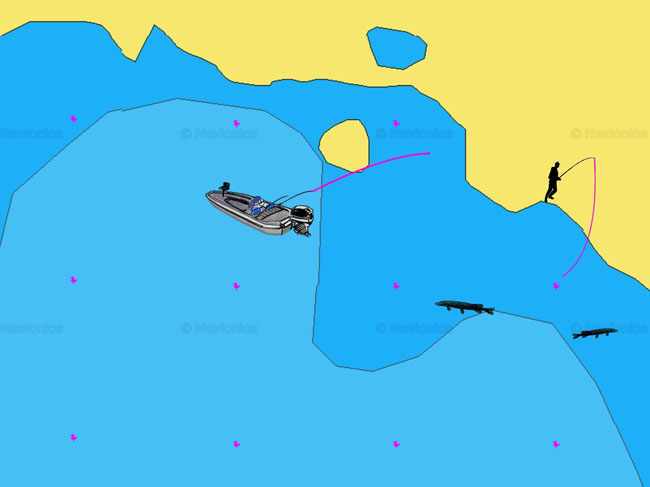
Most of us will hook an actively hunting pike more often, as they are easier to catch than lurking ones. Those who swim around a lot are not only more likely to hit our baits.
Likewise, an active pike needs to feed more and more often because its calorie consumption is higher. This is another reason why it lands more easily on one of our hooks.
2.1 How do you fish for a motionless lurking predator?
The thing is that only about 25% of all pike are considered active hunters. Much more often they use their peculiar hunting strategy of ambushing their prey. In doing so, the pike stay hidden among plants, behind pillars, in the shadows or in the darkness of the depths.
But a lurking predator does not aimlessly chase after every prey. He does not want to abandon his hiding place and camouflage without good reason. His attack comes from ambush with lightning speed. But before that, it often waits motionless for a long time for the most appetising prey – and the most promising moment.
A promising lure for lurking pike is the following one. It is guided slowly and can linger quite a long time in the sight of a lurking pike.
-

Finding Fish The Smart Way – The Pike
Download 40 pages now for free
This article is an excerpt from:
Reviews ( 64 )
Martin
Hi Garry, i saw that contacting Jens has solved your problem. As written in the Order Mail, download is limited to 3 times. We introduced the limit to prevent fraud. However, if you lose your eBook in the future, please email us and you will of course get new downloads. Martin- Rated 1 out of 5
Garry Gregg
I bought the book online, but try as I might it would not save on my iPad mini 3, from the small amount i was able to read it looked very good. I was given a link that was promised to ALWAYS be available to me, but this was not the case! I wanted to learn how to find Pike in Lough Neagh, the largest lake in the U.K. but I can only fish it blind, useless. Make sure you can save this book BEFORE you buy. - Rated 5 out of 5
Andreas Eden
Unlike other reviewers, I am NOT in favor of shortening or streamlining. The detailed but not generalized aspects provided are scientifically sound and outline the respective topics exceedingly well. Looking forward to more of this, and keep up the great work! Martin
Hi Claus, Thank you for the info about the Tolino. So far, there have been no problems with the popular Android or Apple smartphones and tablets. We’ll take a look at it. Did the upload via the Tolino web reader not work either? Regards Martin- Rated 2 out of 5
Claus Erhard
The content is decent – maybe a little too detailed. Note: I bought the e-book version. The fact that you can’t print it out is alright (this option would be great though). However, I cannot read the PDF file on my Tolino. I uploaded it 1000 times, and nothing is displayed. So reading is only possible on the PC. Too bad! - Rated 5 out of 5
Dieter Gundacker
Highly recommended, lots of fascinating information. It is not easy to put the book down once you have started reading. - Rated 5 out of 5
Kurt Sattler
Great book. I also have “The Pikeperch”. Both are highly recommended. - Rated 5 out of 5
Mirko
A very well written book. - Rated 4 out of 5
Holzblinker
Among the advantages: -statistics and their interpretation -written in a simple and understandable way Among the disadvantages: -advertising -A lot of generally known information - Rated 3 out of 5
Bruno
Exciting content (****) with a tendency to be long-winded (**) - Rated 5 out of 5
Stefan
The book keeps what it promises. An all-around great book that stands out from the rest. The purchase was worth it! - Rated 5 out of 5
Fischfreund
A truly superb book. I also own the book on pikeperch and have to admit that they are two completely different books. There are very few overlaps, so I never had the feeling that I already knew a passage in the book. For this reason, I can unreservedly recommend the pike book. It was so much fun reading it and gradually learning more about the pike. - Rated 5 out of 5
Paul KraUS
An elaborate approach to the behavior of the fish to conclude your fishing behavior, etc. I also like that other professional opinions are taken into account and partly questioned and analyzed. You can learn a lot to save the one or the other unsuccessful day. Thank you! - Rated 5 out of 5
barney1at
I am impressed with the book! I have read many books about fishing, and this was by far the best. It reflects not only the experiences and interpretations of the authors but uses scientific studies as a basis. Some of the findings knocked my socks off, e.g., the distance of attention of the pike. Strong recommendation for anyone who wants to improve their pike fishing skills! - Rated 5 out of 5
Michael Hügel
Sehr gutes Buch hat mir weitergeholfen das Leben des Hechtes zu verstehen. - Rated 5 out of 5
frankadam67
Sehr, sehr schönes Buch mit vielen Informationen! Nun muss ich nur noch alles in die Tat umsetzen! Danke für das gut ausgearbeitete Buch! - Rated 5 out of 5
Thomas Asamer
Bin gerade am Lesen des Buches. Sehr interessant und informativ. Werde meine Hechtfänge sicherlich noch um einiges steigern können mit dem KnowHow des Buches! Weiter so!? - Rated 5 out of 5
Andre Scholz
Hallo Zusammen, ich kann nur sagen, das habt ihr wirklich sehr gut gemacht! Wahnsinnig informativ, Super gegliedert und mit vielen guten Tipps behaftet. Das Zanderbuch war schon ein Knaller!!! Ich freu mich schon auf das Barschbuch. Und nebenbei erwähnt, die Videolektionen Köderkurs 1 sind ebenfalls Mega spannend! Bitte weiter so machen…. Petri Andre - Rated 5 out of 5
Manfred Parbs
Ich finde die Bücher ” Der Hecht ” sowie ” Der Zander ” sind für erfahrene Angler und auch für den Anfänger sehr lehrreich und somit auch informativ gestaltet. Auch die vielen Tips haben mich persönlich schon so manches mal vor einem Schneidertag bewahrt. Ich besitze zudem auch noch das Buch ” Der grosse Echolotratgeber ” . Dieses Buch liefert gute Erklärungen für die Funktionen und Einstellungen von Echoloten. Desweiteren besitze ich auch noch zwei Angelkurse: zum einen Köderfarbe und zum anderen Der Deeper. Beide Kurse sind mit sehr viel Informationen und verständlichen Erklärungen gespickt die jederman sehr gut verstehen kann. Freue mich schon auf weitere Bücher. Ein grosser Dank als auch ein grosses Lob an das Fischfinderteam. Petri Heil & immer dicke Fische Manfred Parbs - Rated 4 out of 5
Fabius Voigt
Klasse Buch! Fundiertes Wissen auf gute Art und Weise zusammengefasst und übermittelt, damit Angler ihren Zielfisch besser verstehen. An einigen Ecken im Buch, wäre ein weitere genauere Ausarbeitung toll gewesen (wurde vom Autor aber selbst bemerkt und begründet). Desweiteren beruhen die meisten Angaben (90%) von Hechten aus Seen und leider nur sehr wenig aus Flüssen. Das sind meiner Meinung nach die einzigen Sachen die fehlen, aber ansonsten würde ich es als Bereicherung für jeden Angler beschreiben! - Rated 5 out of 5
Julia
Genau wie das Zanderbuch wieder der totale Hammer! Wobei für mich die Voraussetzungen etwas anders waren: Während ich meine Zanderfänge wirklich mal dringend etwas ankurbeln musste, fing ich alleine im vorigen Jahr 47 Hechte, es ging hier also eher um Optimierung. Und das ist voll gelungen! Massen von überaus hilfreichen Forschungsergebnissen, Statistiken und Tafeln. Ich bin beim Spinnangeln bisher zu viel gewandert und habe die einzelnen Spots zu kurz beangelt, das weiß ich jetzt. Und so ganz nebenbei ist mir jetzt noch klar, weshalb man in einigen durchaus interessanten Seen in meiner Umgebung von Juni bis Januar partout keinen Fisch fängt. Habe nämlich so einiges über die Schichtung gelernt, und dass eine Abkühlung eben nicht automatisch gleich Verbesserung bedeutet. Klasse! Her mit dem nächsten Buch bitte! - Rated 5 out of 5
Pascal Schlenker
Top nicht das letzte Buch für mich…. - Rated 5 out of 5
Heinz-Otto Schoel
Auf den 50zig Seiten, die ich bis jetzt gelesen habe ,bin ich begeistert. Aber die anderen Bücher über das Echolot und dem Zander waren sehr lehrreich. Weiter so. Freue mich schon auf das Barschbuch. - Rated 5 out of 5
Andreas Hillers
Modernes Fischen – Der Hecht. Ein sehr gut geschriebenes Buch. Bin begeistert von den vielen tollen Hilfestellungen. Sogar als erfahrener Angler kann hier bestimmt jeder noch den ein oder anderen Tipp für sich nutzen. Vielen lieben Dank, und weiter so für vielleicht weitere noch nicht erschienene Bücher über den Aal, Barsch, Karpfen etc. - Rated 5 out of 5
Stephandargel
Das Buch ist einfach nur klasse super beschrieben sehr verständlich beschrieben kann ich nur weiter empfehlen ? gebe dem Buch und dem Autor ne 1+ - Rated 5 out of 5
Rolf Wilde
Sehr praxisnah und auch mit viel Hintergrundinformationen gefülltes Buch. Ich habe über die Feiertage die ersten Seiten verschlungen. Sehr viele Details die ich noch bis zur Schonzeit versuche umzusetzen. - Rated 5 out of 5
Blankmaster
Die Referenz. Umfassend, kein blabla, über den Tellerrand hinausschauend, fundiert, sinnvolle und gut gemachte Graphiken, und das Ganze zu allem Überfluss auch noch unterhaltsam geschrieben. Als bekennender Wenigleser habe ich das Buch innerhalb von 3 Tagen einmal komplett durchgelesen. Uneingeschränkte Kaufempfehlung. - Rated 5 out of 5
Rudolf Knopf
Endlich ein Buch, welches man durchaus als Fachliteratur beschreiben kann. Es werden viele Erfahrungen, welche ich beim meiner Suche nach dem Hecht gemacht habe, bestätigt. Ebenso ist auch sehr viel Neues für mich in dem Buch, was ich bisher in meiner vieljährigen Anglerlaufbahn so nicht gewust habe. Absolute Kaufempfehlung. - Rated 5 out of 5
markus s
Großes Kompliment zum Buch! Ich fische seit meiner Kindheit auf Hecht (und das sind schon mehr als dreißig Jahre) und ich muss sagen, es gibt keine interessantere Lektüre zum Hecht! Viele eigene Theorien finde ich hier bestätigt, aber noch besser: Dieses Buch bietet auch wirklich neue Ansätze! - Rated 5 out of 5
Mitja
Beeindruckende Leistung von Euch, ein so komplexes Thema derart runterzubrechen, daß man das Buch in einem Rutsch durchlesen kann, ohne sich dauernd zu fragen: „verdammt, wovon labern die denn da?“ Superspannend: die Trophieklassifizierung und die Sache mit der Sprungschicht! Ich sehe meine Gewässer jetzt mit ganz anderen Augen und auf einmal kommen mir die 150 Kracher für das Anaconda-GTM gar nicht mehr so übertrieben teuer vor! Und weil es mir so gut gefallen hat, zieh ich mir morgen direkt das Echolot-Buch rein, das mit der Postbote heute morgen in den Kasten geworfen hat….für das Barschbuch hätte ich übrigens gerne einen Gutscheincode 🙂 Danke! Ich freu mich auf weitere spannende Lektüre aus eurem Stall… - Rated 5 out of 5
schoenfeld.oli
Absolut feine Lektüre. Ich gehe nach Lesen des Buches ganz anders ans Wasser. Zwischendrin etwas fader Stoff, der aber einfach dazu gehört. Dafür sind die spannenden Themen so spannend, dass ich nicht im Sitzen lesen konnte. - Rated 5 out of 5
Robert Häusler
Die beiden Autoren Martin Jacobs und Jens Biegemeier sind der Hammer. Ich habe schon viel gut recherchierte Medizinbücher gelesen und oft haben sie mir zu mehr Erfolg verholfen, dass das auch mal Zum Hechtangeln möglich wird ist großartig. Danke an dieses Meisterwerk! Ich habe mit dem Wissen aus dem Buch jetzt schon meinen Angelrekord auf Hecht gebrochen und bin mir sicher da geht noch was. Danke für eure Arbeit, den Fleiß und die Begeisterung die ihr geleistet haben müsst dieses moderne Fische finden für uns und unsrer Seekrokodiele zu ermöglichen. Petri Robert Häusler Martin
Edi, wir danken Dir und wünschen euch gute Fänge. Petri Martin vom Fischfindertestteam- Rated 5 out of 5
Edi Brader
Das beste Buch über die Fischerei auf Hecht, das ich bisher in Händen gehalten habe! Sehr ausführlich und praxisnah wird dem Einsteiger in diese Fischerei veranschaulicht worauf es ankommt und auch der eingefleischte Hechtprofi kann noch sehr viel Nützliches aus diesem Buch herausholen! Absolut EMPFEHLENSWERT! Besonders möchte ich das äußerst nette Team loben! Bei meiner Bestellung ging etwas schief, ich bekam zwei anstatt nur einer Ausgabe. Nach Rücksprache bedankten sie sich für die Information und sagten mir, dass das Zurücksenden ohnehin zu teuer wäre und ich das zweite Exemplar auch behalten dürfte. Danke Jungs, ihr habt gerade einem befreundeten Jungangler eine große Freude gemacht, ich werde euch auf jeden Fall weiterempfehlen! Macht weiter so! Petri Heil Edi Brader - Rated 5 out of 5
lusox
Prima Lektüre , wirklich zu empfehlen ! Besonders gut fand ich das Kapitel mit der Ködergröße. Ebenso das Kapitel mit den Standplätzen und die Rolle der Vegetation Ich habe viele Anregungen daraus mitgenommen und bin mal gespannt wie sich meine Hechtfänge verbessern. Weiter so ! - Rated 5 out of 5
Stefan Fischer
Ich finde, das Buch “Der Hecht” lüftete viele Geheminisse. Hatte das Buch “Der Zander” auch, alles top tock. Hoffentlich folgt das Buch auch über den Barsch, evtl. Waller/Wels. Mir fehlt die Anglerpraxis. Das Buch “Das große Echolot” ist auch klasse. Weiter studieren!!! ^^ Namaste und Petri Fischer Stefan - Rated 5 out of 5
Lasse Wiedenhöft
Wie schon beim Zanderbuch werden für alle denkbaren Situationen (Jahreszeiten, Gewässer, Wetter etc.) hilfreiche Tipps zur Strategieverbesserung gegeben. Dabei helfen die Ergebnisse aus diversen Versuchen und Tests den Hecht und sein Verhalten besser zu verstehen. Gerade die wissenschaftliche Begleitung in Kombination mit eigenen Erfahrungen hat mir schon nach wenigen Kapiteln neue Ideen vermittelt! - Rated 5 out of 5
Johann Burgstaller
Wie bereits “Der Zander”, ist auch die Hechtausgabe wieder jeden Cent wert. Ein must-have für jeden Raubfischangler. Tolle Studien, jede Menge neue Erkenntnisse und enifach zu lesen. Na dann nichts wie auf zum “Der Barsch”! - Rated 5 out of 5
Barschhunter
Das Buch ist Euch wirklich super gelungen!!!!! Es ist sehr informativ und es ist für jeden etwas dabei, ob man nun Anfänger im Angeln ist oder ein erfahrener Angler ist. Man kann immer noch was dazu lernen. Für mich persönlich war das Kapitel “Jagd und Beute” sehr interessant und spannend und möchte deswegen keine einzelnen Punkt hervorheben. Macht weiter so und ich freue mich schon auf Euer nächstes Buch “Modernes Fische Finden Der Barsch” mein persölicher favorite Fisch. Dickes Petrie Barschhunter - Rated 5 out of 5
Andre Scholz
Genauso spannend und aufschlussreich wie das Zander Buch! Wenn man seinen Zielfisch besser verstehen möchte und mehr Erfolg haben will, kommt man nicht um das Buch herum! Allein die Thematik um die Wassertemperaturen, einfach irre! Volle 5 Sterne und Danke für so viel geilen Input! Petri Andre - Rated 5 out of 5
Andreas F.
Sehr schön finde ich die Aufmachung des Buches und die logisch aufbauenden Kapitel. Das Lesen macht viel Spaß. Hier treffen die Autoren genau den richtigen Ton, einen “mitzunehmen”, obwohl die Grundlagen ja wissenschaftlich/biologisch sind. Es ist nicht einfach, plausibel und allgemein verständlich, verschiedene wissenschaftliche Erkenntnisse miteinander zu verknüpfen und hieraus die passenden Schlussfolgerungen zu ziehen. Das ist jedoch durchaus gelungen. Abläufe in der Natur sind nie statisch sondern unterliegen Abweichungen, es gibt aber Tendenzen. Deshalb kann es nicht immer genaue Gesetzmäßigkeiten geben. Hierauf weist das Buch in verschiedenen Kapitel immer wieder hin. Hier hätte ein grundlegender Hinweis in der Einleitung m.e. jedoch ausgereicht. Randnotiz: Ein Absatz erscheint wortgleich an zwei Stellen (S. 11, 1.Abs. und S. 15 3. Abs.). Im Ergebnis ist es ein Buch, was sogar enthusiastischen Raubfischanglern richtig weiterhilft! Meine Erwartungshaltung wurde sogar übertroffen. Ich freue mich auf euer Barschbuch! Vielen Dank! - Rated 5 out of 5
Pascal Kreutzmann
Wie die beiden Bücher zuvor hat mich auch das Buch über den Hecht mal wieder total begeistert. Unglaublich was ihr für einen Aufwand betreiben müsst um all dieses Wissen und die Studien zusammen zu tragen. Besonders interessant fand ich zb. die Frage danach wieviele Hechte sich denn in so einem Gewässer aufhalten. An wievielen Fischen man vorbei angelt. Das war echt interessant. Ebenso die Standplätze der Fische zu den verschiedenen Jahreszeiten und wie sehr vieles von der Wassertemperatur abhängt finde ich sehr Aufschlussreich. Auch über das fressen und gefressen werden kann man einiges erfahren. Jetzt ist mir klar warum der Hecht die Beute am liebsten am Kopf packt und sie möglichst schnell verschlingen muss. Tja die Themenvielfalt ist echt groß. Was mich noch interessiert hätte….wie/was sieht der Hecht durch seine Augen ? Was für Farben nimmt er wahr etc ? Aber das wäre eventuell zu speziell ?! Freue mich auf das nächste Buch! Bloß nicht nachlassen und genauso ausführlich weiter machen. Danke dafür. Ps…ich rezensiere aus Überzeugung , nicht wegen einem Gummifisch ! Grüße und Petri Pascal - Rated 5 out of 5
Ralf B.
Genauso interessant und prall gefüllt mit wertvollen Infos wie das Zanderbuch, einfach TOP! - Rated 5 out of 5
Bickes
Sehr gut strukuriert, sehr informativ, mir hat es definitiv geholfen, meine Taktik zu verbessern und selbstbewusster meine Stellen auszuwählen. - Rated 5 out of 5
opto
Habe alle 3 Bücher! Bin begeistert und dankbar!! Interessieren würde mich warum gerade der Hecht an einem Tag wie verrückt beißt und am nächsten Tag bei absolut gleichen Bedingungen am selben Ort wie ausgestorben erscheint! Interessieren würde mich auch wie der Zander als Augentier mit Sichtigkeiten unter 5cm klarkommt! (Hochwasser) Diese Fragen beschäftigen mich schon ein ganzes Anglerleben. - Rated 5 out of 5
Adrian Drzezla
Das Buch hat sehr viele Informationen über unseren Esox Lucius;). Jedes Kapitel ist sehr spannend und reichhaltig an Informationen. Nach diesem Buch habe ich meine Angelstrategie verbessern können und ich habe nun eine andere Ansicht von unserem Hecht im Wasser bekomme. Petri ! „ sehr empfehlenswert , Genau so wie die letzten Bücher von Fischfindertest“ - Rated 5 out of 5
Evgenij
Suuuper Buch, genau so wie das Zander Buch. Bin total begeistert. Sieht wie eine Doktorarbeit aus. Wissenschaftlich überprüft mit Verweisen, vielen Abbildungen und vielen praktischen Tips. Freue mich auf die neue Bücher! - Rated 5 out of 5
Daniel
Ich kann das Buch jedem Raubfischangler weiterempfehlen. Viele neue und nützliche Informationen rund um unseren Zielfisch Nr. 1. Tolle Arbeit! - Rated 5 out of 5
Jörg
Tolles Buch, hochinformativ von der ersten bis zur letzten Seite. Das Jahr des Hecht hat mir am besten gefallen. Man kann das Buch nur weiterempfehlen! - Rated 5 out of 5
Dirk Lindner
Top buch.umfangreich.logisch.sollte jeder haben.das Zander buch habe ich auch - Rated 5 out of 5
Jörg Thielke
Hoch interessant und verständlich geschrieben. In jedem Fall vollumfänglich weiterzuempfehlen. Danke Männers ? - Rated 5 out of 5
Stefan Klingbeil
Es war nicht anders zu erwarten. Nach dem Zander Buch bin ich wieder voll zufrieden.Die Bücher unterscheiden sich von anderen Büchern und Artikeln aus Zeitschriften. Mehr input brauch ich nicht. Alles erklärt und vernünftig erklärt. Ich lese wirklich nicht gerne Bücher. Aber hier ist es wie ein guter Krimi. Man kann nicht aufhören. Wir haben es alle gelesen und Diskutieren unser Wissen zusammen um es nochmal zu vertiefen. Jetzt freuen wir uns auf Der Barsch ? - Rated 5 out of 5
Jörg Rolle
Ein sehr gutes Buch so wie ich es erwartet habe nach dem ich Euer Zander-Buch gelesen habe. bin begeistert viele Tipps in Jagd und Beute,Umweltfaktoren,Lebensräume Kapitel 5.2.2 und Das Jahr des Hechtes.Habe noch nicht viel Erfahrung Hecht angeln ,das Buch hat mir viel Wissen übermittelt auch wenn ich noch nicht alles gelesen habe. Danke weiter so Petri - Rated 5 out of 5
Philipp
Kurz und knapp, Top! Wie auch bereits im Buch “Modernes Fische finden Der Zander” erneut abgeliefert. Besten Dank, macht weiter so! - Rated 5 out of 5
Ben
Glaube ich hab gerade vergessen die Sterne zu drücken! Auf jeden Fall 5 Sterne da es super verständlich geschrieben ist! Es beschreibt das Verhalten der Fische in verschiedenen Situationen und wenn man das versteht und nutzt fängt man sicher bald besser! Auch die Grafiken und Bilder vereinfachen es sehr gut. Bin sehr zufrieden und hoffe das noch eins für Barsche und Wels kommt! ?? - Rated 5 out of 5
Nico Drabner
Volle Punktzahl ?? Ein dickes Lob. Sehr schön aufgebaut. Am besten hat mir die Gewässeranalyse und die Aussage mit der Wassertemperatur gefallen, das passt zu 100% und Danke an den vielen nützlichen Tipps - Rated 5 out of 5
Kuhnert Giso
Also ich habe schon das Buch vom Zander gelesen. Und auch dieses Buch vom Hecht ist sehr Lehrreich mit vielen interessanten Kapiteln.. Ich bin noch nicht ganz durch mit dem lesen, aber ich weiß das es toll ist und mir auf alle Fälle weiter helfen wird um den ein oder anderen Hecht mehr an den Haken zu bekommen. Ich empfehle es auf alle Fälle weiter.. Und auch das nächste Buch über den Barsch werde ich mir holen. Macht weiter so fünf Sterne gibt’s vom mir. LG Giso - Rated 5 out of 5
David Götze
Hallo zusammen, ich habe mittlerweile alle 3 Bücher und kann ehrlich behaupten, dass es mir beim Angeln bzw. Fische finden sehr viel gebracht hat. Vorallem das Angeln unter Einfluss der Mitwelt (Wind, Temperatur…etc) lässt mich jetzt meine Spotwahl genauer überdenken. Vielen Dank dafür und ich freu mich schon auf den Barsch ^^ Petri David - Rated 4 out of 5
Peter
absolute Empfehlung - Rated 5 out of 5
Ben
Finde das Buch sehr gut! Genau wie das Zander Buch beschreibt es worauf es ankommt… das Verhalten der Fische in verschiedenen Situationen. Es ist verständlich erklärt und die Bilder und Grafiken machen es noch einfacher zu verstehen worauf es ankommt! Weiter so! Barsch und Wels können kommen? - Rated 5 out of 5
Kantor Alfred (Hatschi)
Ich habe viele Jahre viel Zeit verschwendet weil ich den Fisch nicht immer gefunden habe, dass Buch hilft wirklich die Fische zu finden. Ich habe es nicht nur gelesen sondern auch schon teilweise am Wochenende umgesetzt und das mit Erfolg (einige schöne Hechte), vielen dank ich freue mich auf euer nächstes Werk Der Barsch. Weiter so!!! Petri Heil Hatschi - Rated 5 out of 5
Patrick
Also ich muss jetzt mal eine Lanze brechen, es gibt doch noch qualitativ hochwertige Bücher zum Thema Fisch und dann noch direkt zum Thema Hecht, in einer Qualität die ihres gleichen sucht. Selten das ich derart im „Rausch“ ein Buch gelesen habe. Hut ab und weiter so. - Rated 5 out of 5
Tacklefever
Ich war sehr positiv überrascht. Der Anfänger erhält im ersten Teil des Buches wirklich brauchbares Basiswissen vermittelt. Und der ein oder andere Profi wird vielleicht sagen: “Mache ich doch immer so”. Und das ist doch das beste Lob für den ersten Teil des Buches. Aber wenn der Profi ehrlich ist, kann er wahrscheinlich schon zugeben, das ein oder andere gefunden zu haben was er vergessen hatte oder doch noch nicht wusste. Und richtig spannend für Anfänger und Profi ist der Hautteil des Buches, das Kapitel “Jahr des Hechtes”. Dieser Teil hat absolut zu Recht den meisten Platz im Buch bekommen. Bei den einfach gegliederten und nachvollziehbaren Abschnitten im Jahr des Hechtes findet sicher nicht nur der Anfänger sondern auch der Profi jede Menge tolle Infos. Meine volle Buchbesprechung findet ihr unter https://www.tacklefever.de/index.php?topic=7396.0 - Rated 5 out of 5
Andreas
Wie erwartet, ein sehr gutes Buch das nicht in dem Köderwahnsinn hinterherläuft. Besonders gut gefällt mir die Analyse der Wassertemperaturbereiche passend für meine großen See in Mecklenburg. Die Gewässeranalysen passen wie die Faust auf Auge auf dieses sehr große Gewässer. Die neuen Möglichkeiten und überragenden Fänge von einigen lokalen Guides erzielt werden, welche in Großen Teilen durch die gewaltigen Technologiesprünge im Echolotbereich und Bootsnavigation begründet sind, wurde hier sehr gut zusammengefasst. Eine Pflichtlektüre für jeden der sich an die großen Gewässer mit den noch größeren Fische wagen will. Definitiv 5 Sterne, das Buch wurde auch innerhalb von 2 Nachmittagen gelesen. Danke! - Rated 5 out of 5
Wolfgang Konter
Habe das Buch heute bekommen .Dafür erstmal ein großes Danke schön an Euch . Nach dem ersten Durchblättern war ich begeistert . Habe eigentlich auch nichts anderes erwartet . “Modernes Fische finden – Der Zander” habe ich ja schon lange durch und blättere immer wieder drin rum . Beide Bücher zeugen von viel Sachverstand und Erkenntnissen , die ich so nicht erwartet hätte . Einfach super und verständlich erklärt . Jetzt will ich nur hoffen , dass noch ein Barsch Buch auf dieses Duo folgt . Petri Heil Wolfgang Konter - Rated 5 out of 5
Catchmaster
Habe das Buch heute direkt durchgelesen. Es ist gut aufgebaut und es gibt viele nützliche Tip’s. Anfang Mai waren wir in Schweden auf Hecht angeln. Schade, dass ich dieses Buch nicht schon vorher hatte. Aufgrund der neuen Erkenntnis hätte ich bestimmt mehr Erfolg gehabt. An sich ein super Buch. Werde jetz die Tip’s in die Praxis umsetzen. Vielen Dank für dieses Buch. - Rated 5 out of 5
Jörg Rolle
Habe das Buch Heute erhalten und sofort durchgestöbert,bin Begeistert! Sehr schöne Aufmachung, gut Gegliedert und nicht zu wissenschaftlich so das es jeder Angler verstehen kann.Habe auch schon Kapitel gefunden die mir reichlich neues und gute Tipps für meine Angelpraxis gefunden. Weiter so!!!!!!! Petri Jörg Rolle
Firstly, we have to get close enough to the pike with our lure. And secondly, it must be temptingly led. A lurking pike will not waste unnecessary energy with an uncontrolled attack and must therefore see our lure as easy prey. To achieve this, the retrieve can be interrupted with sufficient spinning stops, for example.
The good thing about a lurking pike, however, is that it stays in one place for a long time. So the difficulty is simply to track it down. To do this, we have to be careful not to go about it haphazardly.
If you just cast your lure here and there, you will almost certainly miss it. This strategy is more likely to be successful with an actively hunting pike. You are less likely to tempt a lurker from behind the reeds with random casts.
Remember: Fishing active pike is easier than lurking ones, because they are more likely to meet our bait due to their hunting style. But unfortunately they only make up a small part of the population. However, it is much more difficult to go after a lurking predator.
To do this, we first have to change or adapt our fishing strategy. Lurking pike often sit in hiding places between branches, trees or in the middle of water plants. To draw them out of these hiding places, we need lures that do not get tangled in the vegetation – such as our pike lure Futterneid. Nevertheless, the guidance of these should also be carefully done.
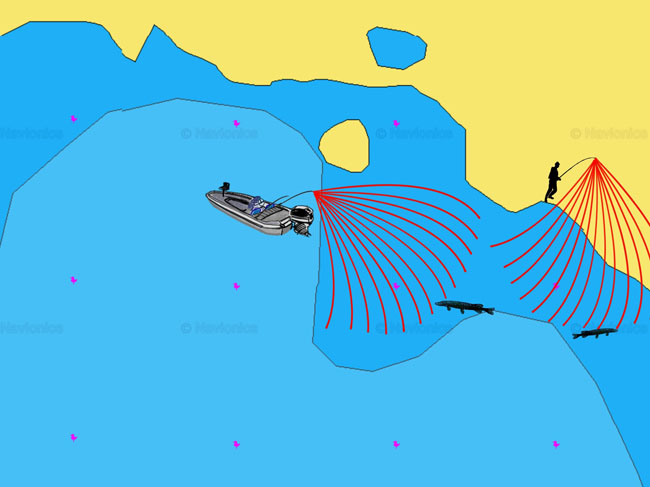
The best chances of success are offered by a strategic casting of the fishing area. Start at twelve o’clock and work your way clockwise – cast after cast. Since we don’t know the depth of the pike, the choice of bait is not always easy.
Strategic fishing is a little more demanding, but the result is a higher success rate. Because this is the way we reach the most pike with our lure. If you pursue lurking pike with many casts, you will also encounter specimens that are actively hunting.
2.2 How does the pike hunt?
The pike is considered a fast predator that greedily pounces on its prey.
- But how aggressive is it really?
- How long should we therefore wait in the same spot?
You cast your lure and crank it in with more or less variety. The goal is always the same – you expect the crack in the line. And after the shortest possible time.
The hunting behaviour of the pike has been studied in various experiments. One of them dealt with the hunting of roach. The scientists wanted to find out two things.
- Which hunting strategies the pike uses
- and how the roach react when attacked.
To do this, wild pike and roach were caught and released together in a basin in an experimental arrangement. Always one pike together with several roach.
-

Finding Fish The Smart Way – The Pike
Download 40 pages now for free
This article is an excerpt from:
Reviews ( 64 )
Martin
Hi Garry, i saw that contacting Jens has solved your problem. As written in the Order Mail, download is limited to 3 times. We introduced the limit to prevent fraud. However, if you lose your eBook in the future, please email us and you will of course get new downloads. Martin- Rated 1 out of 5
Garry Gregg
I bought the book online, but try as I might it would not save on my iPad mini 3, from the small amount i was able to read it looked very good. I was given a link that was promised to ALWAYS be available to me, but this was not the case! I wanted to learn how to find Pike in Lough Neagh, the largest lake in the U.K. but I can only fish it blind, useless. Make sure you can save this book BEFORE you buy. - Rated 5 out of 5
Andreas Eden
Unlike other reviewers, I am NOT in favor of shortening or streamlining. The detailed but not generalized aspects provided are scientifically sound and outline the respective topics exceedingly well. Looking forward to more of this, and keep up the great work! Martin
Hi Claus, Thank you for the info about the Tolino. So far, there have been no problems with the popular Android or Apple smartphones and tablets. We’ll take a look at it. Did the upload via the Tolino web reader not work either? Regards Martin- Rated 2 out of 5
Claus Erhard
The content is decent – maybe a little too detailed. Note: I bought the e-book version. The fact that you can’t print it out is alright (this option would be great though). However, I cannot read the PDF file on my Tolino. I uploaded it 1000 times, and nothing is displayed. So reading is only possible on the PC. Too bad! - Rated 5 out of 5
Dieter Gundacker
Highly recommended, lots of fascinating information. It is not easy to put the book down once you have started reading. - Rated 5 out of 5
Kurt Sattler
Great book. I also have “The Pikeperch”. Both are highly recommended. - Rated 5 out of 5
Mirko
A very well written book. - Rated 4 out of 5
Holzblinker
Among the advantages: -statistics and their interpretation -written in a simple and understandable way Among the disadvantages: -advertising -A lot of generally known information - Rated 3 out of 5
Bruno
Exciting content (****) with a tendency to be long-winded (**) - Rated 5 out of 5
Stefan
The book keeps what it promises. An all-around great book that stands out from the rest. The purchase was worth it! - Rated 5 out of 5
Fischfreund
A truly superb book. I also own the book on pikeperch and have to admit that they are two completely different books. There are very few overlaps, so I never had the feeling that I already knew a passage in the book. For this reason, I can unreservedly recommend the pike book. It was so much fun reading it and gradually learning more about the pike. - Rated 5 out of 5
Paul KraUS
An elaborate approach to the behavior of the fish to conclude your fishing behavior, etc. I also like that other professional opinions are taken into account and partly questioned and analyzed. You can learn a lot to save the one or the other unsuccessful day. Thank you! - Rated 5 out of 5
barney1at
I am impressed with the book! I have read many books about fishing, and this was by far the best. It reflects not only the experiences and interpretations of the authors but uses scientific studies as a basis. Some of the findings knocked my socks off, e.g., the distance of attention of the pike. Strong recommendation for anyone who wants to improve their pike fishing skills! - Rated 5 out of 5
Michael Hügel
Sehr gutes Buch hat mir weitergeholfen das Leben des Hechtes zu verstehen. - Rated 5 out of 5
frankadam67
Sehr, sehr schönes Buch mit vielen Informationen! Nun muss ich nur noch alles in die Tat umsetzen! Danke für das gut ausgearbeitete Buch! - Rated 5 out of 5
Thomas Asamer
Bin gerade am Lesen des Buches. Sehr interessant und informativ. Werde meine Hechtfänge sicherlich noch um einiges steigern können mit dem KnowHow des Buches! Weiter so!? - Rated 5 out of 5
Andre Scholz
Hallo Zusammen, ich kann nur sagen, das habt ihr wirklich sehr gut gemacht! Wahnsinnig informativ, Super gegliedert und mit vielen guten Tipps behaftet. Das Zanderbuch war schon ein Knaller!!! Ich freu mich schon auf das Barschbuch. Und nebenbei erwähnt, die Videolektionen Köderkurs 1 sind ebenfalls Mega spannend! Bitte weiter so machen…. Petri Andre - Rated 5 out of 5
Manfred Parbs
Ich finde die Bücher ” Der Hecht ” sowie ” Der Zander ” sind für erfahrene Angler und auch für den Anfänger sehr lehrreich und somit auch informativ gestaltet. Auch die vielen Tips haben mich persönlich schon so manches mal vor einem Schneidertag bewahrt. Ich besitze zudem auch noch das Buch ” Der grosse Echolotratgeber ” . Dieses Buch liefert gute Erklärungen für die Funktionen und Einstellungen von Echoloten. Desweiteren besitze ich auch noch zwei Angelkurse: zum einen Köderfarbe und zum anderen Der Deeper. Beide Kurse sind mit sehr viel Informationen und verständlichen Erklärungen gespickt die jederman sehr gut verstehen kann. Freue mich schon auf weitere Bücher. Ein grosser Dank als auch ein grosses Lob an das Fischfinderteam. Petri Heil & immer dicke Fische Manfred Parbs - Rated 4 out of 5
Fabius Voigt
Klasse Buch! Fundiertes Wissen auf gute Art und Weise zusammengefasst und übermittelt, damit Angler ihren Zielfisch besser verstehen. An einigen Ecken im Buch, wäre ein weitere genauere Ausarbeitung toll gewesen (wurde vom Autor aber selbst bemerkt und begründet). Desweiteren beruhen die meisten Angaben (90%) von Hechten aus Seen und leider nur sehr wenig aus Flüssen. Das sind meiner Meinung nach die einzigen Sachen die fehlen, aber ansonsten würde ich es als Bereicherung für jeden Angler beschreiben! - Rated 5 out of 5
Julia
Genau wie das Zanderbuch wieder der totale Hammer! Wobei für mich die Voraussetzungen etwas anders waren: Während ich meine Zanderfänge wirklich mal dringend etwas ankurbeln musste, fing ich alleine im vorigen Jahr 47 Hechte, es ging hier also eher um Optimierung. Und das ist voll gelungen! Massen von überaus hilfreichen Forschungsergebnissen, Statistiken und Tafeln. Ich bin beim Spinnangeln bisher zu viel gewandert und habe die einzelnen Spots zu kurz beangelt, das weiß ich jetzt. Und so ganz nebenbei ist mir jetzt noch klar, weshalb man in einigen durchaus interessanten Seen in meiner Umgebung von Juni bis Januar partout keinen Fisch fängt. Habe nämlich so einiges über die Schichtung gelernt, und dass eine Abkühlung eben nicht automatisch gleich Verbesserung bedeutet. Klasse! Her mit dem nächsten Buch bitte! - Rated 5 out of 5
Pascal Schlenker
Top nicht das letzte Buch für mich…. - Rated 5 out of 5
Heinz-Otto Schoel
Auf den 50zig Seiten, die ich bis jetzt gelesen habe ,bin ich begeistert. Aber die anderen Bücher über das Echolot und dem Zander waren sehr lehrreich. Weiter so. Freue mich schon auf das Barschbuch. - Rated 5 out of 5
Andreas Hillers
Modernes Fischen – Der Hecht. Ein sehr gut geschriebenes Buch. Bin begeistert von den vielen tollen Hilfestellungen. Sogar als erfahrener Angler kann hier bestimmt jeder noch den ein oder anderen Tipp für sich nutzen. Vielen lieben Dank, und weiter so für vielleicht weitere noch nicht erschienene Bücher über den Aal, Barsch, Karpfen etc. - Rated 5 out of 5
Stephandargel
Das Buch ist einfach nur klasse super beschrieben sehr verständlich beschrieben kann ich nur weiter empfehlen ? gebe dem Buch und dem Autor ne 1+ - Rated 5 out of 5
Rolf Wilde
Sehr praxisnah und auch mit viel Hintergrundinformationen gefülltes Buch. Ich habe über die Feiertage die ersten Seiten verschlungen. Sehr viele Details die ich noch bis zur Schonzeit versuche umzusetzen. - Rated 5 out of 5
Blankmaster
Die Referenz. Umfassend, kein blabla, über den Tellerrand hinausschauend, fundiert, sinnvolle und gut gemachte Graphiken, und das Ganze zu allem Überfluss auch noch unterhaltsam geschrieben. Als bekennender Wenigleser habe ich das Buch innerhalb von 3 Tagen einmal komplett durchgelesen. Uneingeschränkte Kaufempfehlung. - Rated 5 out of 5
Rudolf Knopf
Endlich ein Buch, welches man durchaus als Fachliteratur beschreiben kann. Es werden viele Erfahrungen, welche ich beim meiner Suche nach dem Hecht gemacht habe, bestätigt. Ebenso ist auch sehr viel Neues für mich in dem Buch, was ich bisher in meiner vieljährigen Anglerlaufbahn so nicht gewust habe. Absolute Kaufempfehlung. - Rated 5 out of 5
markus s
Großes Kompliment zum Buch! Ich fische seit meiner Kindheit auf Hecht (und das sind schon mehr als dreißig Jahre) und ich muss sagen, es gibt keine interessantere Lektüre zum Hecht! Viele eigene Theorien finde ich hier bestätigt, aber noch besser: Dieses Buch bietet auch wirklich neue Ansätze! - Rated 5 out of 5
Mitja
Beeindruckende Leistung von Euch, ein so komplexes Thema derart runterzubrechen, daß man das Buch in einem Rutsch durchlesen kann, ohne sich dauernd zu fragen: „verdammt, wovon labern die denn da?“ Superspannend: die Trophieklassifizierung und die Sache mit der Sprungschicht! Ich sehe meine Gewässer jetzt mit ganz anderen Augen und auf einmal kommen mir die 150 Kracher für das Anaconda-GTM gar nicht mehr so übertrieben teuer vor! Und weil es mir so gut gefallen hat, zieh ich mir morgen direkt das Echolot-Buch rein, das mit der Postbote heute morgen in den Kasten geworfen hat….für das Barschbuch hätte ich übrigens gerne einen Gutscheincode 🙂 Danke! Ich freu mich auf weitere spannende Lektüre aus eurem Stall… - Rated 5 out of 5
schoenfeld.oli
Absolut feine Lektüre. Ich gehe nach Lesen des Buches ganz anders ans Wasser. Zwischendrin etwas fader Stoff, der aber einfach dazu gehört. Dafür sind die spannenden Themen so spannend, dass ich nicht im Sitzen lesen konnte. - Rated 5 out of 5
Robert Häusler
Die beiden Autoren Martin Jacobs und Jens Biegemeier sind der Hammer. Ich habe schon viel gut recherchierte Medizinbücher gelesen und oft haben sie mir zu mehr Erfolg verholfen, dass das auch mal Zum Hechtangeln möglich wird ist großartig. Danke an dieses Meisterwerk! Ich habe mit dem Wissen aus dem Buch jetzt schon meinen Angelrekord auf Hecht gebrochen und bin mir sicher da geht noch was. Danke für eure Arbeit, den Fleiß und die Begeisterung die ihr geleistet haben müsst dieses moderne Fische finden für uns und unsrer Seekrokodiele zu ermöglichen. Petri Robert Häusler Martin
Edi, wir danken Dir und wünschen euch gute Fänge. Petri Martin vom Fischfindertestteam- Rated 5 out of 5
Edi Brader
Das beste Buch über die Fischerei auf Hecht, das ich bisher in Händen gehalten habe! Sehr ausführlich und praxisnah wird dem Einsteiger in diese Fischerei veranschaulicht worauf es ankommt und auch der eingefleischte Hechtprofi kann noch sehr viel Nützliches aus diesem Buch herausholen! Absolut EMPFEHLENSWERT! Besonders möchte ich das äußerst nette Team loben! Bei meiner Bestellung ging etwas schief, ich bekam zwei anstatt nur einer Ausgabe. Nach Rücksprache bedankten sie sich für die Information und sagten mir, dass das Zurücksenden ohnehin zu teuer wäre und ich das zweite Exemplar auch behalten dürfte. Danke Jungs, ihr habt gerade einem befreundeten Jungangler eine große Freude gemacht, ich werde euch auf jeden Fall weiterempfehlen! Macht weiter so! Petri Heil Edi Brader - Rated 5 out of 5
lusox
Prima Lektüre , wirklich zu empfehlen ! Besonders gut fand ich das Kapitel mit der Ködergröße. Ebenso das Kapitel mit den Standplätzen und die Rolle der Vegetation Ich habe viele Anregungen daraus mitgenommen und bin mal gespannt wie sich meine Hechtfänge verbessern. Weiter so ! - Rated 5 out of 5
Stefan Fischer
Ich finde, das Buch “Der Hecht” lüftete viele Geheminisse. Hatte das Buch “Der Zander” auch, alles top tock. Hoffentlich folgt das Buch auch über den Barsch, evtl. Waller/Wels. Mir fehlt die Anglerpraxis. Das Buch “Das große Echolot” ist auch klasse. Weiter studieren!!! ^^ Namaste und Petri Fischer Stefan - Rated 5 out of 5
Lasse Wiedenhöft
Wie schon beim Zanderbuch werden für alle denkbaren Situationen (Jahreszeiten, Gewässer, Wetter etc.) hilfreiche Tipps zur Strategieverbesserung gegeben. Dabei helfen die Ergebnisse aus diversen Versuchen und Tests den Hecht und sein Verhalten besser zu verstehen. Gerade die wissenschaftliche Begleitung in Kombination mit eigenen Erfahrungen hat mir schon nach wenigen Kapiteln neue Ideen vermittelt! - Rated 5 out of 5
Johann Burgstaller
Wie bereits “Der Zander”, ist auch die Hechtausgabe wieder jeden Cent wert. Ein must-have für jeden Raubfischangler. Tolle Studien, jede Menge neue Erkenntnisse und enifach zu lesen. Na dann nichts wie auf zum “Der Barsch”! - Rated 5 out of 5
Barschhunter
Das Buch ist Euch wirklich super gelungen!!!!! Es ist sehr informativ und es ist für jeden etwas dabei, ob man nun Anfänger im Angeln ist oder ein erfahrener Angler ist. Man kann immer noch was dazu lernen. Für mich persönlich war das Kapitel “Jagd und Beute” sehr interessant und spannend und möchte deswegen keine einzelnen Punkt hervorheben. Macht weiter so und ich freue mich schon auf Euer nächstes Buch “Modernes Fische Finden Der Barsch” mein persölicher favorite Fisch. Dickes Petrie Barschhunter - Rated 5 out of 5
Andre Scholz
Genauso spannend und aufschlussreich wie das Zander Buch! Wenn man seinen Zielfisch besser verstehen möchte und mehr Erfolg haben will, kommt man nicht um das Buch herum! Allein die Thematik um die Wassertemperaturen, einfach irre! Volle 5 Sterne und Danke für so viel geilen Input! Petri Andre - Rated 5 out of 5
Andreas F.
Sehr schön finde ich die Aufmachung des Buches und die logisch aufbauenden Kapitel. Das Lesen macht viel Spaß. Hier treffen die Autoren genau den richtigen Ton, einen “mitzunehmen”, obwohl die Grundlagen ja wissenschaftlich/biologisch sind. Es ist nicht einfach, plausibel und allgemein verständlich, verschiedene wissenschaftliche Erkenntnisse miteinander zu verknüpfen und hieraus die passenden Schlussfolgerungen zu ziehen. Das ist jedoch durchaus gelungen. Abläufe in der Natur sind nie statisch sondern unterliegen Abweichungen, es gibt aber Tendenzen. Deshalb kann es nicht immer genaue Gesetzmäßigkeiten geben. Hierauf weist das Buch in verschiedenen Kapitel immer wieder hin. Hier hätte ein grundlegender Hinweis in der Einleitung m.e. jedoch ausgereicht. Randnotiz: Ein Absatz erscheint wortgleich an zwei Stellen (S. 11, 1.Abs. und S. 15 3. Abs.). Im Ergebnis ist es ein Buch, was sogar enthusiastischen Raubfischanglern richtig weiterhilft! Meine Erwartungshaltung wurde sogar übertroffen. Ich freue mich auf euer Barschbuch! Vielen Dank! - Rated 5 out of 5
Pascal Kreutzmann
Wie die beiden Bücher zuvor hat mich auch das Buch über den Hecht mal wieder total begeistert. Unglaublich was ihr für einen Aufwand betreiben müsst um all dieses Wissen und die Studien zusammen zu tragen. Besonders interessant fand ich zb. die Frage danach wieviele Hechte sich denn in so einem Gewässer aufhalten. An wievielen Fischen man vorbei angelt. Das war echt interessant. Ebenso die Standplätze der Fische zu den verschiedenen Jahreszeiten und wie sehr vieles von der Wassertemperatur abhängt finde ich sehr Aufschlussreich. Auch über das fressen und gefressen werden kann man einiges erfahren. Jetzt ist mir klar warum der Hecht die Beute am liebsten am Kopf packt und sie möglichst schnell verschlingen muss. Tja die Themenvielfalt ist echt groß. Was mich noch interessiert hätte….wie/was sieht der Hecht durch seine Augen ? Was für Farben nimmt er wahr etc ? Aber das wäre eventuell zu speziell ?! Freue mich auf das nächste Buch! Bloß nicht nachlassen und genauso ausführlich weiter machen. Danke dafür. Ps…ich rezensiere aus Überzeugung , nicht wegen einem Gummifisch ! Grüße und Petri Pascal - Rated 5 out of 5
Ralf B.
Genauso interessant und prall gefüllt mit wertvollen Infos wie das Zanderbuch, einfach TOP! - Rated 5 out of 5
Bickes
Sehr gut strukuriert, sehr informativ, mir hat es definitiv geholfen, meine Taktik zu verbessern und selbstbewusster meine Stellen auszuwählen. - Rated 5 out of 5
opto
Habe alle 3 Bücher! Bin begeistert und dankbar!! Interessieren würde mich warum gerade der Hecht an einem Tag wie verrückt beißt und am nächsten Tag bei absolut gleichen Bedingungen am selben Ort wie ausgestorben erscheint! Interessieren würde mich auch wie der Zander als Augentier mit Sichtigkeiten unter 5cm klarkommt! (Hochwasser) Diese Fragen beschäftigen mich schon ein ganzes Anglerleben. - Rated 5 out of 5
Adrian Drzezla
Das Buch hat sehr viele Informationen über unseren Esox Lucius;). Jedes Kapitel ist sehr spannend und reichhaltig an Informationen. Nach diesem Buch habe ich meine Angelstrategie verbessern können und ich habe nun eine andere Ansicht von unserem Hecht im Wasser bekomme. Petri ! „ sehr empfehlenswert , Genau so wie die letzten Bücher von Fischfindertest“ - Rated 5 out of 5
Evgenij
Suuuper Buch, genau so wie das Zander Buch. Bin total begeistert. Sieht wie eine Doktorarbeit aus. Wissenschaftlich überprüft mit Verweisen, vielen Abbildungen und vielen praktischen Tips. Freue mich auf die neue Bücher! - Rated 5 out of 5
Daniel
Ich kann das Buch jedem Raubfischangler weiterempfehlen. Viele neue und nützliche Informationen rund um unseren Zielfisch Nr. 1. Tolle Arbeit! - Rated 5 out of 5
Jörg
Tolles Buch, hochinformativ von der ersten bis zur letzten Seite. Das Jahr des Hecht hat mir am besten gefallen. Man kann das Buch nur weiterempfehlen! - Rated 5 out of 5
Dirk Lindner
Top buch.umfangreich.logisch.sollte jeder haben.das Zander buch habe ich auch - Rated 5 out of 5
Jörg Thielke
Hoch interessant und verständlich geschrieben. In jedem Fall vollumfänglich weiterzuempfehlen. Danke Männers ? - Rated 5 out of 5
Stefan Klingbeil
Es war nicht anders zu erwarten. Nach dem Zander Buch bin ich wieder voll zufrieden.Die Bücher unterscheiden sich von anderen Büchern und Artikeln aus Zeitschriften. Mehr input brauch ich nicht. Alles erklärt und vernünftig erklärt. Ich lese wirklich nicht gerne Bücher. Aber hier ist es wie ein guter Krimi. Man kann nicht aufhören. Wir haben es alle gelesen und Diskutieren unser Wissen zusammen um es nochmal zu vertiefen. Jetzt freuen wir uns auf Der Barsch ? - Rated 5 out of 5
Jörg Rolle
Ein sehr gutes Buch so wie ich es erwartet habe nach dem ich Euer Zander-Buch gelesen habe. bin begeistert viele Tipps in Jagd und Beute,Umweltfaktoren,Lebensräume Kapitel 5.2.2 und Das Jahr des Hechtes.Habe noch nicht viel Erfahrung Hecht angeln ,das Buch hat mir viel Wissen übermittelt auch wenn ich noch nicht alles gelesen habe. Danke weiter so Petri - Rated 5 out of 5
Philipp
Kurz und knapp, Top! Wie auch bereits im Buch “Modernes Fische finden Der Zander” erneut abgeliefert. Besten Dank, macht weiter so! - Rated 5 out of 5
Ben
Glaube ich hab gerade vergessen die Sterne zu drücken! Auf jeden Fall 5 Sterne da es super verständlich geschrieben ist! Es beschreibt das Verhalten der Fische in verschiedenen Situationen und wenn man das versteht und nutzt fängt man sicher bald besser! Auch die Grafiken und Bilder vereinfachen es sehr gut. Bin sehr zufrieden und hoffe das noch eins für Barsche und Wels kommt! ?? - Rated 5 out of 5
Nico Drabner
Volle Punktzahl ?? Ein dickes Lob. Sehr schön aufgebaut. Am besten hat mir die Gewässeranalyse und die Aussage mit der Wassertemperatur gefallen, das passt zu 100% und Danke an den vielen nützlichen Tipps - Rated 5 out of 5
Kuhnert Giso
Also ich habe schon das Buch vom Zander gelesen. Und auch dieses Buch vom Hecht ist sehr Lehrreich mit vielen interessanten Kapiteln.. Ich bin noch nicht ganz durch mit dem lesen, aber ich weiß das es toll ist und mir auf alle Fälle weiter helfen wird um den ein oder anderen Hecht mehr an den Haken zu bekommen. Ich empfehle es auf alle Fälle weiter.. Und auch das nächste Buch über den Barsch werde ich mir holen. Macht weiter so fünf Sterne gibt’s vom mir. LG Giso - Rated 5 out of 5
David Götze
Hallo zusammen, ich habe mittlerweile alle 3 Bücher und kann ehrlich behaupten, dass es mir beim Angeln bzw. Fische finden sehr viel gebracht hat. Vorallem das Angeln unter Einfluss der Mitwelt (Wind, Temperatur…etc) lässt mich jetzt meine Spotwahl genauer überdenken. Vielen Dank dafür und ich freu mich schon auf den Barsch ^^ Petri David - Rated 4 out of 5
Peter
absolute Empfehlung - Rated 5 out of 5
Ben
Finde das Buch sehr gut! Genau wie das Zander Buch beschreibt es worauf es ankommt… das Verhalten der Fische in verschiedenen Situationen. Es ist verständlich erklärt und die Bilder und Grafiken machen es noch einfacher zu verstehen worauf es ankommt! Weiter so! Barsch und Wels können kommen? - Rated 5 out of 5
Kantor Alfred (Hatschi)
Ich habe viele Jahre viel Zeit verschwendet weil ich den Fisch nicht immer gefunden habe, dass Buch hilft wirklich die Fische zu finden. Ich habe es nicht nur gelesen sondern auch schon teilweise am Wochenende umgesetzt und das mit Erfolg (einige schöne Hechte), vielen dank ich freue mich auf euer nächstes Werk Der Barsch. Weiter so!!! Petri Heil Hatschi - Rated 5 out of 5
Patrick
Also ich muss jetzt mal eine Lanze brechen, es gibt doch noch qualitativ hochwertige Bücher zum Thema Fisch und dann noch direkt zum Thema Hecht, in einer Qualität die ihres gleichen sucht. Selten das ich derart im „Rausch“ ein Buch gelesen habe. Hut ab und weiter so. - Rated 5 out of 5
Tacklefever
Ich war sehr positiv überrascht. Der Anfänger erhält im ersten Teil des Buches wirklich brauchbares Basiswissen vermittelt. Und der ein oder andere Profi wird vielleicht sagen: “Mache ich doch immer so”. Und das ist doch das beste Lob für den ersten Teil des Buches. Aber wenn der Profi ehrlich ist, kann er wahrscheinlich schon zugeben, das ein oder andere gefunden zu haben was er vergessen hatte oder doch noch nicht wusste. Und richtig spannend für Anfänger und Profi ist der Hautteil des Buches, das Kapitel “Jahr des Hechtes”. Dieser Teil hat absolut zu Recht den meisten Platz im Buch bekommen. Bei den einfach gegliederten und nachvollziehbaren Abschnitten im Jahr des Hechtes findet sicher nicht nur der Anfänger sondern auch der Profi jede Menge tolle Infos. Meine volle Buchbesprechung findet ihr unter https://www.tacklefever.de/index.php?topic=7396.0 - Rated 5 out of 5
Andreas
Wie erwartet, ein sehr gutes Buch das nicht in dem Köderwahnsinn hinterherläuft. Besonders gut gefällt mir die Analyse der Wassertemperaturbereiche passend für meine großen See in Mecklenburg. Die Gewässeranalysen passen wie die Faust auf Auge auf dieses sehr große Gewässer. Die neuen Möglichkeiten und überragenden Fänge von einigen lokalen Guides erzielt werden, welche in Großen Teilen durch die gewaltigen Technologiesprünge im Echolotbereich und Bootsnavigation begründet sind, wurde hier sehr gut zusammengefasst. Eine Pflichtlektüre für jeden der sich an die großen Gewässer mit den noch größeren Fische wagen will. Definitiv 5 Sterne, das Buch wurde auch innerhalb von 2 Nachmittagen gelesen. Danke! - Rated 5 out of 5
Wolfgang Konter
Habe das Buch heute bekommen .Dafür erstmal ein großes Danke schön an Euch . Nach dem ersten Durchblättern war ich begeistert . Habe eigentlich auch nichts anderes erwartet . “Modernes Fische finden – Der Zander” habe ich ja schon lange durch und blättere immer wieder drin rum . Beide Bücher zeugen von viel Sachverstand und Erkenntnissen , die ich so nicht erwartet hätte . Einfach super und verständlich erklärt . Jetzt will ich nur hoffen , dass noch ein Barsch Buch auf dieses Duo folgt . Petri Heil Wolfgang Konter - Rated 5 out of 5
Catchmaster
Habe das Buch heute direkt durchgelesen. Es ist gut aufgebaut und es gibt viele nützliche Tip’s. Anfang Mai waren wir in Schweden auf Hecht angeln. Schade, dass ich dieses Buch nicht schon vorher hatte. Aufgrund der neuen Erkenntnis hätte ich bestimmt mehr Erfolg gehabt. An sich ein super Buch. Werde jetz die Tip’s in die Praxis umsetzen. Vielen Dank für dieses Buch. - Rated 5 out of 5
Jörg Rolle
Habe das Buch Heute erhalten und sofort durchgestöbert,bin Begeistert! Sehr schöne Aufmachung, gut Gegliedert und nicht zu wissenschaftlich so das es jeder Angler verstehen kann.Habe auch schon Kapitel gefunden die mir reichlich neues und gute Tipps für meine Angelpraxis gefunden. Weiter so!!!!!!! Petri Jörg Rolle
The entire course of the hunt was recorded on video and subsequently evaluated. In particular, the researchers were interested in the following aspects:
- The number of attacks,
- Type of attack (ambush with flash attack or pursuit),
- Ratio of successful to unsuccessful attacks,
- Number of roach captured,
- Time until the pike becomes active,
- Time from activation to attack.
Now things get exciting. Almost all the pike swam motionless near the bottom or hid (hiding places were available) in the 20°C warm pools. And most of the specimens remained in these positions even when the prey was placed in the pool.
In 35 trials, there were only 166 attacks. Of these, 25 (i.e. just under 15 %) were successful. The number of prey fish in the pool did not play a major role. Neither for the number of attacks nor for their success.
On the one hand, pike are ambush hunters. On the other hand, they also pursue their prey. In the experiment they used both hunting strategies.
Before the first attack on the roach, in most of the cases they either laid in ambush in the prepared hiding place (2 wooden beams). Or they remained motionless in a position near the bottom.
It can be assumed that the hiding place (2 wooden beams) may not have provided a perceived advantage for possible attacks. In the end, however, they were very successful from the lying-in-place position, catching 17 of a total of 25 roach.
If an attack missed, the prey was pursued in over half of all cases. However, the pike did much worse in this type of attack.
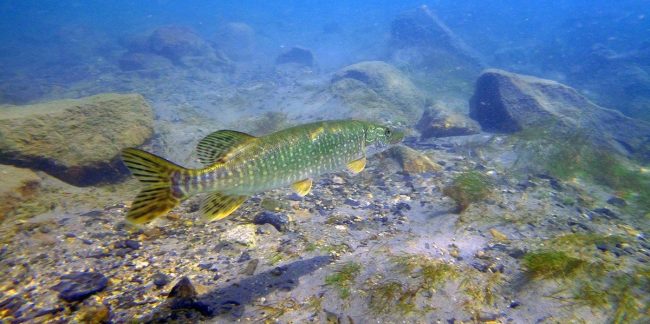
So the pike does not seem to approach feeding quite as euphorically as it is often assumed. Considering all the trials in this study, the pike took quite a long time to attack from the moment onwards when the prey fish were introduced.
On average, it took 8 minutes before they showed any movement or interest. That makes us think. The pike swim around in a very confined space together with their prey and then it takes so much time before they show interest and move for the first time? Wow …
We don’t even want to imagine how many lures swim past a pike like that, while it thinks to itself: “Hey … prey … looks interesting … oops, gone again.”
The attacks themselves then didn’t take so long. Within 2 minutes on average they were finished. So we come to a duration of 10 minutes from the first interest in the prey to the end of the first attack. 10 minutes is a damn long time for a supposedly so aggressive predator.
Note: If you believe these experiments, contrary to many opinions, the pike does not seem to be a predator that makes up its mind quickly and goes after its prey. It seems to take more time to attack than most lures remain in the water.
The pike is also an efficient predator. A fact that was proven in this experiment with a rate of around 15% successful attacks. Other studies even showed a success rate of up to 25 %.
This high success rate results from the fact that it very often hunts from a resting and waiting position. This allows him to first concentrate extensively on his prey in order to then attack it in a targeted and surprising manner.
His instincts nevertheless seem to need some time for this process. It is not surprising, because a lurking predator has time. He can wait for the right moment and for the right prey.
What can we conclude from these results?
For one thing, it seems to be important to keep your lure in the pike’s field of vision for as long as possible in order to attract their attention. The question is, how do you do that?
On the one hand, you could work on the retrieve speed of the lure and deliberately reduce it. In practice, many plugs, spoons and spinners are retrieved very quickly. Cautious and waiting pike might feel less attracted to them than impatient or aggressive specimens.
If you use heavy lures in shallow water, however, you will be forced to retrieve them quickly before they disappear into the weeds. Or rush towards the bottom. With a slightly sinking or floating lure you can extend the time. And baitfish is probably the best way to reach the 10-minute limit.
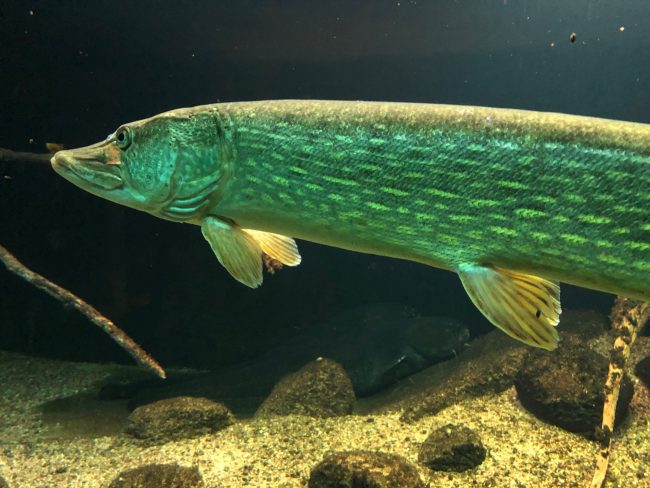
2.3 When does the pike go hunting?
Roach are the preferred prey of the pike in many waters. Its hunting strategy is therefore adapted to these. If you understand this strategy, you can also adapt your tactics (baiting) – and drastically increase your catches.
Before we get more specific, there are a few general things that apply to most roach.
- Roach have a slender body, which gives them speed.
- They flee quickly as soon as a predator gets too close.
In records, it has been observed that roach can cover a distance of 2 metres in one second from a resting state. That’s quite an achievement.
It’s hard to imagine how the big pike manages to accelerate its plump body at anywhere near that speed.
Bubbling at the surface: An unmistakable sign of an actively hunting pike
The defence strategy of roach against the attacks of a predator is often swarming. In doing so, they flee collectively towards the surface in the shore area. If a pike attacks the flock directly, it splits in two and immediately re-forms behind it.
The roach are so good at forming new shoals that only very few fish remain alone. The pike, however, lacks the element of surprise for the next attack. However, this does not stop some stubborn contemporaries from making a second attempt.
The water surface seems to exert a magical attraction on roach when they are in danger. They sometimes swim directly on the waterline of the surface. Exactly why this behaviour serves as a defence is still unexplored. It is suspected
- that the swimming speed can be increased even more if parts of the body protrude from the water.
- Or that predators avoid hunting close to the surface in order not to end up as prey themselves – for example of birds.
If the roach have no other means of escape, they sometimes even jump out of the water to escape their attackers. In experiments, several successive jumps could even be observed.
And another important thing: this jumping out of the water was not observed in the absence of a predator. So it only takes place when the roach are being chased. In this situation, we only see a bubbling – or the roach itself – on the surface. But not the attacker underneath.
If we are out on the water and spot roach seemingly leaping out of the water as if in a game, we now know what is really going on. We can safely assume that
- that there is a predator directly underneath that
- is also actively hunting.
These are the two factors we have been eagerly waiting for. We will hardly find a better indicator for a successful fishing day.
When we see this spectacle on the water’s surface, however, we have to be quick. It is the right time and the right place to cast our bait.
The predator is now close to the surface – and especially eager to bite. So our lure should imitate whitefish and be shallow to guide. We can also use whitefish poppers now.
How much time do we have? Not much!
We remember that the pike only preys on 1 – 3 fish before it stops feeding. However, it needs several attacks to do this, as not every one will be successful. We usually only have a few minutes before the chance will be over. As long as the surface is bubbling, however, the window is open.
2.4 What influence do visibility and water colour have on the hunting behaviour?
When the pike encounters the best hunting conditions depends above all on where it is hunting.
In polytrophic waters, visibility is often only a few centimetres. This low visibility reduces the probability of a successful hunt for the visual predator. So it can easily happen that it spends more energy on hunting than it takes in from the prey it catches.
The pike population can gradually decline in such waters if it is not artificially restocked. A good example is the Großer Müggelsee near Berlin, which has become increasingly turbid since the 1960s because of eutrophication.
Sewage and agriculture caused a high nutrient input, which in turn led to the complete extinction of the underwater vegetation. The water was so turbid for years that there was no clear water situation at all over the course of the year.
-

Finding Fish The Smart Way – The Pike
Learn the tricks of the pro
Reviews ( 64 )
Martin
Hi Garry, i saw that contacting Jens has solved your problem. As written in the Order Mail, download is limited to 3 times. We introduced the limit to prevent fraud. However, if you lose your eBook in the future, please email us and you will of course get new downloads. Martin- Rated 1 out of 5
Garry Gregg
I bought the book online, but try as I might it would not save on my iPad mini 3, from the small amount i was able to read it looked very good. I was given a link that was promised to ALWAYS be available to me, but this was not the case! I wanted to learn how to find Pike in Lough Neagh, the largest lake in the U.K. but I can only fish it blind, useless. Make sure you can save this book BEFORE you buy. - Rated 5 out of 5
Andreas Eden
Unlike other reviewers, I am NOT in favor of shortening or streamlining. The detailed but not generalized aspects provided are scientifically sound and outline the respective topics exceedingly well. Looking forward to more of this, and keep up the great work! Martin
Hi Claus, Thank you for the info about the Tolino. So far, there have been no problems with the popular Android or Apple smartphones and tablets. We’ll take a look at it. Did the upload via the Tolino web reader not work either? Regards Martin- Rated 2 out of 5
Claus Erhard
The content is decent – maybe a little too detailed. Note: I bought the e-book version. The fact that you can’t print it out is alright (this option would be great though). However, I cannot read the PDF file on my Tolino. I uploaded it 1000 times, and nothing is displayed. So reading is only possible on the PC. Too bad! - Rated 5 out of 5
Dieter Gundacker
Highly recommended, lots of fascinating information. It is not easy to put the book down once you have started reading. - Rated 5 out of 5
Kurt Sattler
Great book. I also have “The Pikeperch”. Both are highly recommended. - Rated 5 out of 5
Mirko
A very well written book. - Rated 4 out of 5
Holzblinker
Among the advantages: -statistics and their interpretation -written in a simple and understandable way Among the disadvantages: -advertising -A lot of generally known information - Rated 3 out of 5
Bruno
Exciting content (****) with a tendency to be long-winded (**) - Rated 5 out of 5
Stefan
The book keeps what it promises. An all-around great book that stands out from the rest. The purchase was worth it! - Rated 5 out of 5
Fischfreund
A truly superb book. I also own the book on pikeperch and have to admit that they are two completely different books. There are very few overlaps, so I never had the feeling that I already knew a passage in the book. For this reason, I can unreservedly recommend the pike book. It was so much fun reading it and gradually learning more about the pike. - Rated 5 out of 5
Paul KraUS
An elaborate approach to the behavior of the fish to conclude your fishing behavior, etc. I also like that other professional opinions are taken into account and partly questioned and analyzed. You can learn a lot to save the one or the other unsuccessful day. Thank you! - Rated 5 out of 5
barney1at
I am impressed with the book! I have read many books about fishing, and this was by far the best. It reflects not only the experiences and interpretations of the authors but uses scientific studies as a basis. Some of the findings knocked my socks off, e.g., the distance of attention of the pike. Strong recommendation for anyone who wants to improve their pike fishing skills! - Rated 5 out of 5
Michael Hügel
Sehr gutes Buch hat mir weitergeholfen das Leben des Hechtes zu verstehen. - Rated 5 out of 5
frankadam67
Sehr, sehr schönes Buch mit vielen Informationen! Nun muss ich nur noch alles in die Tat umsetzen! Danke für das gut ausgearbeitete Buch! - Rated 5 out of 5
Thomas Asamer
Bin gerade am Lesen des Buches. Sehr interessant und informativ. Werde meine Hechtfänge sicherlich noch um einiges steigern können mit dem KnowHow des Buches! Weiter so!? - Rated 5 out of 5
Andre Scholz
Hallo Zusammen, ich kann nur sagen, das habt ihr wirklich sehr gut gemacht! Wahnsinnig informativ, Super gegliedert und mit vielen guten Tipps behaftet. Das Zanderbuch war schon ein Knaller!!! Ich freu mich schon auf das Barschbuch. Und nebenbei erwähnt, die Videolektionen Köderkurs 1 sind ebenfalls Mega spannend! Bitte weiter so machen…. Petri Andre - Rated 5 out of 5
Manfred Parbs
Ich finde die Bücher ” Der Hecht ” sowie ” Der Zander ” sind für erfahrene Angler und auch für den Anfänger sehr lehrreich und somit auch informativ gestaltet. Auch die vielen Tips haben mich persönlich schon so manches mal vor einem Schneidertag bewahrt. Ich besitze zudem auch noch das Buch ” Der grosse Echolotratgeber ” . Dieses Buch liefert gute Erklärungen für die Funktionen und Einstellungen von Echoloten. Desweiteren besitze ich auch noch zwei Angelkurse: zum einen Köderfarbe und zum anderen Der Deeper. Beide Kurse sind mit sehr viel Informationen und verständlichen Erklärungen gespickt die jederman sehr gut verstehen kann. Freue mich schon auf weitere Bücher. Ein grosser Dank als auch ein grosses Lob an das Fischfinderteam. Petri Heil & immer dicke Fische Manfred Parbs - Rated 4 out of 5
Fabius Voigt
Klasse Buch! Fundiertes Wissen auf gute Art und Weise zusammengefasst und übermittelt, damit Angler ihren Zielfisch besser verstehen. An einigen Ecken im Buch, wäre ein weitere genauere Ausarbeitung toll gewesen (wurde vom Autor aber selbst bemerkt und begründet). Desweiteren beruhen die meisten Angaben (90%) von Hechten aus Seen und leider nur sehr wenig aus Flüssen. Das sind meiner Meinung nach die einzigen Sachen die fehlen, aber ansonsten würde ich es als Bereicherung für jeden Angler beschreiben! - Rated 5 out of 5
Julia
Genau wie das Zanderbuch wieder der totale Hammer! Wobei für mich die Voraussetzungen etwas anders waren: Während ich meine Zanderfänge wirklich mal dringend etwas ankurbeln musste, fing ich alleine im vorigen Jahr 47 Hechte, es ging hier also eher um Optimierung. Und das ist voll gelungen! Massen von überaus hilfreichen Forschungsergebnissen, Statistiken und Tafeln. Ich bin beim Spinnangeln bisher zu viel gewandert und habe die einzelnen Spots zu kurz beangelt, das weiß ich jetzt. Und so ganz nebenbei ist mir jetzt noch klar, weshalb man in einigen durchaus interessanten Seen in meiner Umgebung von Juni bis Januar partout keinen Fisch fängt. Habe nämlich so einiges über die Schichtung gelernt, und dass eine Abkühlung eben nicht automatisch gleich Verbesserung bedeutet. Klasse! Her mit dem nächsten Buch bitte! - Rated 5 out of 5
Pascal Schlenker
Top nicht das letzte Buch für mich…. - Rated 5 out of 5
Heinz-Otto Schoel
Auf den 50zig Seiten, die ich bis jetzt gelesen habe ,bin ich begeistert. Aber die anderen Bücher über das Echolot und dem Zander waren sehr lehrreich. Weiter so. Freue mich schon auf das Barschbuch. - Rated 5 out of 5
Andreas Hillers
Modernes Fischen – Der Hecht. Ein sehr gut geschriebenes Buch. Bin begeistert von den vielen tollen Hilfestellungen. Sogar als erfahrener Angler kann hier bestimmt jeder noch den ein oder anderen Tipp für sich nutzen. Vielen lieben Dank, und weiter so für vielleicht weitere noch nicht erschienene Bücher über den Aal, Barsch, Karpfen etc. - Rated 5 out of 5
Stephandargel
Das Buch ist einfach nur klasse super beschrieben sehr verständlich beschrieben kann ich nur weiter empfehlen ? gebe dem Buch und dem Autor ne 1+ - Rated 5 out of 5
Rolf Wilde
Sehr praxisnah und auch mit viel Hintergrundinformationen gefülltes Buch. Ich habe über die Feiertage die ersten Seiten verschlungen. Sehr viele Details die ich noch bis zur Schonzeit versuche umzusetzen. - Rated 5 out of 5
Blankmaster
Die Referenz. Umfassend, kein blabla, über den Tellerrand hinausschauend, fundiert, sinnvolle und gut gemachte Graphiken, und das Ganze zu allem Überfluss auch noch unterhaltsam geschrieben. Als bekennender Wenigleser habe ich das Buch innerhalb von 3 Tagen einmal komplett durchgelesen. Uneingeschränkte Kaufempfehlung. - Rated 5 out of 5
Rudolf Knopf
Endlich ein Buch, welches man durchaus als Fachliteratur beschreiben kann. Es werden viele Erfahrungen, welche ich beim meiner Suche nach dem Hecht gemacht habe, bestätigt. Ebenso ist auch sehr viel Neues für mich in dem Buch, was ich bisher in meiner vieljährigen Anglerlaufbahn so nicht gewust habe. Absolute Kaufempfehlung. - Rated 5 out of 5
markus s
Großes Kompliment zum Buch! Ich fische seit meiner Kindheit auf Hecht (und das sind schon mehr als dreißig Jahre) und ich muss sagen, es gibt keine interessantere Lektüre zum Hecht! Viele eigene Theorien finde ich hier bestätigt, aber noch besser: Dieses Buch bietet auch wirklich neue Ansätze! - Rated 5 out of 5
Mitja
Beeindruckende Leistung von Euch, ein so komplexes Thema derart runterzubrechen, daß man das Buch in einem Rutsch durchlesen kann, ohne sich dauernd zu fragen: „verdammt, wovon labern die denn da?“ Superspannend: die Trophieklassifizierung und die Sache mit der Sprungschicht! Ich sehe meine Gewässer jetzt mit ganz anderen Augen und auf einmal kommen mir die 150 Kracher für das Anaconda-GTM gar nicht mehr so übertrieben teuer vor! Und weil es mir so gut gefallen hat, zieh ich mir morgen direkt das Echolot-Buch rein, das mit der Postbote heute morgen in den Kasten geworfen hat….für das Barschbuch hätte ich übrigens gerne einen Gutscheincode 🙂 Danke! Ich freu mich auf weitere spannende Lektüre aus eurem Stall… - Rated 5 out of 5
schoenfeld.oli
Absolut feine Lektüre. Ich gehe nach Lesen des Buches ganz anders ans Wasser. Zwischendrin etwas fader Stoff, der aber einfach dazu gehört. Dafür sind die spannenden Themen so spannend, dass ich nicht im Sitzen lesen konnte. - Rated 5 out of 5
Robert Häusler
Die beiden Autoren Martin Jacobs und Jens Biegemeier sind der Hammer. Ich habe schon viel gut recherchierte Medizinbücher gelesen und oft haben sie mir zu mehr Erfolg verholfen, dass das auch mal Zum Hechtangeln möglich wird ist großartig. Danke an dieses Meisterwerk! Ich habe mit dem Wissen aus dem Buch jetzt schon meinen Angelrekord auf Hecht gebrochen und bin mir sicher da geht noch was. Danke für eure Arbeit, den Fleiß und die Begeisterung die ihr geleistet haben müsst dieses moderne Fische finden für uns und unsrer Seekrokodiele zu ermöglichen. Petri Robert Häusler Martin
Edi, wir danken Dir und wünschen euch gute Fänge. Petri Martin vom Fischfindertestteam- Rated 5 out of 5
Edi Brader
Das beste Buch über die Fischerei auf Hecht, das ich bisher in Händen gehalten habe! Sehr ausführlich und praxisnah wird dem Einsteiger in diese Fischerei veranschaulicht worauf es ankommt und auch der eingefleischte Hechtprofi kann noch sehr viel Nützliches aus diesem Buch herausholen! Absolut EMPFEHLENSWERT! Besonders möchte ich das äußerst nette Team loben! Bei meiner Bestellung ging etwas schief, ich bekam zwei anstatt nur einer Ausgabe. Nach Rücksprache bedankten sie sich für die Information und sagten mir, dass das Zurücksenden ohnehin zu teuer wäre und ich das zweite Exemplar auch behalten dürfte. Danke Jungs, ihr habt gerade einem befreundeten Jungangler eine große Freude gemacht, ich werde euch auf jeden Fall weiterempfehlen! Macht weiter so! Petri Heil Edi Brader - Rated 5 out of 5
lusox
Prima Lektüre , wirklich zu empfehlen ! Besonders gut fand ich das Kapitel mit der Ködergröße. Ebenso das Kapitel mit den Standplätzen und die Rolle der Vegetation Ich habe viele Anregungen daraus mitgenommen und bin mal gespannt wie sich meine Hechtfänge verbessern. Weiter so ! - Rated 5 out of 5
Stefan Fischer
Ich finde, das Buch “Der Hecht” lüftete viele Geheminisse. Hatte das Buch “Der Zander” auch, alles top tock. Hoffentlich folgt das Buch auch über den Barsch, evtl. Waller/Wels. Mir fehlt die Anglerpraxis. Das Buch “Das große Echolot” ist auch klasse. Weiter studieren!!! ^^ Namaste und Petri Fischer Stefan - Rated 5 out of 5
Lasse Wiedenhöft
Wie schon beim Zanderbuch werden für alle denkbaren Situationen (Jahreszeiten, Gewässer, Wetter etc.) hilfreiche Tipps zur Strategieverbesserung gegeben. Dabei helfen die Ergebnisse aus diversen Versuchen und Tests den Hecht und sein Verhalten besser zu verstehen. Gerade die wissenschaftliche Begleitung in Kombination mit eigenen Erfahrungen hat mir schon nach wenigen Kapiteln neue Ideen vermittelt! - Rated 5 out of 5
Johann Burgstaller
Wie bereits “Der Zander”, ist auch die Hechtausgabe wieder jeden Cent wert. Ein must-have für jeden Raubfischangler. Tolle Studien, jede Menge neue Erkenntnisse und enifach zu lesen. Na dann nichts wie auf zum “Der Barsch”! - Rated 5 out of 5
Barschhunter
Das Buch ist Euch wirklich super gelungen!!!!! Es ist sehr informativ und es ist für jeden etwas dabei, ob man nun Anfänger im Angeln ist oder ein erfahrener Angler ist. Man kann immer noch was dazu lernen. Für mich persönlich war das Kapitel “Jagd und Beute” sehr interessant und spannend und möchte deswegen keine einzelnen Punkt hervorheben. Macht weiter so und ich freue mich schon auf Euer nächstes Buch “Modernes Fische Finden Der Barsch” mein persölicher favorite Fisch. Dickes Petrie Barschhunter - Rated 5 out of 5
Andre Scholz
Genauso spannend und aufschlussreich wie das Zander Buch! Wenn man seinen Zielfisch besser verstehen möchte und mehr Erfolg haben will, kommt man nicht um das Buch herum! Allein die Thematik um die Wassertemperaturen, einfach irre! Volle 5 Sterne und Danke für so viel geilen Input! Petri Andre - Rated 5 out of 5
Andreas F.
Sehr schön finde ich die Aufmachung des Buches und die logisch aufbauenden Kapitel. Das Lesen macht viel Spaß. Hier treffen die Autoren genau den richtigen Ton, einen “mitzunehmen”, obwohl die Grundlagen ja wissenschaftlich/biologisch sind. Es ist nicht einfach, plausibel und allgemein verständlich, verschiedene wissenschaftliche Erkenntnisse miteinander zu verknüpfen und hieraus die passenden Schlussfolgerungen zu ziehen. Das ist jedoch durchaus gelungen. Abläufe in der Natur sind nie statisch sondern unterliegen Abweichungen, es gibt aber Tendenzen. Deshalb kann es nicht immer genaue Gesetzmäßigkeiten geben. Hierauf weist das Buch in verschiedenen Kapitel immer wieder hin. Hier hätte ein grundlegender Hinweis in der Einleitung m.e. jedoch ausgereicht. Randnotiz: Ein Absatz erscheint wortgleich an zwei Stellen (S. 11, 1.Abs. und S. 15 3. Abs.). Im Ergebnis ist es ein Buch, was sogar enthusiastischen Raubfischanglern richtig weiterhilft! Meine Erwartungshaltung wurde sogar übertroffen. Ich freue mich auf euer Barschbuch! Vielen Dank! - Rated 5 out of 5
Pascal Kreutzmann
Wie die beiden Bücher zuvor hat mich auch das Buch über den Hecht mal wieder total begeistert. Unglaublich was ihr für einen Aufwand betreiben müsst um all dieses Wissen und die Studien zusammen zu tragen. Besonders interessant fand ich zb. die Frage danach wieviele Hechte sich denn in so einem Gewässer aufhalten. An wievielen Fischen man vorbei angelt. Das war echt interessant. Ebenso die Standplätze der Fische zu den verschiedenen Jahreszeiten und wie sehr vieles von der Wassertemperatur abhängt finde ich sehr Aufschlussreich. Auch über das fressen und gefressen werden kann man einiges erfahren. Jetzt ist mir klar warum der Hecht die Beute am liebsten am Kopf packt und sie möglichst schnell verschlingen muss. Tja die Themenvielfalt ist echt groß. Was mich noch interessiert hätte….wie/was sieht der Hecht durch seine Augen ? Was für Farben nimmt er wahr etc ? Aber das wäre eventuell zu speziell ?! Freue mich auf das nächste Buch! Bloß nicht nachlassen und genauso ausführlich weiter machen. Danke dafür. Ps…ich rezensiere aus Überzeugung , nicht wegen einem Gummifisch ! Grüße und Petri Pascal - Rated 5 out of 5
Ralf B.
Genauso interessant und prall gefüllt mit wertvollen Infos wie das Zanderbuch, einfach TOP! - Rated 5 out of 5
Bickes
Sehr gut strukuriert, sehr informativ, mir hat es definitiv geholfen, meine Taktik zu verbessern und selbstbewusster meine Stellen auszuwählen. - Rated 5 out of 5
opto
Habe alle 3 Bücher! Bin begeistert und dankbar!! Interessieren würde mich warum gerade der Hecht an einem Tag wie verrückt beißt und am nächsten Tag bei absolut gleichen Bedingungen am selben Ort wie ausgestorben erscheint! Interessieren würde mich auch wie der Zander als Augentier mit Sichtigkeiten unter 5cm klarkommt! (Hochwasser) Diese Fragen beschäftigen mich schon ein ganzes Anglerleben. - Rated 5 out of 5
Adrian Drzezla
Das Buch hat sehr viele Informationen über unseren Esox Lucius;). Jedes Kapitel ist sehr spannend und reichhaltig an Informationen. Nach diesem Buch habe ich meine Angelstrategie verbessern können und ich habe nun eine andere Ansicht von unserem Hecht im Wasser bekomme. Petri ! „ sehr empfehlenswert , Genau so wie die letzten Bücher von Fischfindertest“ - Rated 5 out of 5
Evgenij
Suuuper Buch, genau so wie das Zander Buch. Bin total begeistert. Sieht wie eine Doktorarbeit aus. Wissenschaftlich überprüft mit Verweisen, vielen Abbildungen und vielen praktischen Tips. Freue mich auf die neue Bücher! - Rated 5 out of 5
Daniel
Ich kann das Buch jedem Raubfischangler weiterempfehlen. Viele neue und nützliche Informationen rund um unseren Zielfisch Nr. 1. Tolle Arbeit! - Rated 5 out of 5
Jörg
Tolles Buch, hochinformativ von der ersten bis zur letzten Seite. Das Jahr des Hecht hat mir am besten gefallen. Man kann das Buch nur weiterempfehlen! - Rated 5 out of 5
Dirk Lindner
Top buch.umfangreich.logisch.sollte jeder haben.das Zander buch habe ich auch - Rated 5 out of 5
Jörg Thielke
Hoch interessant und verständlich geschrieben. In jedem Fall vollumfänglich weiterzuempfehlen. Danke Männers ? - Rated 5 out of 5
Stefan Klingbeil
Es war nicht anders zu erwarten. Nach dem Zander Buch bin ich wieder voll zufrieden.Die Bücher unterscheiden sich von anderen Büchern und Artikeln aus Zeitschriften. Mehr input brauch ich nicht. Alles erklärt und vernünftig erklärt. Ich lese wirklich nicht gerne Bücher. Aber hier ist es wie ein guter Krimi. Man kann nicht aufhören. Wir haben es alle gelesen und Diskutieren unser Wissen zusammen um es nochmal zu vertiefen. Jetzt freuen wir uns auf Der Barsch ? - Rated 5 out of 5
Jörg Rolle
Ein sehr gutes Buch so wie ich es erwartet habe nach dem ich Euer Zander-Buch gelesen habe. bin begeistert viele Tipps in Jagd und Beute,Umweltfaktoren,Lebensräume Kapitel 5.2.2 und Das Jahr des Hechtes.Habe noch nicht viel Erfahrung Hecht angeln ,das Buch hat mir viel Wissen übermittelt auch wenn ich noch nicht alles gelesen habe. Danke weiter so Petri - Rated 5 out of 5
Philipp
Kurz und knapp, Top! Wie auch bereits im Buch “Modernes Fische finden Der Zander” erneut abgeliefert. Besten Dank, macht weiter so! - Rated 5 out of 5
Ben
Glaube ich hab gerade vergessen die Sterne zu drücken! Auf jeden Fall 5 Sterne da es super verständlich geschrieben ist! Es beschreibt das Verhalten der Fische in verschiedenen Situationen und wenn man das versteht und nutzt fängt man sicher bald besser! Auch die Grafiken und Bilder vereinfachen es sehr gut. Bin sehr zufrieden und hoffe das noch eins für Barsche und Wels kommt! ?? - Rated 5 out of 5
Nico Drabner
Volle Punktzahl ?? Ein dickes Lob. Sehr schön aufgebaut. Am besten hat mir die Gewässeranalyse und die Aussage mit der Wassertemperatur gefallen, das passt zu 100% und Danke an den vielen nützlichen Tipps - Rated 5 out of 5
Kuhnert Giso
Also ich habe schon das Buch vom Zander gelesen. Und auch dieses Buch vom Hecht ist sehr Lehrreich mit vielen interessanten Kapiteln.. Ich bin noch nicht ganz durch mit dem lesen, aber ich weiß das es toll ist und mir auf alle Fälle weiter helfen wird um den ein oder anderen Hecht mehr an den Haken zu bekommen. Ich empfehle es auf alle Fälle weiter.. Und auch das nächste Buch über den Barsch werde ich mir holen. Macht weiter so fünf Sterne gibt’s vom mir. LG Giso - Rated 5 out of 5
David Götze
Hallo zusammen, ich habe mittlerweile alle 3 Bücher und kann ehrlich behaupten, dass es mir beim Angeln bzw. Fische finden sehr viel gebracht hat. Vorallem das Angeln unter Einfluss der Mitwelt (Wind, Temperatur…etc) lässt mich jetzt meine Spotwahl genauer überdenken. Vielen Dank dafür und ich freu mich schon auf den Barsch ^^ Petri David - Rated 4 out of 5
Peter
absolute Empfehlung - Rated 5 out of 5
Ben
Finde das Buch sehr gut! Genau wie das Zander Buch beschreibt es worauf es ankommt… das Verhalten der Fische in verschiedenen Situationen. Es ist verständlich erklärt und die Bilder und Grafiken machen es noch einfacher zu verstehen worauf es ankommt! Weiter so! Barsch und Wels können kommen? - Rated 5 out of 5
Kantor Alfred (Hatschi)
Ich habe viele Jahre viel Zeit verschwendet weil ich den Fisch nicht immer gefunden habe, dass Buch hilft wirklich die Fische zu finden. Ich habe es nicht nur gelesen sondern auch schon teilweise am Wochenende umgesetzt und das mit Erfolg (einige schöne Hechte), vielen dank ich freue mich auf euer nächstes Werk Der Barsch. Weiter so!!! Petri Heil Hatschi - Rated 5 out of 5
Patrick
Also ich muss jetzt mal eine Lanze brechen, es gibt doch noch qualitativ hochwertige Bücher zum Thema Fisch und dann noch direkt zum Thema Hecht, in einer Qualität die ihres gleichen sucht. Selten das ich derart im „Rausch“ ein Buch gelesen habe. Hut ab und weiter so. - Rated 5 out of 5
Tacklefever
Ich war sehr positiv überrascht. Der Anfänger erhält im ersten Teil des Buches wirklich brauchbares Basiswissen vermittelt. Und der ein oder andere Profi wird vielleicht sagen: “Mache ich doch immer so”. Und das ist doch das beste Lob für den ersten Teil des Buches. Aber wenn der Profi ehrlich ist, kann er wahrscheinlich schon zugeben, das ein oder andere gefunden zu haben was er vergessen hatte oder doch noch nicht wusste. Und richtig spannend für Anfänger und Profi ist der Hautteil des Buches, das Kapitel “Jahr des Hechtes”. Dieser Teil hat absolut zu Recht den meisten Platz im Buch bekommen. Bei den einfach gegliederten und nachvollziehbaren Abschnitten im Jahr des Hechtes findet sicher nicht nur der Anfänger sondern auch der Profi jede Menge tolle Infos. Meine volle Buchbesprechung findet ihr unter https://www.tacklefever.de/index.php?topic=7396.0 - Rated 5 out of 5
Andreas
Wie erwartet, ein sehr gutes Buch das nicht in dem Köderwahnsinn hinterherläuft. Besonders gut gefällt mir die Analyse der Wassertemperaturbereiche passend für meine großen See in Mecklenburg. Die Gewässeranalysen passen wie die Faust auf Auge auf dieses sehr große Gewässer. Die neuen Möglichkeiten und überragenden Fänge von einigen lokalen Guides erzielt werden, welche in Großen Teilen durch die gewaltigen Technologiesprünge im Echolotbereich und Bootsnavigation begründet sind, wurde hier sehr gut zusammengefasst. Eine Pflichtlektüre für jeden der sich an die großen Gewässer mit den noch größeren Fische wagen will. Definitiv 5 Sterne, das Buch wurde auch innerhalb von 2 Nachmittagen gelesen. Danke! - Rated 5 out of 5
Wolfgang Konter
Habe das Buch heute bekommen .Dafür erstmal ein großes Danke schön an Euch . Nach dem ersten Durchblättern war ich begeistert . Habe eigentlich auch nichts anderes erwartet . “Modernes Fische finden – Der Zander” habe ich ja schon lange durch und blättere immer wieder drin rum . Beide Bücher zeugen von viel Sachverstand und Erkenntnissen , die ich so nicht erwartet hätte . Einfach super und verständlich erklärt . Jetzt will ich nur hoffen , dass noch ein Barsch Buch auf dieses Duo folgt . Petri Heil Wolfgang Konter - Rated 5 out of 5
Catchmaster
Habe das Buch heute direkt durchgelesen. Es ist gut aufgebaut und es gibt viele nützliche Tip’s. Anfang Mai waren wir in Schweden auf Hecht angeln. Schade, dass ich dieses Buch nicht schon vorher hatte. Aufgrund der neuen Erkenntnis hätte ich bestimmt mehr Erfolg gehabt. An sich ein super Buch. Werde jetz die Tip’s in die Praxis umsetzen. Vielen Dank für dieses Buch. - Rated 5 out of 5
Jörg Rolle
Habe das Buch Heute erhalten und sofort durchgestöbert,bin Begeistert! Sehr schöne Aufmachung, gut Gegliedert und nicht zu wissenschaftlich so das es jeder Angler verstehen kann.Habe auch schon Kapitel gefunden die mir reichlich neues und gute Tipps für meine Angelpraxis gefunden. Weiter so!!!!!!! Petri Jörg Rolle
Only since the end of the 1990s has there been a brief period of clear water again, which has allowed individual underwater plants to reclaim a small part of the lake. This subsequently led to the reintroduction of a small fish population.
If a water body is classified as meso- or oligotrophic, the visibility is more or less above 2 m. The pike is able to catch its prey in these waters. It can recognise its prey easily and at an early stage. Since successful hunting for the pike in many cases depends directly on visibility and its camouflage, it finds optimal hunting conditions in clear waters at dusk.
Camouflage through hiding is enhanced here, but its own visibility is still good enough for attacks at short range. Its instincts give it the decisive clues as to whether and when an attack or pursuit of the prey is worthwhile.
Learn more about pike fishing in a lake here.
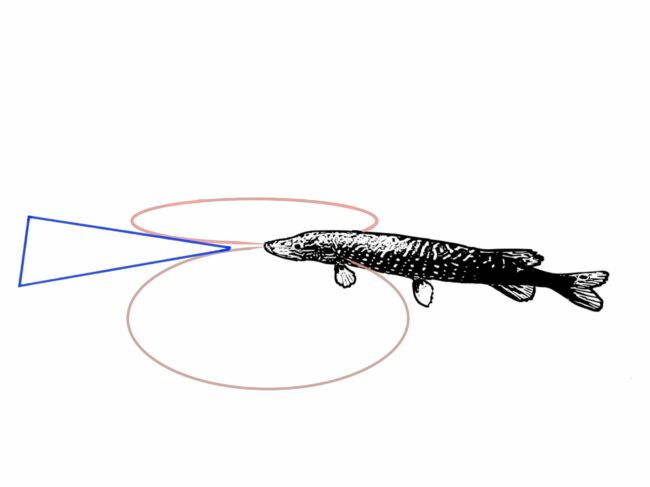
The hunt of the pike involves several steps. First of all, its attention must be aroused. Then the prey should be an easy target for it, so that it finally decides to attack.
What is the attention distance of a pike?
Basically, we distinguish between different distances that are important for us when fishing for pike. On the one hand, it is important when it becomes aware of our lures – that is, when it finally starts to react to a possible prey in its environment.
When it comes to the distance at which a pike first reacts, we can assume the following:
- At a visibility of less than one metre, this is always slightly above the respective visibility (example: visibility 60 cm | reaction to prey approx. 70 cm).
- At a visibility of more than one metre, it is always slightly below the respective visibility (example: visibility 2 metres | reaction to prey approx. 1.5 metres).
Note: The visibility has an influence on when the pike becomes interested in its prey. However, interest does not mean attack. Only when it sees a realistic chance of catching its prey will it initiate an attack.
Studies have shown that 1.5 metres seems to be the maximum distance at which any reaction to a possible meal occurs. At all distances above this, reactions by the predator to a potential prey are extremely rare.
For us, this means that we have to get damn close to the pike with our lure to get its attention. Depending on the type of typical prey, an even shorter distance is preferable.
Hotspots for pike fishing: How do I find the pike?
The underwater vegetation is the basis of life for pike. They need it to survive like they need oxygen to breathe.
A good stock of underwater plants is not simply crucial for a good and healthy pike population. In fact, without sufficient plant cover, there is no pike population at all.
From spawning onwards, which is deposited on underwater plants, vegetation forms the basis of life for the predatory fish. The young pike hide among the plants from predators and lie in wait for prey themselves.
This behaviour solidifies with age and manifests itself in the “sit-and-wait tactic”: pike use their natural camouflage between plants to wait motionless for prey to swim by – and strike at the right moment.
Consequently, you will always find most pike in a particular water in, above or near vegetated sections of water. Smaller specimens live in very dense vegetation. Adults live mainly in medium vegetation with some open spaces and enough room between water features.
To put it clearly once again: If you are looking for pike, you can orientate yourself by the vegetation. Without sufficient vegetation, there will most likely be only a few specimens at the respective fishing spot.
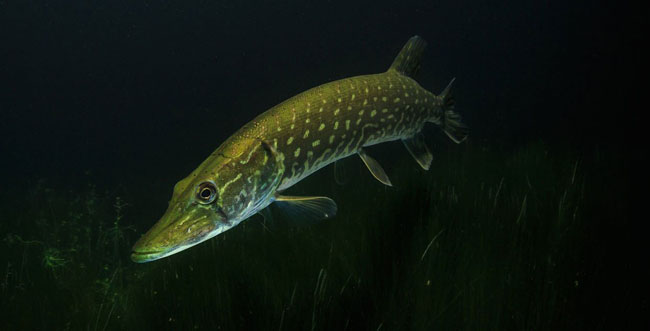
3.1 Where to go pike fishing: What makes a hotspot?
When looking for pike fishing hotspots, always ask yourself the following questions:
- What underwater vegetation is there?
- At what time of day will the pike be actively hunting?
- What depth of water do adult specimens prefer
- How far from the shore are they?
- What prey do they prefer – because it is dominant in the particular body of water?
In pike fishing, however, not all vegetation is the same: the various underwater plants do not always provide the same living conditions for the pike.
Plants are also living organisms and develop differently. For this reason, they also have a differentiated effect on the pike. In a very dense plant carpet, for example, we will rarely find large specimens.
In the winter months this becomes especially clear: some underwater plants almost completely die off in late summer and autumn. Thus, these provide a habitat for the pike only in the warm months.
Other plants recede during the colder months, but still cover the bottom of the water. They thus provide protection and cover for the pike even in winter. Just only in deeper water layers.
-

Finding Fish The Smart Way – The Pike
Download 40 pages for free now
Reviews ( 64 )
Martin
Hi Garry, i saw that contacting Jens has solved your problem. As written in the Order Mail, download is limited to 3 times. We introduced the limit to prevent fraud. However, if you lose your eBook in the future, please email us and you will of course get new downloads. Martin- Rated 1 out of 5
Garry Gregg
I bought the book online, but try as I might it would not save on my iPad mini 3, from the small amount i was able to read it looked very good. I was given a link that was promised to ALWAYS be available to me, but this was not the case! I wanted to learn how to find Pike in Lough Neagh, the largest lake in the U.K. but I can only fish it blind, useless. Make sure you can save this book BEFORE you buy. - Rated 5 out of 5
Andreas Eden
Unlike other reviewers, I am NOT in favor of shortening or streamlining. The detailed but not generalized aspects provided are scientifically sound and outline the respective topics exceedingly well. Looking forward to more of this, and keep up the great work! Martin
Hi Claus, Thank you for the info about the Tolino. So far, there have been no problems with the popular Android or Apple smartphones and tablets. We’ll take a look at it. Did the upload via the Tolino web reader not work either? Regards Martin- Rated 2 out of 5
Claus Erhard
The content is decent – maybe a little too detailed. Note: I bought the e-book version. The fact that you can’t print it out is alright (this option would be great though). However, I cannot read the PDF file on my Tolino. I uploaded it 1000 times, and nothing is displayed. So reading is only possible on the PC. Too bad! - Rated 5 out of 5
Dieter Gundacker
Highly recommended, lots of fascinating information. It is not easy to put the book down once you have started reading. - Rated 5 out of 5
Kurt Sattler
Great book. I also have “The Pikeperch”. Both are highly recommended. - Rated 5 out of 5
Mirko
A very well written book. - Rated 4 out of 5
Holzblinker
Among the advantages: -statistics and their interpretation -written in a simple and understandable way Among the disadvantages: -advertising -A lot of generally known information - Rated 3 out of 5
Bruno
Exciting content (****) with a tendency to be long-winded (**) - Rated 5 out of 5
Stefan
The book keeps what it promises. An all-around great book that stands out from the rest. The purchase was worth it! - Rated 5 out of 5
Fischfreund
A truly superb book. I also own the book on pikeperch and have to admit that they are two completely different books. There are very few overlaps, so I never had the feeling that I already knew a passage in the book. For this reason, I can unreservedly recommend the pike book. It was so much fun reading it and gradually learning more about the pike. - Rated 5 out of 5
Paul KraUS
An elaborate approach to the behavior of the fish to conclude your fishing behavior, etc. I also like that other professional opinions are taken into account and partly questioned and analyzed. You can learn a lot to save the one or the other unsuccessful day. Thank you! - Rated 5 out of 5
barney1at
I am impressed with the book! I have read many books about fishing, and this was by far the best. It reflects not only the experiences and interpretations of the authors but uses scientific studies as a basis. Some of the findings knocked my socks off, e.g., the distance of attention of the pike. Strong recommendation for anyone who wants to improve their pike fishing skills! - Rated 5 out of 5
Michael Hügel
Sehr gutes Buch hat mir weitergeholfen das Leben des Hechtes zu verstehen. - Rated 5 out of 5
frankadam67
Sehr, sehr schönes Buch mit vielen Informationen! Nun muss ich nur noch alles in die Tat umsetzen! Danke für das gut ausgearbeitete Buch! - Rated 5 out of 5
Thomas Asamer
Bin gerade am Lesen des Buches. Sehr interessant und informativ. Werde meine Hechtfänge sicherlich noch um einiges steigern können mit dem KnowHow des Buches! Weiter so!? - Rated 5 out of 5
Andre Scholz
Hallo Zusammen, ich kann nur sagen, das habt ihr wirklich sehr gut gemacht! Wahnsinnig informativ, Super gegliedert und mit vielen guten Tipps behaftet. Das Zanderbuch war schon ein Knaller!!! Ich freu mich schon auf das Barschbuch. Und nebenbei erwähnt, die Videolektionen Köderkurs 1 sind ebenfalls Mega spannend! Bitte weiter so machen…. Petri Andre - Rated 5 out of 5
Manfred Parbs
Ich finde die Bücher ” Der Hecht ” sowie ” Der Zander ” sind für erfahrene Angler und auch für den Anfänger sehr lehrreich und somit auch informativ gestaltet. Auch die vielen Tips haben mich persönlich schon so manches mal vor einem Schneidertag bewahrt. Ich besitze zudem auch noch das Buch ” Der grosse Echolotratgeber ” . Dieses Buch liefert gute Erklärungen für die Funktionen und Einstellungen von Echoloten. Desweiteren besitze ich auch noch zwei Angelkurse: zum einen Köderfarbe und zum anderen Der Deeper. Beide Kurse sind mit sehr viel Informationen und verständlichen Erklärungen gespickt die jederman sehr gut verstehen kann. Freue mich schon auf weitere Bücher. Ein grosser Dank als auch ein grosses Lob an das Fischfinderteam. Petri Heil & immer dicke Fische Manfred Parbs - Rated 4 out of 5
Fabius Voigt
Klasse Buch! Fundiertes Wissen auf gute Art und Weise zusammengefasst und übermittelt, damit Angler ihren Zielfisch besser verstehen. An einigen Ecken im Buch, wäre ein weitere genauere Ausarbeitung toll gewesen (wurde vom Autor aber selbst bemerkt und begründet). Desweiteren beruhen die meisten Angaben (90%) von Hechten aus Seen und leider nur sehr wenig aus Flüssen. Das sind meiner Meinung nach die einzigen Sachen die fehlen, aber ansonsten würde ich es als Bereicherung für jeden Angler beschreiben! - Rated 5 out of 5
Julia
Genau wie das Zanderbuch wieder der totale Hammer! Wobei für mich die Voraussetzungen etwas anders waren: Während ich meine Zanderfänge wirklich mal dringend etwas ankurbeln musste, fing ich alleine im vorigen Jahr 47 Hechte, es ging hier also eher um Optimierung. Und das ist voll gelungen! Massen von überaus hilfreichen Forschungsergebnissen, Statistiken und Tafeln. Ich bin beim Spinnangeln bisher zu viel gewandert und habe die einzelnen Spots zu kurz beangelt, das weiß ich jetzt. Und so ganz nebenbei ist mir jetzt noch klar, weshalb man in einigen durchaus interessanten Seen in meiner Umgebung von Juni bis Januar partout keinen Fisch fängt. Habe nämlich so einiges über die Schichtung gelernt, und dass eine Abkühlung eben nicht automatisch gleich Verbesserung bedeutet. Klasse! Her mit dem nächsten Buch bitte! - Rated 5 out of 5
Pascal Schlenker
Top nicht das letzte Buch für mich…. - Rated 5 out of 5
Heinz-Otto Schoel
Auf den 50zig Seiten, die ich bis jetzt gelesen habe ,bin ich begeistert. Aber die anderen Bücher über das Echolot und dem Zander waren sehr lehrreich. Weiter so. Freue mich schon auf das Barschbuch. - Rated 5 out of 5
Andreas Hillers
Modernes Fischen – Der Hecht. Ein sehr gut geschriebenes Buch. Bin begeistert von den vielen tollen Hilfestellungen. Sogar als erfahrener Angler kann hier bestimmt jeder noch den ein oder anderen Tipp für sich nutzen. Vielen lieben Dank, und weiter so für vielleicht weitere noch nicht erschienene Bücher über den Aal, Barsch, Karpfen etc. - Rated 5 out of 5
Stephandargel
Das Buch ist einfach nur klasse super beschrieben sehr verständlich beschrieben kann ich nur weiter empfehlen ? gebe dem Buch und dem Autor ne 1+ - Rated 5 out of 5
Rolf Wilde
Sehr praxisnah und auch mit viel Hintergrundinformationen gefülltes Buch. Ich habe über die Feiertage die ersten Seiten verschlungen. Sehr viele Details die ich noch bis zur Schonzeit versuche umzusetzen. - Rated 5 out of 5
Blankmaster
Die Referenz. Umfassend, kein blabla, über den Tellerrand hinausschauend, fundiert, sinnvolle und gut gemachte Graphiken, und das Ganze zu allem Überfluss auch noch unterhaltsam geschrieben. Als bekennender Wenigleser habe ich das Buch innerhalb von 3 Tagen einmal komplett durchgelesen. Uneingeschränkte Kaufempfehlung. - Rated 5 out of 5
Rudolf Knopf
Endlich ein Buch, welches man durchaus als Fachliteratur beschreiben kann. Es werden viele Erfahrungen, welche ich beim meiner Suche nach dem Hecht gemacht habe, bestätigt. Ebenso ist auch sehr viel Neues für mich in dem Buch, was ich bisher in meiner vieljährigen Anglerlaufbahn so nicht gewust habe. Absolute Kaufempfehlung. - Rated 5 out of 5
markus s
Großes Kompliment zum Buch! Ich fische seit meiner Kindheit auf Hecht (und das sind schon mehr als dreißig Jahre) und ich muss sagen, es gibt keine interessantere Lektüre zum Hecht! Viele eigene Theorien finde ich hier bestätigt, aber noch besser: Dieses Buch bietet auch wirklich neue Ansätze! - Rated 5 out of 5
Mitja
Beeindruckende Leistung von Euch, ein so komplexes Thema derart runterzubrechen, daß man das Buch in einem Rutsch durchlesen kann, ohne sich dauernd zu fragen: „verdammt, wovon labern die denn da?“ Superspannend: die Trophieklassifizierung und die Sache mit der Sprungschicht! Ich sehe meine Gewässer jetzt mit ganz anderen Augen und auf einmal kommen mir die 150 Kracher für das Anaconda-GTM gar nicht mehr so übertrieben teuer vor! Und weil es mir so gut gefallen hat, zieh ich mir morgen direkt das Echolot-Buch rein, das mit der Postbote heute morgen in den Kasten geworfen hat….für das Barschbuch hätte ich übrigens gerne einen Gutscheincode 🙂 Danke! Ich freu mich auf weitere spannende Lektüre aus eurem Stall… - Rated 5 out of 5
schoenfeld.oli
Absolut feine Lektüre. Ich gehe nach Lesen des Buches ganz anders ans Wasser. Zwischendrin etwas fader Stoff, der aber einfach dazu gehört. Dafür sind die spannenden Themen so spannend, dass ich nicht im Sitzen lesen konnte. - Rated 5 out of 5
Robert Häusler
Die beiden Autoren Martin Jacobs und Jens Biegemeier sind der Hammer. Ich habe schon viel gut recherchierte Medizinbücher gelesen und oft haben sie mir zu mehr Erfolg verholfen, dass das auch mal Zum Hechtangeln möglich wird ist großartig. Danke an dieses Meisterwerk! Ich habe mit dem Wissen aus dem Buch jetzt schon meinen Angelrekord auf Hecht gebrochen und bin mir sicher da geht noch was. Danke für eure Arbeit, den Fleiß und die Begeisterung die ihr geleistet haben müsst dieses moderne Fische finden für uns und unsrer Seekrokodiele zu ermöglichen. Petri Robert Häusler Martin
Edi, wir danken Dir und wünschen euch gute Fänge. Petri Martin vom Fischfindertestteam- Rated 5 out of 5
Edi Brader
Das beste Buch über die Fischerei auf Hecht, das ich bisher in Händen gehalten habe! Sehr ausführlich und praxisnah wird dem Einsteiger in diese Fischerei veranschaulicht worauf es ankommt und auch der eingefleischte Hechtprofi kann noch sehr viel Nützliches aus diesem Buch herausholen! Absolut EMPFEHLENSWERT! Besonders möchte ich das äußerst nette Team loben! Bei meiner Bestellung ging etwas schief, ich bekam zwei anstatt nur einer Ausgabe. Nach Rücksprache bedankten sie sich für die Information und sagten mir, dass das Zurücksenden ohnehin zu teuer wäre und ich das zweite Exemplar auch behalten dürfte. Danke Jungs, ihr habt gerade einem befreundeten Jungangler eine große Freude gemacht, ich werde euch auf jeden Fall weiterempfehlen! Macht weiter so! Petri Heil Edi Brader - Rated 5 out of 5
lusox
Prima Lektüre , wirklich zu empfehlen ! Besonders gut fand ich das Kapitel mit der Ködergröße. Ebenso das Kapitel mit den Standplätzen und die Rolle der Vegetation Ich habe viele Anregungen daraus mitgenommen und bin mal gespannt wie sich meine Hechtfänge verbessern. Weiter so ! - Rated 5 out of 5
Stefan Fischer
Ich finde, das Buch “Der Hecht” lüftete viele Geheminisse. Hatte das Buch “Der Zander” auch, alles top tock. Hoffentlich folgt das Buch auch über den Barsch, evtl. Waller/Wels. Mir fehlt die Anglerpraxis. Das Buch “Das große Echolot” ist auch klasse. Weiter studieren!!! ^^ Namaste und Petri Fischer Stefan - Rated 5 out of 5
Lasse Wiedenhöft
Wie schon beim Zanderbuch werden für alle denkbaren Situationen (Jahreszeiten, Gewässer, Wetter etc.) hilfreiche Tipps zur Strategieverbesserung gegeben. Dabei helfen die Ergebnisse aus diversen Versuchen und Tests den Hecht und sein Verhalten besser zu verstehen. Gerade die wissenschaftliche Begleitung in Kombination mit eigenen Erfahrungen hat mir schon nach wenigen Kapiteln neue Ideen vermittelt! - Rated 5 out of 5
Johann Burgstaller
Wie bereits “Der Zander”, ist auch die Hechtausgabe wieder jeden Cent wert. Ein must-have für jeden Raubfischangler. Tolle Studien, jede Menge neue Erkenntnisse und enifach zu lesen. Na dann nichts wie auf zum “Der Barsch”! - Rated 5 out of 5
Barschhunter
Das Buch ist Euch wirklich super gelungen!!!!! Es ist sehr informativ und es ist für jeden etwas dabei, ob man nun Anfänger im Angeln ist oder ein erfahrener Angler ist. Man kann immer noch was dazu lernen. Für mich persönlich war das Kapitel “Jagd und Beute” sehr interessant und spannend und möchte deswegen keine einzelnen Punkt hervorheben. Macht weiter so und ich freue mich schon auf Euer nächstes Buch “Modernes Fische Finden Der Barsch” mein persölicher favorite Fisch. Dickes Petrie Barschhunter - Rated 5 out of 5
Andre Scholz
Genauso spannend und aufschlussreich wie das Zander Buch! Wenn man seinen Zielfisch besser verstehen möchte und mehr Erfolg haben will, kommt man nicht um das Buch herum! Allein die Thematik um die Wassertemperaturen, einfach irre! Volle 5 Sterne und Danke für so viel geilen Input! Petri Andre - Rated 5 out of 5
Andreas F.
Sehr schön finde ich die Aufmachung des Buches und die logisch aufbauenden Kapitel. Das Lesen macht viel Spaß. Hier treffen die Autoren genau den richtigen Ton, einen “mitzunehmen”, obwohl die Grundlagen ja wissenschaftlich/biologisch sind. Es ist nicht einfach, plausibel und allgemein verständlich, verschiedene wissenschaftliche Erkenntnisse miteinander zu verknüpfen und hieraus die passenden Schlussfolgerungen zu ziehen. Das ist jedoch durchaus gelungen. Abläufe in der Natur sind nie statisch sondern unterliegen Abweichungen, es gibt aber Tendenzen. Deshalb kann es nicht immer genaue Gesetzmäßigkeiten geben. Hierauf weist das Buch in verschiedenen Kapitel immer wieder hin. Hier hätte ein grundlegender Hinweis in der Einleitung m.e. jedoch ausgereicht. Randnotiz: Ein Absatz erscheint wortgleich an zwei Stellen (S. 11, 1.Abs. und S. 15 3. Abs.). Im Ergebnis ist es ein Buch, was sogar enthusiastischen Raubfischanglern richtig weiterhilft! Meine Erwartungshaltung wurde sogar übertroffen. Ich freue mich auf euer Barschbuch! Vielen Dank! - Rated 5 out of 5
Pascal Kreutzmann
Wie die beiden Bücher zuvor hat mich auch das Buch über den Hecht mal wieder total begeistert. Unglaublich was ihr für einen Aufwand betreiben müsst um all dieses Wissen und die Studien zusammen zu tragen. Besonders interessant fand ich zb. die Frage danach wieviele Hechte sich denn in so einem Gewässer aufhalten. An wievielen Fischen man vorbei angelt. Das war echt interessant. Ebenso die Standplätze der Fische zu den verschiedenen Jahreszeiten und wie sehr vieles von der Wassertemperatur abhängt finde ich sehr Aufschlussreich. Auch über das fressen und gefressen werden kann man einiges erfahren. Jetzt ist mir klar warum der Hecht die Beute am liebsten am Kopf packt und sie möglichst schnell verschlingen muss. Tja die Themenvielfalt ist echt groß. Was mich noch interessiert hätte….wie/was sieht der Hecht durch seine Augen ? Was für Farben nimmt er wahr etc ? Aber das wäre eventuell zu speziell ?! Freue mich auf das nächste Buch! Bloß nicht nachlassen und genauso ausführlich weiter machen. Danke dafür. Ps…ich rezensiere aus Überzeugung , nicht wegen einem Gummifisch ! Grüße und Petri Pascal - Rated 5 out of 5
Ralf B.
Genauso interessant und prall gefüllt mit wertvollen Infos wie das Zanderbuch, einfach TOP! - Rated 5 out of 5
Bickes
Sehr gut strukuriert, sehr informativ, mir hat es definitiv geholfen, meine Taktik zu verbessern und selbstbewusster meine Stellen auszuwählen. - Rated 5 out of 5
opto
Habe alle 3 Bücher! Bin begeistert und dankbar!! Interessieren würde mich warum gerade der Hecht an einem Tag wie verrückt beißt und am nächsten Tag bei absolut gleichen Bedingungen am selben Ort wie ausgestorben erscheint! Interessieren würde mich auch wie der Zander als Augentier mit Sichtigkeiten unter 5cm klarkommt! (Hochwasser) Diese Fragen beschäftigen mich schon ein ganzes Anglerleben. - Rated 5 out of 5
Adrian Drzezla
Das Buch hat sehr viele Informationen über unseren Esox Lucius;). Jedes Kapitel ist sehr spannend und reichhaltig an Informationen. Nach diesem Buch habe ich meine Angelstrategie verbessern können und ich habe nun eine andere Ansicht von unserem Hecht im Wasser bekomme. Petri ! „ sehr empfehlenswert , Genau so wie die letzten Bücher von Fischfindertest“ - Rated 5 out of 5
Evgenij
Suuuper Buch, genau so wie das Zander Buch. Bin total begeistert. Sieht wie eine Doktorarbeit aus. Wissenschaftlich überprüft mit Verweisen, vielen Abbildungen und vielen praktischen Tips. Freue mich auf die neue Bücher! - Rated 5 out of 5
Daniel
Ich kann das Buch jedem Raubfischangler weiterempfehlen. Viele neue und nützliche Informationen rund um unseren Zielfisch Nr. 1. Tolle Arbeit! - Rated 5 out of 5
Jörg
Tolles Buch, hochinformativ von der ersten bis zur letzten Seite. Das Jahr des Hecht hat mir am besten gefallen. Man kann das Buch nur weiterempfehlen! - Rated 5 out of 5
Dirk Lindner
Top buch.umfangreich.logisch.sollte jeder haben.das Zander buch habe ich auch - Rated 5 out of 5
Jörg Thielke
Hoch interessant und verständlich geschrieben. In jedem Fall vollumfänglich weiterzuempfehlen. Danke Männers ? - Rated 5 out of 5
Stefan Klingbeil
Es war nicht anders zu erwarten. Nach dem Zander Buch bin ich wieder voll zufrieden.Die Bücher unterscheiden sich von anderen Büchern und Artikeln aus Zeitschriften. Mehr input brauch ich nicht. Alles erklärt und vernünftig erklärt. Ich lese wirklich nicht gerne Bücher. Aber hier ist es wie ein guter Krimi. Man kann nicht aufhören. Wir haben es alle gelesen und Diskutieren unser Wissen zusammen um es nochmal zu vertiefen. Jetzt freuen wir uns auf Der Barsch ? - Rated 5 out of 5
Jörg Rolle
Ein sehr gutes Buch so wie ich es erwartet habe nach dem ich Euer Zander-Buch gelesen habe. bin begeistert viele Tipps in Jagd und Beute,Umweltfaktoren,Lebensräume Kapitel 5.2.2 und Das Jahr des Hechtes.Habe noch nicht viel Erfahrung Hecht angeln ,das Buch hat mir viel Wissen übermittelt auch wenn ich noch nicht alles gelesen habe. Danke weiter so Petri - Rated 5 out of 5
Philipp
Kurz und knapp, Top! Wie auch bereits im Buch “Modernes Fische finden Der Zander” erneut abgeliefert. Besten Dank, macht weiter so! - Rated 5 out of 5
Ben
Glaube ich hab gerade vergessen die Sterne zu drücken! Auf jeden Fall 5 Sterne da es super verständlich geschrieben ist! Es beschreibt das Verhalten der Fische in verschiedenen Situationen und wenn man das versteht und nutzt fängt man sicher bald besser! Auch die Grafiken und Bilder vereinfachen es sehr gut. Bin sehr zufrieden und hoffe das noch eins für Barsche und Wels kommt! ?? - Rated 5 out of 5
Nico Drabner
Volle Punktzahl ?? Ein dickes Lob. Sehr schön aufgebaut. Am besten hat mir die Gewässeranalyse und die Aussage mit der Wassertemperatur gefallen, das passt zu 100% und Danke an den vielen nützlichen Tipps - Rated 5 out of 5
Kuhnert Giso
Also ich habe schon das Buch vom Zander gelesen. Und auch dieses Buch vom Hecht ist sehr Lehrreich mit vielen interessanten Kapiteln.. Ich bin noch nicht ganz durch mit dem lesen, aber ich weiß das es toll ist und mir auf alle Fälle weiter helfen wird um den ein oder anderen Hecht mehr an den Haken zu bekommen. Ich empfehle es auf alle Fälle weiter.. Und auch das nächste Buch über den Barsch werde ich mir holen. Macht weiter so fünf Sterne gibt’s vom mir. LG Giso - Rated 5 out of 5
David Götze
Hallo zusammen, ich habe mittlerweile alle 3 Bücher und kann ehrlich behaupten, dass es mir beim Angeln bzw. Fische finden sehr viel gebracht hat. Vorallem das Angeln unter Einfluss der Mitwelt (Wind, Temperatur…etc) lässt mich jetzt meine Spotwahl genauer überdenken. Vielen Dank dafür und ich freu mich schon auf den Barsch ^^ Petri David - Rated 4 out of 5
Peter
absolute Empfehlung - Rated 5 out of 5
Ben
Finde das Buch sehr gut! Genau wie das Zander Buch beschreibt es worauf es ankommt… das Verhalten der Fische in verschiedenen Situationen. Es ist verständlich erklärt und die Bilder und Grafiken machen es noch einfacher zu verstehen worauf es ankommt! Weiter so! Barsch und Wels können kommen? - Rated 5 out of 5
Kantor Alfred (Hatschi)
Ich habe viele Jahre viel Zeit verschwendet weil ich den Fisch nicht immer gefunden habe, dass Buch hilft wirklich die Fische zu finden. Ich habe es nicht nur gelesen sondern auch schon teilweise am Wochenende umgesetzt und das mit Erfolg (einige schöne Hechte), vielen dank ich freue mich auf euer nächstes Werk Der Barsch. Weiter so!!! Petri Heil Hatschi - Rated 5 out of 5
Patrick
Also ich muss jetzt mal eine Lanze brechen, es gibt doch noch qualitativ hochwertige Bücher zum Thema Fisch und dann noch direkt zum Thema Hecht, in einer Qualität die ihres gleichen sucht. Selten das ich derart im „Rausch“ ein Buch gelesen habe. Hut ab und weiter so. - Rated 5 out of 5
Tacklefever
Ich war sehr positiv überrascht. Der Anfänger erhält im ersten Teil des Buches wirklich brauchbares Basiswissen vermittelt. Und der ein oder andere Profi wird vielleicht sagen: “Mache ich doch immer so”. Und das ist doch das beste Lob für den ersten Teil des Buches. Aber wenn der Profi ehrlich ist, kann er wahrscheinlich schon zugeben, das ein oder andere gefunden zu haben was er vergessen hatte oder doch noch nicht wusste. Und richtig spannend für Anfänger und Profi ist der Hautteil des Buches, das Kapitel “Jahr des Hechtes”. Dieser Teil hat absolut zu Recht den meisten Platz im Buch bekommen. Bei den einfach gegliederten und nachvollziehbaren Abschnitten im Jahr des Hechtes findet sicher nicht nur der Anfänger sondern auch der Profi jede Menge tolle Infos. Meine volle Buchbesprechung findet ihr unter https://www.tacklefever.de/index.php?topic=7396.0 - Rated 5 out of 5
Andreas
Wie erwartet, ein sehr gutes Buch das nicht in dem Köderwahnsinn hinterherläuft. Besonders gut gefällt mir die Analyse der Wassertemperaturbereiche passend für meine großen See in Mecklenburg. Die Gewässeranalysen passen wie die Faust auf Auge auf dieses sehr große Gewässer. Die neuen Möglichkeiten und überragenden Fänge von einigen lokalen Guides erzielt werden, welche in Großen Teilen durch die gewaltigen Technologiesprünge im Echolotbereich und Bootsnavigation begründet sind, wurde hier sehr gut zusammengefasst. Eine Pflichtlektüre für jeden der sich an die großen Gewässer mit den noch größeren Fische wagen will. Definitiv 5 Sterne, das Buch wurde auch innerhalb von 2 Nachmittagen gelesen. Danke! - Rated 5 out of 5
Wolfgang Konter
Habe das Buch heute bekommen .Dafür erstmal ein großes Danke schön an Euch . Nach dem ersten Durchblättern war ich begeistert . Habe eigentlich auch nichts anderes erwartet . “Modernes Fische finden – Der Zander” habe ich ja schon lange durch und blättere immer wieder drin rum . Beide Bücher zeugen von viel Sachverstand und Erkenntnissen , die ich so nicht erwartet hätte . Einfach super und verständlich erklärt . Jetzt will ich nur hoffen , dass noch ein Barsch Buch auf dieses Duo folgt . Petri Heil Wolfgang Konter - Rated 5 out of 5
Catchmaster
Habe das Buch heute direkt durchgelesen. Es ist gut aufgebaut und es gibt viele nützliche Tip’s. Anfang Mai waren wir in Schweden auf Hecht angeln. Schade, dass ich dieses Buch nicht schon vorher hatte. Aufgrund der neuen Erkenntnis hätte ich bestimmt mehr Erfolg gehabt. An sich ein super Buch. Werde jetz die Tip’s in die Praxis umsetzen. Vielen Dank für dieses Buch. - Rated 5 out of 5
Jörg Rolle
Habe das Buch Heute erhalten und sofort durchgestöbert,bin Begeistert! Sehr schöne Aufmachung, gut Gegliedert und nicht zu wissenschaftlich so das es jeder Angler verstehen kann.Habe auch schon Kapitel gefunden die mir reichlich neues und gute Tipps für meine Angelpraxis gefunden. Weiter so!!!!!!! Petri Jörg Rolle
Also, the density of the plant carpet turns out completely different depending on the type of underwater plants. Hydrilla, or ground nettle, can form an impenetrable plant carpet with shoots up to eight feet long in summer.
Smaller pike and many prey fish find a perfect habitat here. Large specimens, however, are denied access because a very dense growth restricts their freedom of movement too much.
The seasonal changes in the aquatic plants ensure that the fish of the various species are always distributed differently. If plants emerge, they attract fish. If they die, the fish move on again.
We have to respond to these seasonal changes: In other words, we can’t just stubbornly fish the same hotspot all year round.
Question: How do I find the pike? Answer: Search for the prey!
Most prey fish of the pike are small and live dangerously. Therefore they need protection – and they find it in the underwater vegetation. The denser and more extensive it is, the more prey fish will be in it.
This in turn attracts many predators. Among them is the pike. Inside the vegetation, the fish population is up to seven times higher than outside.
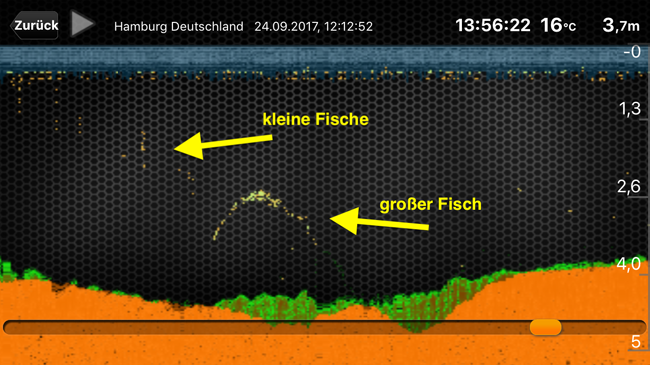
The structure of the water body has a significant influence on the underwater vegetation. Shallow waters usually have wide and expansive shallow water zones with abundant vegetation. In deep waters, the shoreline often slopes steeply due to the deep water pool. For this reason, in such the shore zones are typically narrower than in shallow waters.
How much vegetation can there be?
When we talk about pike in the catchable size range, less vegetation is ‘more’ – because large specimens need to have a clear path for their attack. If the vegetation is too dense, their attack speed is reduced enormously. The escape speed of smaller prey, on the other hand, is hardly affected. We must therefore succeed in finding the optimal vegetation density.
How do you find the optimal vegetation density?
Observations and notes from previous years are helpful here – so don’t forget to make them. If you have seen a field of water lilies in one year, you can assume that it will appear again in the same place the following year.
Unfortunately, we see the leaves quite late, as it takes some time for them to work their way to the surface. That’s why records give you a head start on the “competition”. Speak to your fishing buddies on the same body of water.
3.2 How do you use mobile fishfinders for pike fishing? (no matter if from the shore or a boat)
Deeper fish finders have revolutionized fishing from the shore. You can easily attach these mobile echo sounders to the line of your fishing rod and cast them together with it. You can then monitor what’s happening underwater on your smartphone or tablet. The nice thing is that the vegetation is immediately displayed in a different color.
Note: Fish finders have become a fundamental part of our fishing equipment. They shorten the time to find hotspots by quite a bit. However, the opinion about them is still divided in Germany. While some love them, others curse them and say that it has nothing to do with fishing anymore. We do not want to evaluate both statements at this point.
But one thing is certain: Fish sonars may not bring the fish to the hook, but they do bring our bait closer to the pike. They show possible hotspots and provide more information about what’s going on underwater. This gives us a better idea of where we should cast our lures and what depth is most promising.
Learn everything about pike fishing in a river here.
With a touch of sarcasm we could say that a hunter hoping to hit a deer doesn’t just shoot blindly into the forest neither.
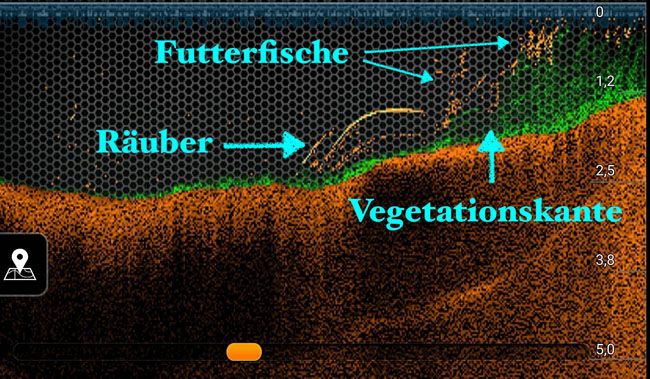
3.3 Fishing under windy weather: Where is the pike?
Although pike love shallow water, they tend to leave their position on windy days. The wind creates waves and near the shore the water quickly becomes murky due to stirred up sediment. If clouds are also present, they further obscure the ambient light in the water.
Scientists suspect that this circumstance causes sight-oriented predators such as pike to leave the murky water to increase their chances of a successful hunt. To do this, they retreat to the outer reaches of their territories.
If you do not adjust your fishing technique on such days, you will fish past most pike.
Large specimens (over approx. 60 cm) sometimes leave the shallow water completely. They now stick to the edges and slopes towards the middle of the water. However, they do not necessarily change their preferred depth and thus continue to stay at a maximum depth of 4 meters. From their floating position, they can hunt optimally into the riparian vegetation.
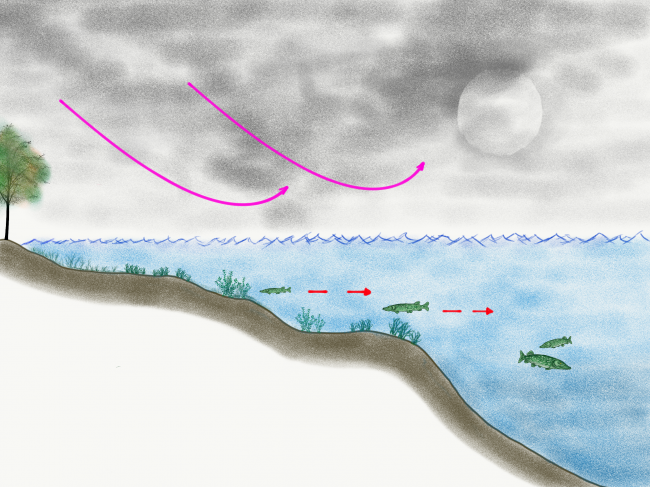
Note: In windy weather and waves hitting the shore, many pike are concentrated in the outer shore areas. Exactly where the vegetation breaks up or ends and the open water begins, you will find them in abundance under these conditions.
If you use lures that keep a specific depth or slide slowly into the depth under these conditions, then you can go after the specimens lurking for prey on the edges towards the open water.
-

Finding Fish The Smart Way – The Pike
Fish like a pro
Reviews ( 64 )
Martin
Hi Garry, i saw that contacting Jens has solved your problem. As written in the Order Mail, download is limited to 3 times. We introduced the limit to prevent fraud. However, if you lose your eBook in the future, please email us and you will of course get new downloads. Martin- Rated 1 out of 5
Garry Gregg
I bought the book online, but try as I might it would not save on my iPad mini 3, from the small amount i was able to read it looked very good. I was given a link that was promised to ALWAYS be available to me, but this was not the case! I wanted to learn how to find Pike in Lough Neagh, the largest lake in the U.K. but I can only fish it blind, useless. Make sure you can save this book BEFORE you buy. - Rated 5 out of 5
Andreas Eden
Unlike other reviewers, I am NOT in favor of shortening or streamlining. The detailed but not generalized aspects provided are scientifically sound and outline the respective topics exceedingly well. Looking forward to more of this, and keep up the great work! Martin
Hi Claus, Thank you for the info about the Tolino. So far, there have been no problems with the popular Android or Apple smartphones and tablets. We’ll take a look at it. Did the upload via the Tolino web reader not work either? Regards Martin- Rated 2 out of 5
Claus Erhard
The content is decent – maybe a little too detailed. Note: I bought the e-book version. The fact that you can’t print it out is alright (this option would be great though). However, I cannot read the PDF file on my Tolino. I uploaded it 1000 times, and nothing is displayed. So reading is only possible on the PC. Too bad! - Rated 5 out of 5
Dieter Gundacker
Highly recommended, lots of fascinating information. It is not easy to put the book down once you have started reading. - Rated 5 out of 5
Kurt Sattler
Great book. I also have “The Pikeperch”. Both are highly recommended. - Rated 5 out of 5
Mirko
A very well written book. - Rated 4 out of 5
Holzblinker
Among the advantages: -statistics and their interpretation -written in a simple and understandable way Among the disadvantages: -advertising -A lot of generally known information - Rated 3 out of 5
Bruno
Exciting content (****) with a tendency to be long-winded (**) - Rated 5 out of 5
Stefan
The book keeps what it promises. An all-around great book that stands out from the rest. The purchase was worth it! - Rated 5 out of 5
Fischfreund
A truly superb book. I also own the book on pikeperch and have to admit that they are two completely different books. There are very few overlaps, so I never had the feeling that I already knew a passage in the book. For this reason, I can unreservedly recommend the pike book. It was so much fun reading it and gradually learning more about the pike. - Rated 5 out of 5
Paul KraUS
An elaborate approach to the behavior of the fish to conclude your fishing behavior, etc. I also like that other professional opinions are taken into account and partly questioned and analyzed. You can learn a lot to save the one or the other unsuccessful day. Thank you! - Rated 5 out of 5
barney1at
I am impressed with the book! I have read many books about fishing, and this was by far the best. It reflects not only the experiences and interpretations of the authors but uses scientific studies as a basis. Some of the findings knocked my socks off, e.g., the distance of attention of the pike. Strong recommendation for anyone who wants to improve their pike fishing skills! - Rated 5 out of 5
Michael Hügel
Sehr gutes Buch hat mir weitergeholfen das Leben des Hechtes zu verstehen. - Rated 5 out of 5
frankadam67
Sehr, sehr schönes Buch mit vielen Informationen! Nun muss ich nur noch alles in die Tat umsetzen! Danke für das gut ausgearbeitete Buch! - Rated 5 out of 5
Thomas Asamer
Bin gerade am Lesen des Buches. Sehr interessant und informativ. Werde meine Hechtfänge sicherlich noch um einiges steigern können mit dem KnowHow des Buches! Weiter so!? - Rated 5 out of 5
Andre Scholz
Hallo Zusammen, ich kann nur sagen, das habt ihr wirklich sehr gut gemacht! Wahnsinnig informativ, Super gegliedert und mit vielen guten Tipps behaftet. Das Zanderbuch war schon ein Knaller!!! Ich freu mich schon auf das Barschbuch. Und nebenbei erwähnt, die Videolektionen Köderkurs 1 sind ebenfalls Mega spannend! Bitte weiter so machen…. Petri Andre - Rated 5 out of 5
Manfred Parbs
Ich finde die Bücher ” Der Hecht ” sowie ” Der Zander ” sind für erfahrene Angler und auch für den Anfänger sehr lehrreich und somit auch informativ gestaltet. Auch die vielen Tips haben mich persönlich schon so manches mal vor einem Schneidertag bewahrt. Ich besitze zudem auch noch das Buch ” Der grosse Echolotratgeber ” . Dieses Buch liefert gute Erklärungen für die Funktionen und Einstellungen von Echoloten. Desweiteren besitze ich auch noch zwei Angelkurse: zum einen Köderfarbe und zum anderen Der Deeper. Beide Kurse sind mit sehr viel Informationen und verständlichen Erklärungen gespickt die jederman sehr gut verstehen kann. Freue mich schon auf weitere Bücher. Ein grosser Dank als auch ein grosses Lob an das Fischfinderteam. Petri Heil & immer dicke Fische Manfred Parbs - Rated 4 out of 5
Fabius Voigt
Klasse Buch! Fundiertes Wissen auf gute Art und Weise zusammengefasst und übermittelt, damit Angler ihren Zielfisch besser verstehen. An einigen Ecken im Buch, wäre ein weitere genauere Ausarbeitung toll gewesen (wurde vom Autor aber selbst bemerkt und begründet). Desweiteren beruhen die meisten Angaben (90%) von Hechten aus Seen und leider nur sehr wenig aus Flüssen. Das sind meiner Meinung nach die einzigen Sachen die fehlen, aber ansonsten würde ich es als Bereicherung für jeden Angler beschreiben! - Rated 5 out of 5
Julia
Genau wie das Zanderbuch wieder der totale Hammer! Wobei für mich die Voraussetzungen etwas anders waren: Während ich meine Zanderfänge wirklich mal dringend etwas ankurbeln musste, fing ich alleine im vorigen Jahr 47 Hechte, es ging hier also eher um Optimierung. Und das ist voll gelungen! Massen von überaus hilfreichen Forschungsergebnissen, Statistiken und Tafeln. Ich bin beim Spinnangeln bisher zu viel gewandert und habe die einzelnen Spots zu kurz beangelt, das weiß ich jetzt. Und so ganz nebenbei ist mir jetzt noch klar, weshalb man in einigen durchaus interessanten Seen in meiner Umgebung von Juni bis Januar partout keinen Fisch fängt. Habe nämlich so einiges über die Schichtung gelernt, und dass eine Abkühlung eben nicht automatisch gleich Verbesserung bedeutet. Klasse! Her mit dem nächsten Buch bitte! - Rated 5 out of 5
Pascal Schlenker
Top nicht das letzte Buch für mich…. - Rated 5 out of 5
Heinz-Otto Schoel
Auf den 50zig Seiten, die ich bis jetzt gelesen habe ,bin ich begeistert. Aber die anderen Bücher über das Echolot und dem Zander waren sehr lehrreich. Weiter so. Freue mich schon auf das Barschbuch. - Rated 5 out of 5
Andreas Hillers
Modernes Fischen – Der Hecht. Ein sehr gut geschriebenes Buch. Bin begeistert von den vielen tollen Hilfestellungen. Sogar als erfahrener Angler kann hier bestimmt jeder noch den ein oder anderen Tipp für sich nutzen. Vielen lieben Dank, und weiter so für vielleicht weitere noch nicht erschienene Bücher über den Aal, Barsch, Karpfen etc. - Rated 5 out of 5
Stephandargel
Das Buch ist einfach nur klasse super beschrieben sehr verständlich beschrieben kann ich nur weiter empfehlen ? gebe dem Buch und dem Autor ne 1+ - Rated 5 out of 5
Rolf Wilde
Sehr praxisnah und auch mit viel Hintergrundinformationen gefülltes Buch. Ich habe über die Feiertage die ersten Seiten verschlungen. Sehr viele Details die ich noch bis zur Schonzeit versuche umzusetzen. - Rated 5 out of 5
Blankmaster
Die Referenz. Umfassend, kein blabla, über den Tellerrand hinausschauend, fundiert, sinnvolle und gut gemachte Graphiken, und das Ganze zu allem Überfluss auch noch unterhaltsam geschrieben. Als bekennender Wenigleser habe ich das Buch innerhalb von 3 Tagen einmal komplett durchgelesen. Uneingeschränkte Kaufempfehlung. - Rated 5 out of 5
Rudolf Knopf
Endlich ein Buch, welches man durchaus als Fachliteratur beschreiben kann. Es werden viele Erfahrungen, welche ich beim meiner Suche nach dem Hecht gemacht habe, bestätigt. Ebenso ist auch sehr viel Neues für mich in dem Buch, was ich bisher in meiner vieljährigen Anglerlaufbahn so nicht gewust habe. Absolute Kaufempfehlung. - Rated 5 out of 5
markus s
Großes Kompliment zum Buch! Ich fische seit meiner Kindheit auf Hecht (und das sind schon mehr als dreißig Jahre) und ich muss sagen, es gibt keine interessantere Lektüre zum Hecht! Viele eigene Theorien finde ich hier bestätigt, aber noch besser: Dieses Buch bietet auch wirklich neue Ansätze! - Rated 5 out of 5
Mitja
Beeindruckende Leistung von Euch, ein so komplexes Thema derart runterzubrechen, daß man das Buch in einem Rutsch durchlesen kann, ohne sich dauernd zu fragen: „verdammt, wovon labern die denn da?“ Superspannend: die Trophieklassifizierung und die Sache mit der Sprungschicht! Ich sehe meine Gewässer jetzt mit ganz anderen Augen und auf einmal kommen mir die 150 Kracher für das Anaconda-GTM gar nicht mehr so übertrieben teuer vor! Und weil es mir so gut gefallen hat, zieh ich mir morgen direkt das Echolot-Buch rein, das mit der Postbote heute morgen in den Kasten geworfen hat….für das Barschbuch hätte ich übrigens gerne einen Gutscheincode 🙂 Danke! Ich freu mich auf weitere spannende Lektüre aus eurem Stall… - Rated 5 out of 5
schoenfeld.oli
Absolut feine Lektüre. Ich gehe nach Lesen des Buches ganz anders ans Wasser. Zwischendrin etwas fader Stoff, der aber einfach dazu gehört. Dafür sind die spannenden Themen so spannend, dass ich nicht im Sitzen lesen konnte. - Rated 5 out of 5
Robert Häusler
Die beiden Autoren Martin Jacobs und Jens Biegemeier sind der Hammer. Ich habe schon viel gut recherchierte Medizinbücher gelesen und oft haben sie mir zu mehr Erfolg verholfen, dass das auch mal Zum Hechtangeln möglich wird ist großartig. Danke an dieses Meisterwerk! Ich habe mit dem Wissen aus dem Buch jetzt schon meinen Angelrekord auf Hecht gebrochen und bin mir sicher da geht noch was. Danke für eure Arbeit, den Fleiß und die Begeisterung die ihr geleistet haben müsst dieses moderne Fische finden für uns und unsrer Seekrokodiele zu ermöglichen. Petri Robert Häusler Martin
Edi, wir danken Dir und wünschen euch gute Fänge. Petri Martin vom Fischfindertestteam- Rated 5 out of 5
Edi Brader
Das beste Buch über die Fischerei auf Hecht, das ich bisher in Händen gehalten habe! Sehr ausführlich und praxisnah wird dem Einsteiger in diese Fischerei veranschaulicht worauf es ankommt und auch der eingefleischte Hechtprofi kann noch sehr viel Nützliches aus diesem Buch herausholen! Absolut EMPFEHLENSWERT! Besonders möchte ich das äußerst nette Team loben! Bei meiner Bestellung ging etwas schief, ich bekam zwei anstatt nur einer Ausgabe. Nach Rücksprache bedankten sie sich für die Information und sagten mir, dass das Zurücksenden ohnehin zu teuer wäre und ich das zweite Exemplar auch behalten dürfte. Danke Jungs, ihr habt gerade einem befreundeten Jungangler eine große Freude gemacht, ich werde euch auf jeden Fall weiterempfehlen! Macht weiter so! Petri Heil Edi Brader - Rated 5 out of 5
lusox
Prima Lektüre , wirklich zu empfehlen ! Besonders gut fand ich das Kapitel mit der Ködergröße. Ebenso das Kapitel mit den Standplätzen und die Rolle der Vegetation Ich habe viele Anregungen daraus mitgenommen und bin mal gespannt wie sich meine Hechtfänge verbessern. Weiter so ! - Rated 5 out of 5
Stefan Fischer
Ich finde, das Buch “Der Hecht” lüftete viele Geheminisse. Hatte das Buch “Der Zander” auch, alles top tock. Hoffentlich folgt das Buch auch über den Barsch, evtl. Waller/Wels. Mir fehlt die Anglerpraxis. Das Buch “Das große Echolot” ist auch klasse. Weiter studieren!!! ^^ Namaste und Petri Fischer Stefan - Rated 5 out of 5
Lasse Wiedenhöft
Wie schon beim Zanderbuch werden für alle denkbaren Situationen (Jahreszeiten, Gewässer, Wetter etc.) hilfreiche Tipps zur Strategieverbesserung gegeben. Dabei helfen die Ergebnisse aus diversen Versuchen und Tests den Hecht und sein Verhalten besser zu verstehen. Gerade die wissenschaftliche Begleitung in Kombination mit eigenen Erfahrungen hat mir schon nach wenigen Kapiteln neue Ideen vermittelt! - Rated 5 out of 5
Johann Burgstaller
Wie bereits “Der Zander”, ist auch die Hechtausgabe wieder jeden Cent wert. Ein must-have für jeden Raubfischangler. Tolle Studien, jede Menge neue Erkenntnisse und enifach zu lesen. Na dann nichts wie auf zum “Der Barsch”! - Rated 5 out of 5
Barschhunter
Das Buch ist Euch wirklich super gelungen!!!!! Es ist sehr informativ und es ist für jeden etwas dabei, ob man nun Anfänger im Angeln ist oder ein erfahrener Angler ist. Man kann immer noch was dazu lernen. Für mich persönlich war das Kapitel “Jagd und Beute” sehr interessant und spannend und möchte deswegen keine einzelnen Punkt hervorheben. Macht weiter so und ich freue mich schon auf Euer nächstes Buch “Modernes Fische Finden Der Barsch” mein persölicher favorite Fisch. Dickes Petrie Barschhunter - Rated 5 out of 5
Andre Scholz
Genauso spannend und aufschlussreich wie das Zander Buch! Wenn man seinen Zielfisch besser verstehen möchte und mehr Erfolg haben will, kommt man nicht um das Buch herum! Allein die Thematik um die Wassertemperaturen, einfach irre! Volle 5 Sterne und Danke für so viel geilen Input! Petri Andre - Rated 5 out of 5
Andreas F.
Sehr schön finde ich die Aufmachung des Buches und die logisch aufbauenden Kapitel. Das Lesen macht viel Spaß. Hier treffen die Autoren genau den richtigen Ton, einen “mitzunehmen”, obwohl die Grundlagen ja wissenschaftlich/biologisch sind. Es ist nicht einfach, plausibel und allgemein verständlich, verschiedene wissenschaftliche Erkenntnisse miteinander zu verknüpfen und hieraus die passenden Schlussfolgerungen zu ziehen. Das ist jedoch durchaus gelungen. Abläufe in der Natur sind nie statisch sondern unterliegen Abweichungen, es gibt aber Tendenzen. Deshalb kann es nicht immer genaue Gesetzmäßigkeiten geben. Hierauf weist das Buch in verschiedenen Kapitel immer wieder hin. Hier hätte ein grundlegender Hinweis in der Einleitung m.e. jedoch ausgereicht. Randnotiz: Ein Absatz erscheint wortgleich an zwei Stellen (S. 11, 1.Abs. und S. 15 3. Abs.). Im Ergebnis ist es ein Buch, was sogar enthusiastischen Raubfischanglern richtig weiterhilft! Meine Erwartungshaltung wurde sogar übertroffen. Ich freue mich auf euer Barschbuch! Vielen Dank! - Rated 5 out of 5
Pascal Kreutzmann
Wie die beiden Bücher zuvor hat mich auch das Buch über den Hecht mal wieder total begeistert. Unglaublich was ihr für einen Aufwand betreiben müsst um all dieses Wissen und die Studien zusammen zu tragen. Besonders interessant fand ich zb. die Frage danach wieviele Hechte sich denn in so einem Gewässer aufhalten. An wievielen Fischen man vorbei angelt. Das war echt interessant. Ebenso die Standplätze der Fische zu den verschiedenen Jahreszeiten und wie sehr vieles von der Wassertemperatur abhängt finde ich sehr Aufschlussreich. Auch über das fressen und gefressen werden kann man einiges erfahren. Jetzt ist mir klar warum der Hecht die Beute am liebsten am Kopf packt und sie möglichst schnell verschlingen muss. Tja die Themenvielfalt ist echt groß. Was mich noch interessiert hätte….wie/was sieht der Hecht durch seine Augen ? Was für Farben nimmt er wahr etc ? Aber das wäre eventuell zu speziell ?! Freue mich auf das nächste Buch! Bloß nicht nachlassen und genauso ausführlich weiter machen. Danke dafür. Ps…ich rezensiere aus Überzeugung , nicht wegen einem Gummifisch ! Grüße und Petri Pascal - Rated 5 out of 5
Ralf B.
Genauso interessant und prall gefüllt mit wertvollen Infos wie das Zanderbuch, einfach TOP! - Rated 5 out of 5
Bickes
Sehr gut strukuriert, sehr informativ, mir hat es definitiv geholfen, meine Taktik zu verbessern und selbstbewusster meine Stellen auszuwählen. - Rated 5 out of 5
opto
Habe alle 3 Bücher! Bin begeistert und dankbar!! Interessieren würde mich warum gerade der Hecht an einem Tag wie verrückt beißt und am nächsten Tag bei absolut gleichen Bedingungen am selben Ort wie ausgestorben erscheint! Interessieren würde mich auch wie der Zander als Augentier mit Sichtigkeiten unter 5cm klarkommt! (Hochwasser) Diese Fragen beschäftigen mich schon ein ganzes Anglerleben. - Rated 5 out of 5
Adrian Drzezla
Das Buch hat sehr viele Informationen über unseren Esox Lucius;). Jedes Kapitel ist sehr spannend und reichhaltig an Informationen. Nach diesem Buch habe ich meine Angelstrategie verbessern können und ich habe nun eine andere Ansicht von unserem Hecht im Wasser bekomme. Petri ! „ sehr empfehlenswert , Genau so wie die letzten Bücher von Fischfindertest“ - Rated 5 out of 5
Evgenij
Suuuper Buch, genau so wie das Zander Buch. Bin total begeistert. Sieht wie eine Doktorarbeit aus. Wissenschaftlich überprüft mit Verweisen, vielen Abbildungen und vielen praktischen Tips. Freue mich auf die neue Bücher! - Rated 5 out of 5
Daniel
Ich kann das Buch jedem Raubfischangler weiterempfehlen. Viele neue und nützliche Informationen rund um unseren Zielfisch Nr. 1. Tolle Arbeit! - Rated 5 out of 5
Jörg
Tolles Buch, hochinformativ von der ersten bis zur letzten Seite. Das Jahr des Hecht hat mir am besten gefallen. Man kann das Buch nur weiterempfehlen! - Rated 5 out of 5
Dirk Lindner
Top buch.umfangreich.logisch.sollte jeder haben.das Zander buch habe ich auch - Rated 5 out of 5
Jörg Thielke
Hoch interessant und verständlich geschrieben. In jedem Fall vollumfänglich weiterzuempfehlen. Danke Männers ? - Rated 5 out of 5
Stefan Klingbeil
Es war nicht anders zu erwarten. Nach dem Zander Buch bin ich wieder voll zufrieden.Die Bücher unterscheiden sich von anderen Büchern und Artikeln aus Zeitschriften. Mehr input brauch ich nicht. Alles erklärt und vernünftig erklärt. Ich lese wirklich nicht gerne Bücher. Aber hier ist es wie ein guter Krimi. Man kann nicht aufhören. Wir haben es alle gelesen und Diskutieren unser Wissen zusammen um es nochmal zu vertiefen. Jetzt freuen wir uns auf Der Barsch ? - Rated 5 out of 5
Jörg Rolle
Ein sehr gutes Buch so wie ich es erwartet habe nach dem ich Euer Zander-Buch gelesen habe. bin begeistert viele Tipps in Jagd und Beute,Umweltfaktoren,Lebensräume Kapitel 5.2.2 und Das Jahr des Hechtes.Habe noch nicht viel Erfahrung Hecht angeln ,das Buch hat mir viel Wissen übermittelt auch wenn ich noch nicht alles gelesen habe. Danke weiter so Petri - Rated 5 out of 5
Philipp
Kurz und knapp, Top! Wie auch bereits im Buch “Modernes Fische finden Der Zander” erneut abgeliefert. Besten Dank, macht weiter so! - Rated 5 out of 5
Ben
Glaube ich hab gerade vergessen die Sterne zu drücken! Auf jeden Fall 5 Sterne da es super verständlich geschrieben ist! Es beschreibt das Verhalten der Fische in verschiedenen Situationen und wenn man das versteht und nutzt fängt man sicher bald besser! Auch die Grafiken und Bilder vereinfachen es sehr gut. Bin sehr zufrieden und hoffe das noch eins für Barsche und Wels kommt! ?? - Rated 5 out of 5
Nico Drabner
Volle Punktzahl ?? Ein dickes Lob. Sehr schön aufgebaut. Am besten hat mir die Gewässeranalyse und die Aussage mit der Wassertemperatur gefallen, das passt zu 100% und Danke an den vielen nützlichen Tipps - Rated 5 out of 5
Kuhnert Giso
Also ich habe schon das Buch vom Zander gelesen. Und auch dieses Buch vom Hecht ist sehr Lehrreich mit vielen interessanten Kapiteln.. Ich bin noch nicht ganz durch mit dem lesen, aber ich weiß das es toll ist und mir auf alle Fälle weiter helfen wird um den ein oder anderen Hecht mehr an den Haken zu bekommen. Ich empfehle es auf alle Fälle weiter.. Und auch das nächste Buch über den Barsch werde ich mir holen. Macht weiter so fünf Sterne gibt’s vom mir. LG Giso - Rated 5 out of 5
David Götze
Hallo zusammen, ich habe mittlerweile alle 3 Bücher und kann ehrlich behaupten, dass es mir beim Angeln bzw. Fische finden sehr viel gebracht hat. Vorallem das Angeln unter Einfluss der Mitwelt (Wind, Temperatur…etc) lässt mich jetzt meine Spotwahl genauer überdenken. Vielen Dank dafür und ich freu mich schon auf den Barsch ^^ Petri David - Rated 4 out of 5
Peter
absolute Empfehlung - Rated 5 out of 5
Ben
Finde das Buch sehr gut! Genau wie das Zander Buch beschreibt es worauf es ankommt… das Verhalten der Fische in verschiedenen Situationen. Es ist verständlich erklärt und die Bilder und Grafiken machen es noch einfacher zu verstehen worauf es ankommt! Weiter so! Barsch und Wels können kommen? - Rated 5 out of 5
Kantor Alfred (Hatschi)
Ich habe viele Jahre viel Zeit verschwendet weil ich den Fisch nicht immer gefunden habe, dass Buch hilft wirklich die Fische zu finden. Ich habe es nicht nur gelesen sondern auch schon teilweise am Wochenende umgesetzt und das mit Erfolg (einige schöne Hechte), vielen dank ich freue mich auf euer nächstes Werk Der Barsch. Weiter so!!! Petri Heil Hatschi - Rated 5 out of 5
Patrick
Also ich muss jetzt mal eine Lanze brechen, es gibt doch noch qualitativ hochwertige Bücher zum Thema Fisch und dann noch direkt zum Thema Hecht, in einer Qualität die ihres gleichen sucht. Selten das ich derart im „Rausch“ ein Buch gelesen habe. Hut ab und weiter so. - Rated 5 out of 5
Tacklefever
Ich war sehr positiv überrascht. Der Anfänger erhält im ersten Teil des Buches wirklich brauchbares Basiswissen vermittelt. Und der ein oder andere Profi wird vielleicht sagen: “Mache ich doch immer so”. Und das ist doch das beste Lob für den ersten Teil des Buches. Aber wenn der Profi ehrlich ist, kann er wahrscheinlich schon zugeben, das ein oder andere gefunden zu haben was er vergessen hatte oder doch noch nicht wusste. Und richtig spannend für Anfänger und Profi ist der Hautteil des Buches, das Kapitel “Jahr des Hechtes”. Dieser Teil hat absolut zu Recht den meisten Platz im Buch bekommen. Bei den einfach gegliederten und nachvollziehbaren Abschnitten im Jahr des Hechtes findet sicher nicht nur der Anfänger sondern auch der Profi jede Menge tolle Infos. Meine volle Buchbesprechung findet ihr unter https://www.tacklefever.de/index.php?topic=7396.0 - Rated 5 out of 5
Andreas
Wie erwartet, ein sehr gutes Buch das nicht in dem Köderwahnsinn hinterherläuft. Besonders gut gefällt mir die Analyse der Wassertemperaturbereiche passend für meine großen See in Mecklenburg. Die Gewässeranalysen passen wie die Faust auf Auge auf dieses sehr große Gewässer. Die neuen Möglichkeiten und überragenden Fänge von einigen lokalen Guides erzielt werden, welche in Großen Teilen durch die gewaltigen Technologiesprünge im Echolotbereich und Bootsnavigation begründet sind, wurde hier sehr gut zusammengefasst. Eine Pflichtlektüre für jeden der sich an die großen Gewässer mit den noch größeren Fische wagen will. Definitiv 5 Sterne, das Buch wurde auch innerhalb von 2 Nachmittagen gelesen. Danke! - Rated 5 out of 5
Wolfgang Konter
Habe das Buch heute bekommen .Dafür erstmal ein großes Danke schön an Euch . Nach dem ersten Durchblättern war ich begeistert . Habe eigentlich auch nichts anderes erwartet . “Modernes Fische finden – Der Zander” habe ich ja schon lange durch und blättere immer wieder drin rum . Beide Bücher zeugen von viel Sachverstand und Erkenntnissen , die ich so nicht erwartet hätte . Einfach super und verständlich erklärt . Jetzt will ich nur hoffen , dass noch ein Barsch Buch auf dieses Duo folgt . Petri Heil Wolfgang Konter - Rated 5 out of 5
Catchmaster
Habe das Buch heute direkt durchgelesen. Es ist gut aufgebaut und es gibt viele nützliche Tip’s. Anfang Mai waren wir in Schweden auf Hecht angeln. Schade, dass ich dieses Buch nicht schon vorher hatte. Aufgrund der neuen Erkenntnis hätte ich bestimmt mehr Erfolg gehabt. An sich ein super Buch. Werde jetz die Tip’s in die Praxis umsetzen. Vielen Dank für dieses Buch. - Rated 5 out of 5
Jörg Rolle
Habe das Buch Heute erhalten und sofort durchgestöbert,bin Begeistert! Sehr schöne Aufmachung, gut Gegliedert und nicht zu wissenschaftlich so das es jeder Angler verstehen kann.Habe auch schon Kapitel gefunden die mir reichlich neues und gute Tipps für meine Angelpraxis gefunden. Weiter so!!!!!!! Petri Jörg Rolle
When is the best time for pike fishing? (Time of day, month, season)
Regarding the best time to catch a pike, we need to distinguish between the best time of the day and the best time of the year (or month). Additionally, the weather has an impact on when the pike will bite.
Weather:
Pike feel most comfortable with water temperatures between 15 and 17°C. This is when they are most active. High activity means high energy consumption, means increased food intake. And those who eat a lot also hook more easily.
Catch rates are also higher in windy weather. Here, the stronger the breeze, the higher the chances of success. This is because the wind causes turbidity, which impairs visibility. Not only that of the hunter (you), but more importantly that of the prey: the pike.
Time of day:
Most pike are caught at dusk (morning and evening). This is probably because the prey fish move into open water at this time, giving the predators a higher chance of success. And therefore they hunt more actively.
In addition, as a visual predator, the pike is likely to have difficulty distinguishing between bait and real prey fish in the light conditions prevailing at this time.
Months and season
The best months to fish for pike are those in which they feed the most. This is on the one hand in spring before (end of February – March) and after (May) the spawning season. And on the other hand in autumn before the onset of winter (September – October). Here you can learn more about pike fishing in spring.
Before the spawning season they need energy to prepare itself physically for the strenuous weeks of mating and spawning. After that, they need to recover depleted reserves. In fall, weight gain is simply a matter of survival, as they will subsequently need the excess grams (or kilos) to get through the winter in good shape.
Here you can learn more about when is the best time to fish for pike.
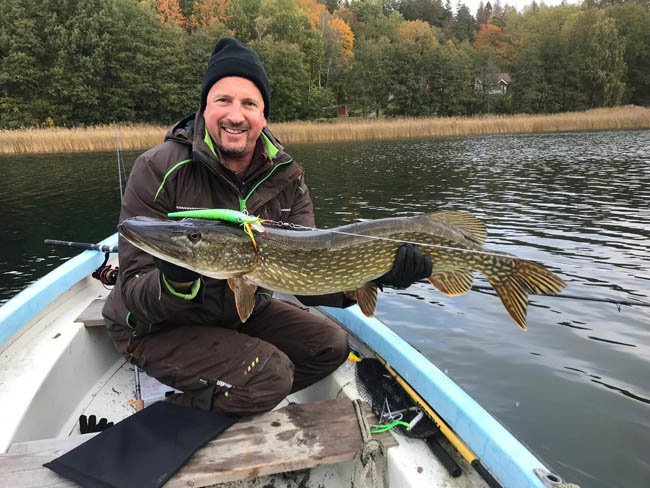
What do you need to catch a pike?
The basic equipment consists of: Fishing rod, reels, line, hooks, double wire and bite indicator. In addition, long tweezers, wire cutters and needle nosed pliers are recommended to remove the pike from the hook. This is essentially to protect your fingers, as pike have extremely sharp teeth.
It is also important that the entire fishing gear is sufficiently stable to withstand the escape attempts of the powerful predatory fish.
5.1. Which rod for the pike?
Pike have been caught with the most absurd baits and methods, usually without the declared intention of trying to outsmart this particular fish. In our catch books, for example, there are two large specimens that fell for a tiny bread ball on a 16 hook and a corn kernel on a 12 hook.
Apart from such exotic variants, we find a rich offer of baits for pike in the market. And subsequently also in the selection of target fishing rods.
First conclusion from this insight: THE (only) right pike rod does not exist.
- Depending on the preferred fishing method – be it in the focus on artificial bait or baitfish – pike rods are adapted to one or another type of fishing.
- It also plays a role whether we pursue the predator from the boat or prefer shore fishing.
- It is equally important to optimize the tackle for the type of water: running water or standing water.
All these different requirements bring us to the following rough overview for good pike rods:
| Bait / Method | Shore: Standing water | Shore: Running water | Fishing from a boat |
|---|---|---|---|
| Spinner, flasher or wobbler light / medium | Rod length: 2.40 - 2.70 m (7.9 - 8.85 ft) Lure weight: 40 - 80 g | Rod length: 2.7 - 3 m (8.85 - 9,85 ft) Lure weight: 60 - 100 g | Rod length: 2.2 - 2.5 m (7.2 - 8.2 ft) Lure weight: 40 - 80 g |
| Spinners, flashers, wobblers and large rubbers | 2.60 - 3.00 m (8.5 - 9.85 ft) / 70 - 110 g | 3.00 - 3.30 m (9.85 - 10.8 ft) / 120 g | 2.40 - 2.70 m (7.85 - 8.85 ft) / 70 - 110 g |
| Trolling: Bait up to 60 g | 2.20 - 2.70 m (7.2 - 8.85 ft) / 50 - 90 g | ||
| Heavy trolling: bait from 60 g on | 2.20 - 2.70 m (7.9 - 8.85 ft) / 100 g | ||
| Float fishing with bait fish | 3 - 3.6 m (9.85 - 11.8 ft) / 80 - 100 g | 3.3 - 3.9 m (10.8 - 12.8 ft) / 80 - 120 g | 3 m (9.85 ft) / 80 - 100 g |
| Ground fishing with bait fish | 3 - 3.6 m (9.85 - 11.8 ft) / 120 g | 3.5 - 3.9 m (11.5 - 12.8 ft) / 120 g | |
| Modern methods such as jerking or twitching | 1.8 - 2.4 m (5.9 - 7.9 ft) / 80 g (depending on the lure) | 2.2 - 2.6 m (7.2 - 8.5 ft) / 80 g (less suitable for strong currents) | 1.8 - 2.4 m (5.9 - 7.9 ft) / 80 g (hard rod) |
Some examples of recommended pike rods (with ascending price) in the described areas of use are:
a) SAVAGE GEAR MPP2 Multi Purpose Predator2 Trigger
Length: 2.59 m (8.5 ft); Lure weight: 90 g; two-piece; medium action.
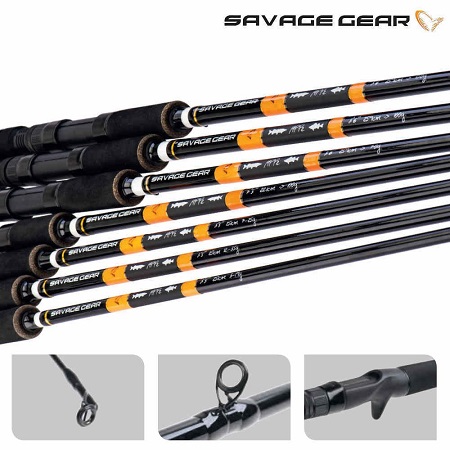
The perfectly tuned predator rod for casting from the shore with larger flashers, wobblers and rubber fish with lead head starting from 25 g. Also excellent for trolling with lures up to 60 g.
Sensitive tip, which reflects the course of the bait perfectly plus a strong backbone for a powerful strike and controlled drill.
The rod is equipped with a trigger handle, which perfectly enhances the use of a suitable multi-reel but does not speak against the use of a stationary one either.
It is also slightly tighter ringed, which is ideal for multi-reel use, as well as helpful for all modern fishing methods. But does not necessarily speak for tremendous casting distances.
b) Daiwa Power Mesh Jerk
Rod length: 1,95 m; Lure weight 60 – 120 g; two-piece; Weight: 135 g;
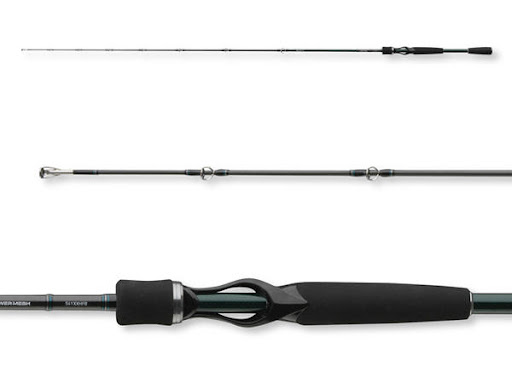
A magnificent model among the wide range of specialized pike rods. This rod is designed for active lure fishing (jerking) and convinces with a variety of true highlights.
The rod is characterized first and foremost by its light weight of just 135 g. This is made possible by a DAIWA HFV blank construction with a low resin content in the highly compressed carbon material.
This also makes it perfectly balanced and extremely fast in recovery. The very stiff action allows extremely precise bait guidance of jerkbaits with weights up to 120 g. Optimally suited for long distance casts from the shore, pier, boat or other locations above the water surface.
The rod can be equipped with multi and stationary reels. Fine braided lines then fit perfectly with Fuji Alconite rings, which are specially designed for this type of line.
c) Sportex Avon de Luxe AL3205
Rod length: 3,25 m; Lure weight 72 – 121 g; two-piece; parabolic action;
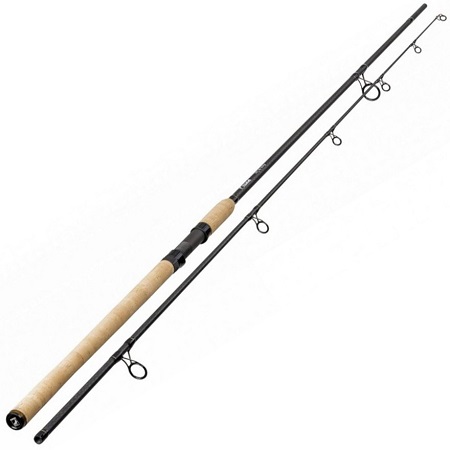
An ideal float rod for pike fishing, which is universally suitable for ground fishing for other predatory and large fish in general. The almost parabolic action allows a soft and wide presentation of the baitfish.
The strong backbone and fast sensitive tip provide a powerful strike and a safe drill in case of sudden escape attempts of the hooked fish. The rod features 7 large sized rings for top casting distances. The high-tech carbon blank and a delicately crafted cork handle underline the noble design of this top pike rod, which has been finished to perfection.
5.2 Which line for pike fishing?
Pike have extremely sharp teeth that can cut through many lines with ease. It is therefore important that you match your line to the reel and rod you intend to use. For a reel with a maximum pulling force of 7 kg, we recommend a braided line of 7 to 9 kilos.
For a reel with a maximum pulling force of 11 kg, we recommend a braided line of 13 to 40 kg. Attach a 1 – 1.5 m long piece of 9 – 18 kg fluorocarbon to your main line as a trace.
Some anglers add a wire bail to the end of the line to reduce the chance of the pike biting it off. The disadvantage of such, however, is that it can negatively affect the action of the bait used.
5.3 What is the best bait for pike? (Artificial bait or bait fish)
Many fish attack their prey (the bait) from below. In bright daylight, therefore, they only see the contrast against a light gray or blue background. In such a constellation, all colors appear the same.
WWe know this all too well ourselves. In backlit shots, the photographed objects become dark to black if we do not use the flash to brighten them up. Colors are additionally only indistinctly discernible.
Consequently, a lure with a high contrast effect is more important than its mere color. Those who now object that they always catch very well with lure color X may well be right – only that the cause of their catching success may lie more in the contrast (resulting from the color and shape of the lure) and not so much in the color itself.
Two general things can be stated, however:
- Red, orange and yellow are suitable for shallow waters.
- While blue or green are great for the deeper depths.
In addition – and this has already been mentioned several times – the colors have a different effect outside the water than in it. In deeper water regions, therefore, an optical stimulus effect is far less important than movement and possible pressure waves.
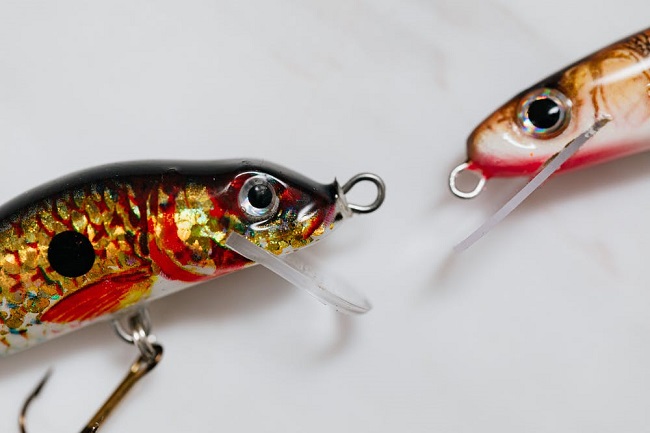
In terms of water turbidity, it also seems to be more effective to use higher contrasts in turbid water and lower in clear conditions. The shape of the bait is especially important in turbid water. So it is important to know which forage fish is our predators’ favorite. Smelt has a different shape than perch and small bream are clearly different from gudgeon.
As a general rule, the bait offered should match the prey pattern of our target fish as well as possible: The pike with its high aggression potential is quite willing to accept artificial baits. However, depending on the season and the associated natural food supply, dead bait fish are the better choice.
Get to know more about the best pike lures.
What float and mounting for pike fishing with baitfish?
Since fishing with live bait fish has been banned in most countries, the days of crude mounts and oversized floats are over as well. A modern mount (including a float) for pike fishing can look like the following, for example:
- Choose the float only as large as absolutely necessary: For dead baitfish, a carrying capacity between 6 and 15 grams is sufficient.
- Keep the assembly simple: Stopper, float, lead and a swivel, into which we hook the steel tracer – nothing more is needed.
- Hook the bait fish in the most natural swimming position possible: For this purpose, a system with two treble hooks is excellent. One for the dorsal fin, the other for the pectoral fin. It is also important to pierce the swim bladder so that the baitfish can sink and not float on the water surface, as well as to stabilize it. A wooden skewer is excellent for this purpose.
- Let the float drift on the water surface: For this purpose, it is helpful to additionally grease the line so that it rests on the water. This not only gives the bait fish some movement, it also makes it easier to control. In addition, the strike comes through more directly.
This brings us to the end of our article with the best tips for pike fishing. If you have any questions, additions or comments, please let us know – we look forward to your feedback – and feel free to browse through our extensive fishfinder test (including the latest models of all major manufacturers such as Garmin, Lowrance, Humminbird or Raymarine). Have fun on your next fishing trip and “Petri Heil”! – Martin and Jens.
Could you take 1 Click to share your experiences?
We will be forever grateful. With your rating we can improve.
average rating 5 / 5. Number of ratings: 2
Be the first to rate this post!

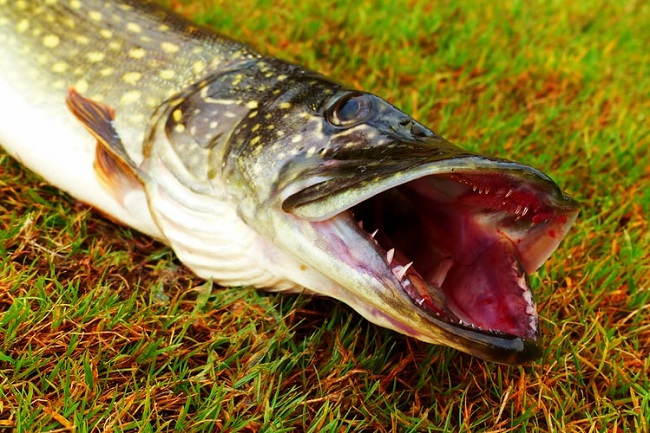
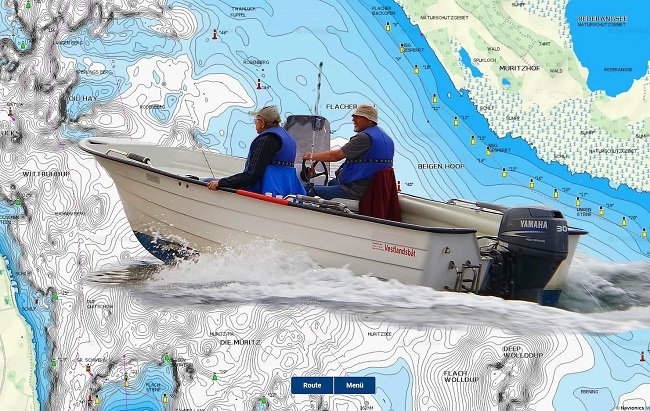
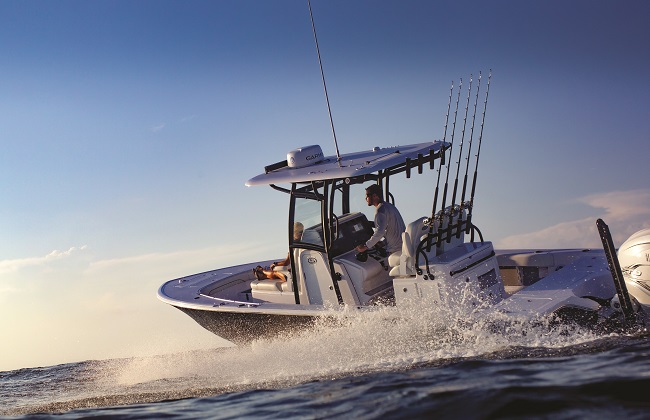
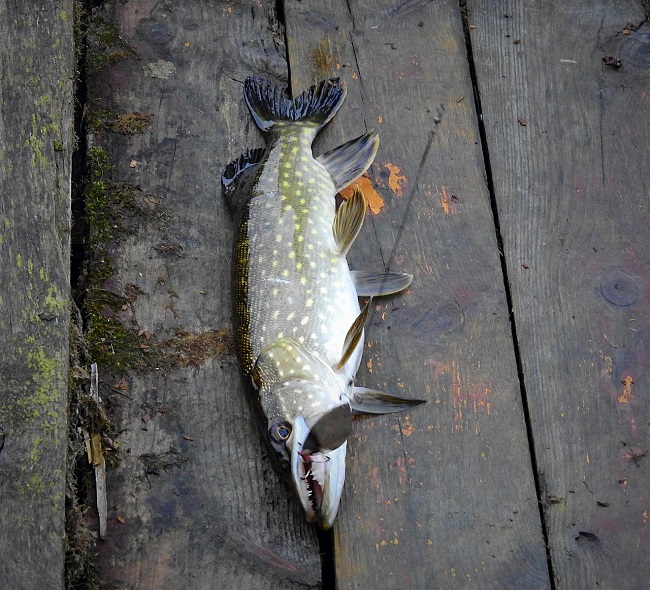
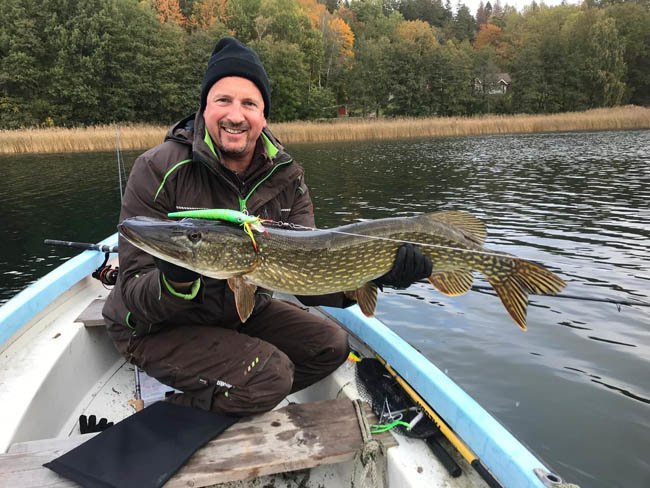
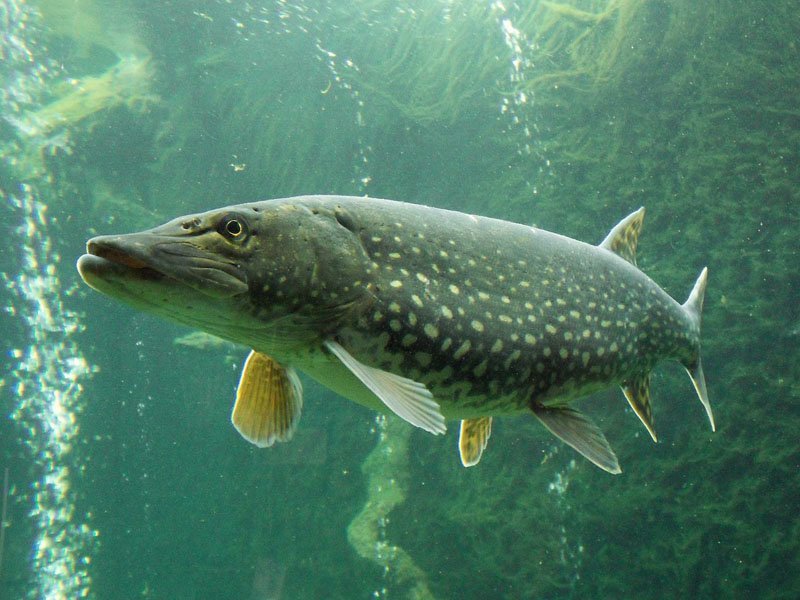
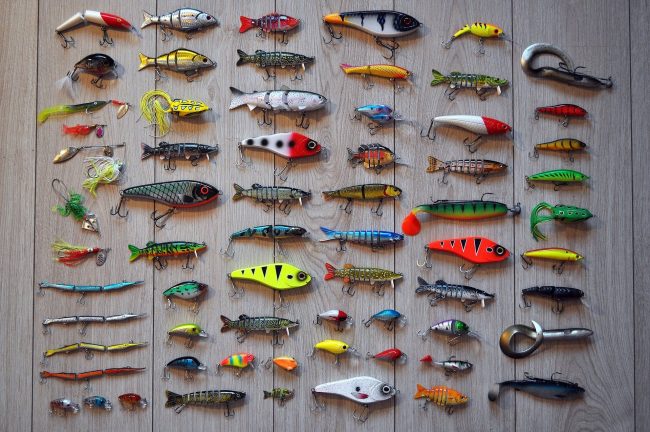
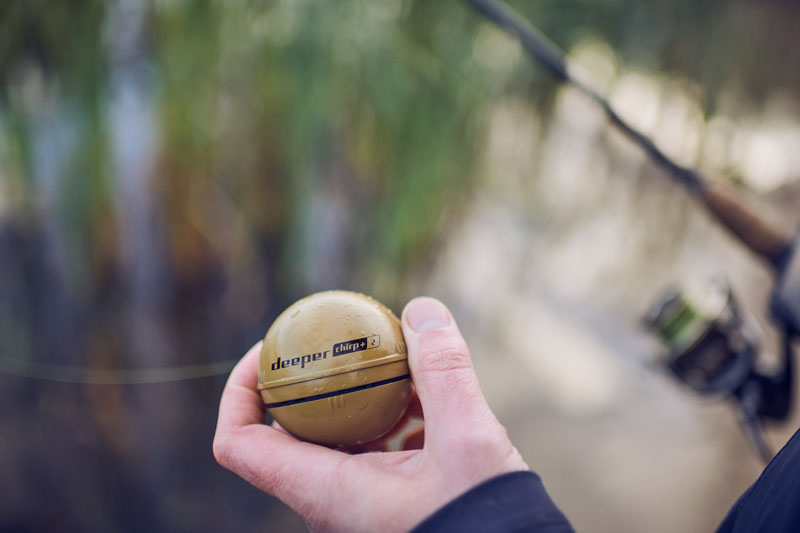

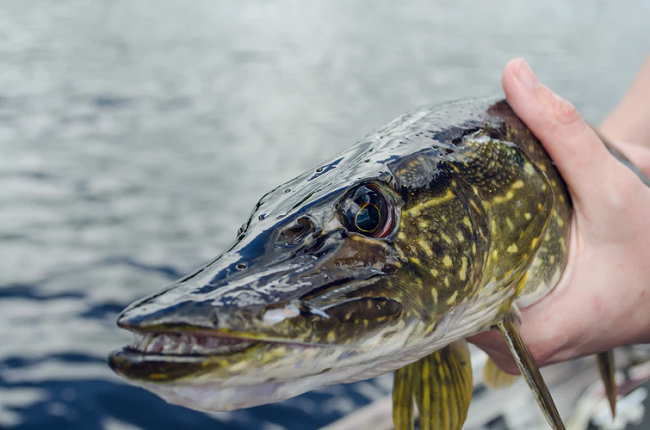
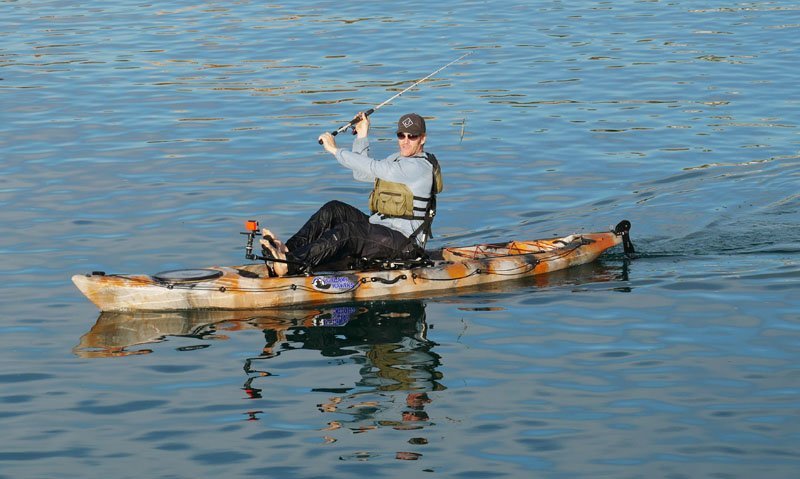
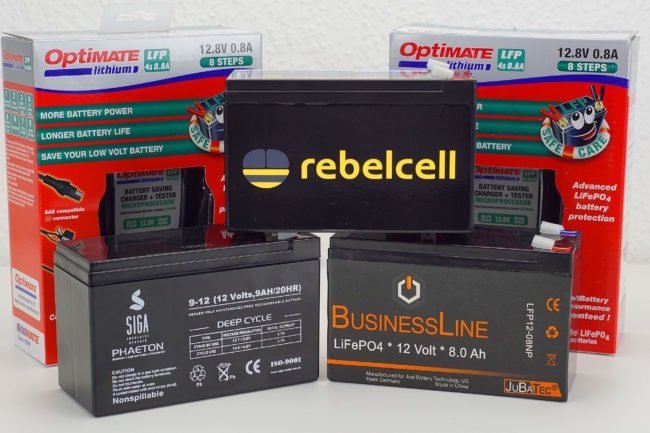
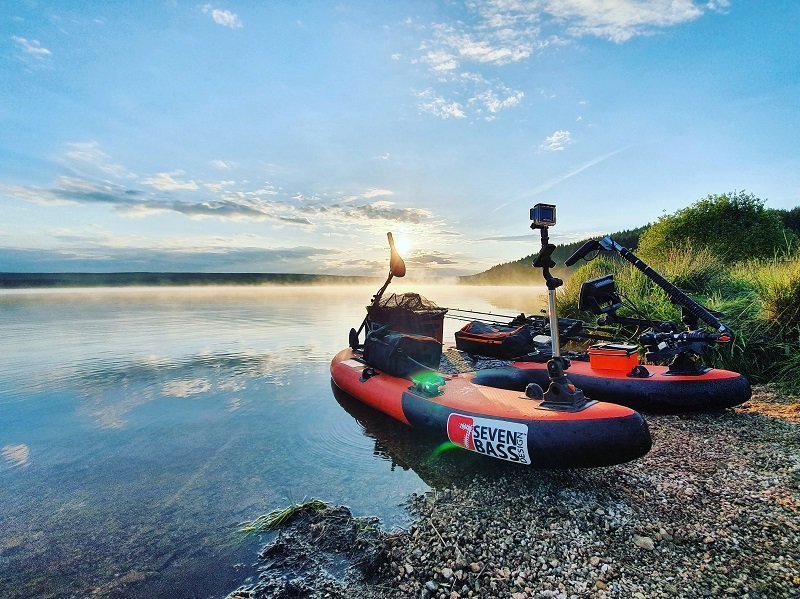
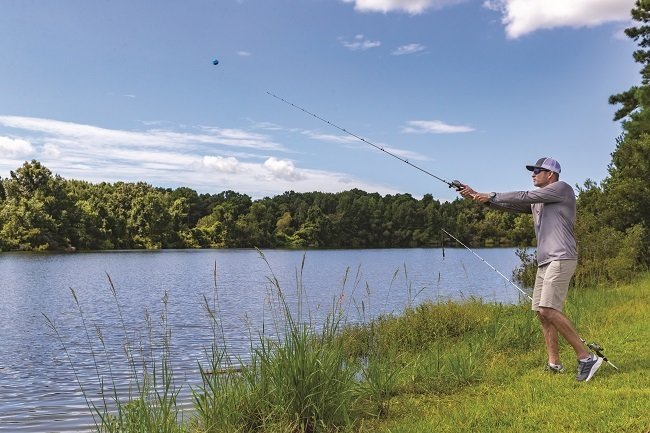
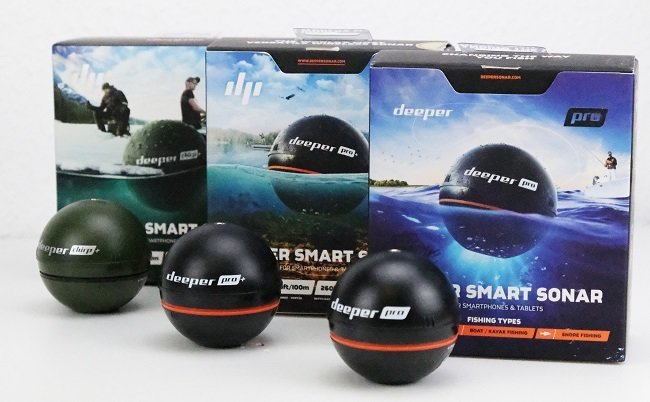

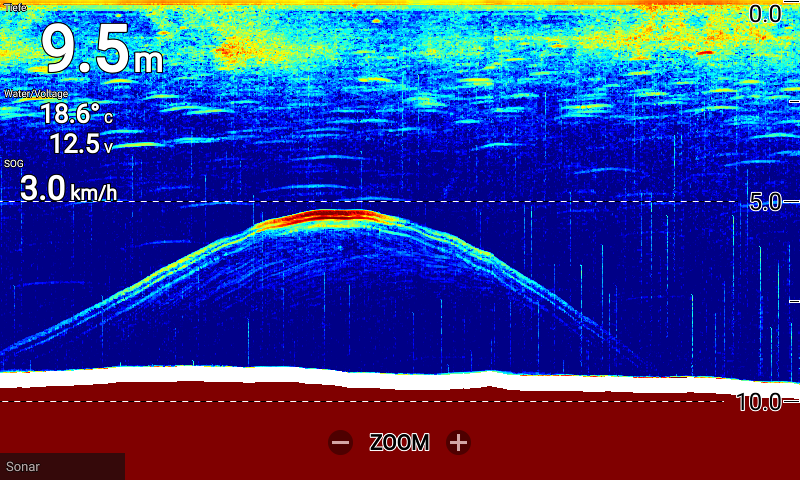
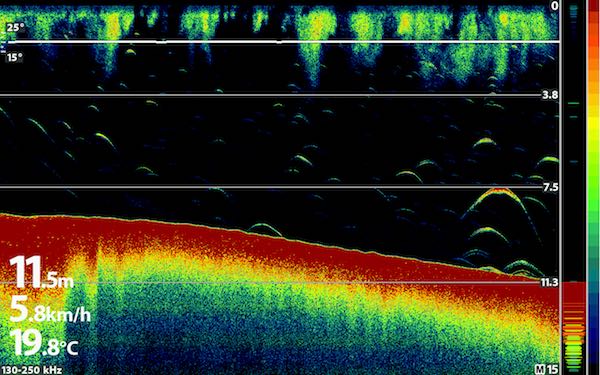
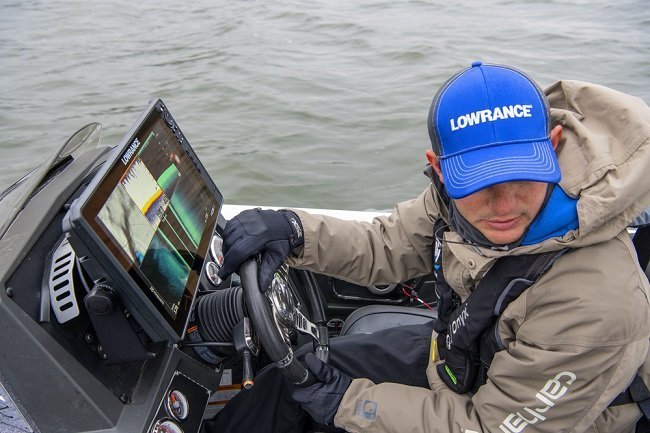
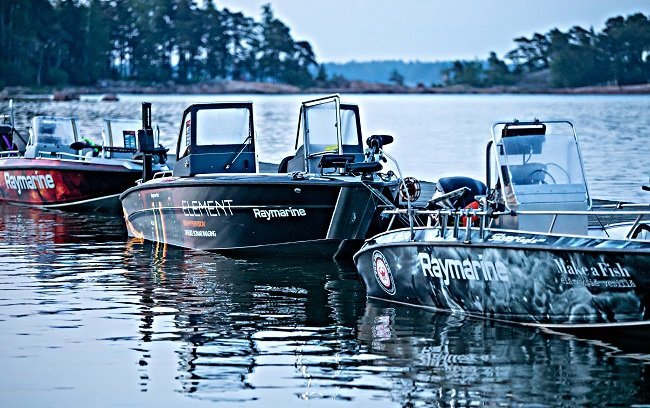
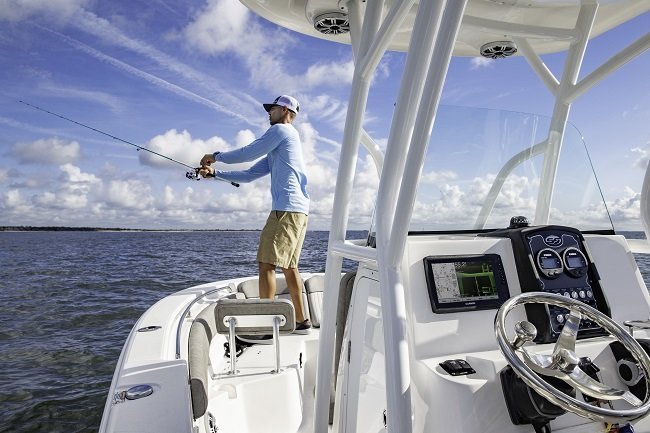

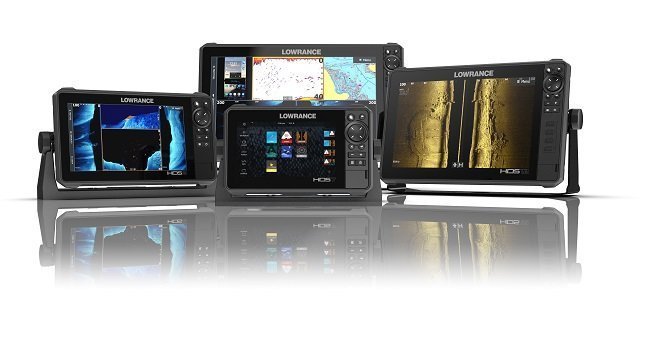
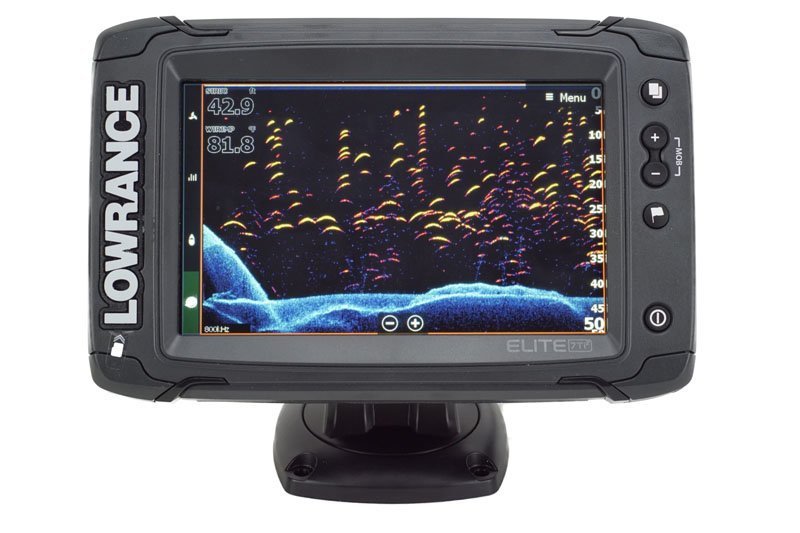
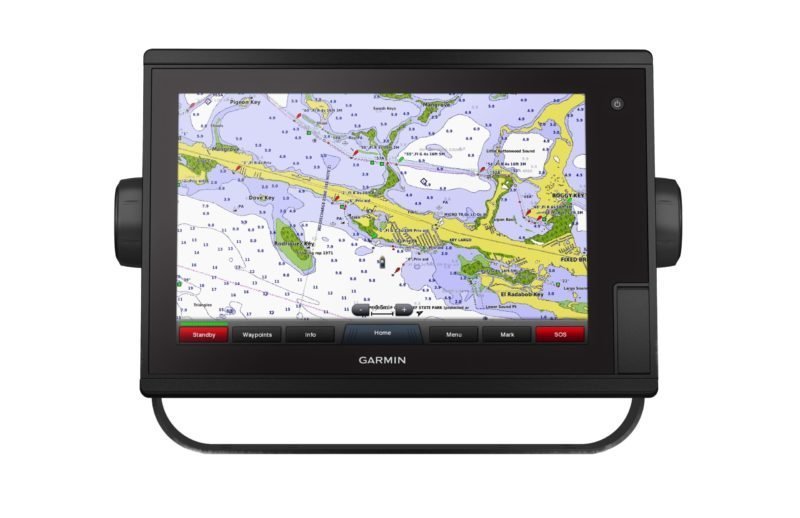
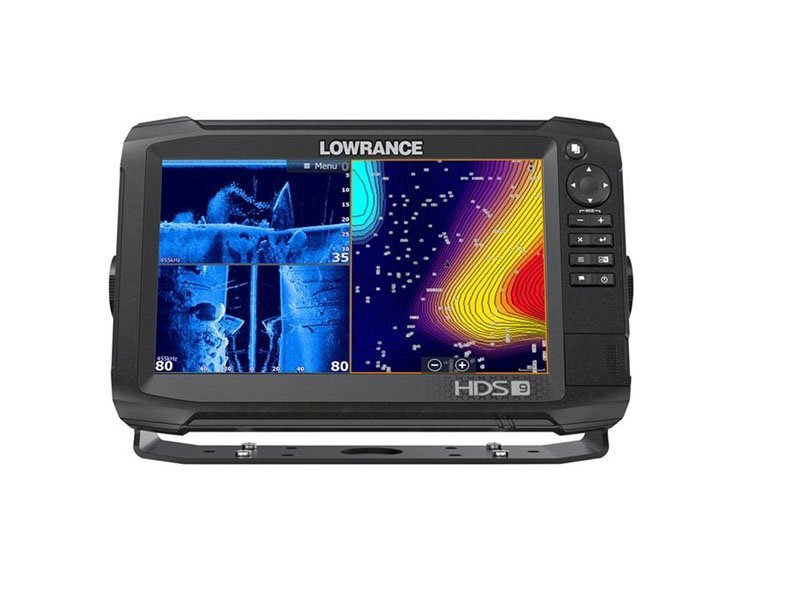
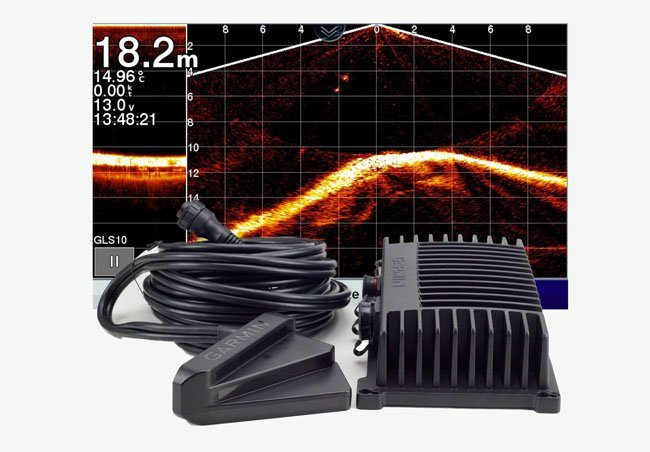
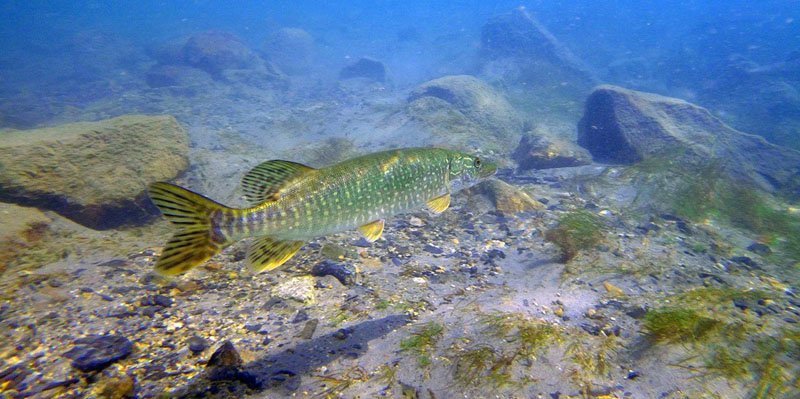
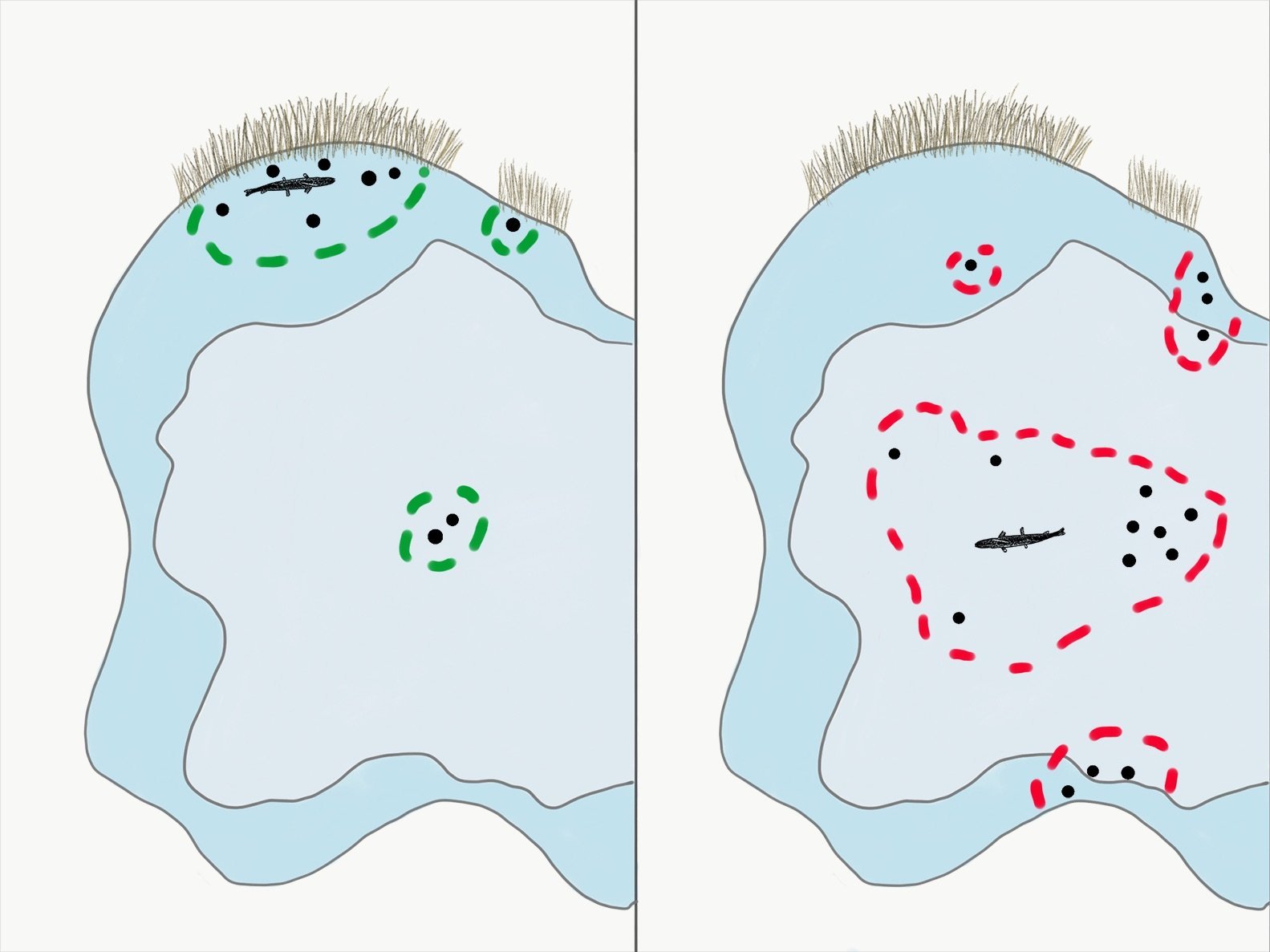
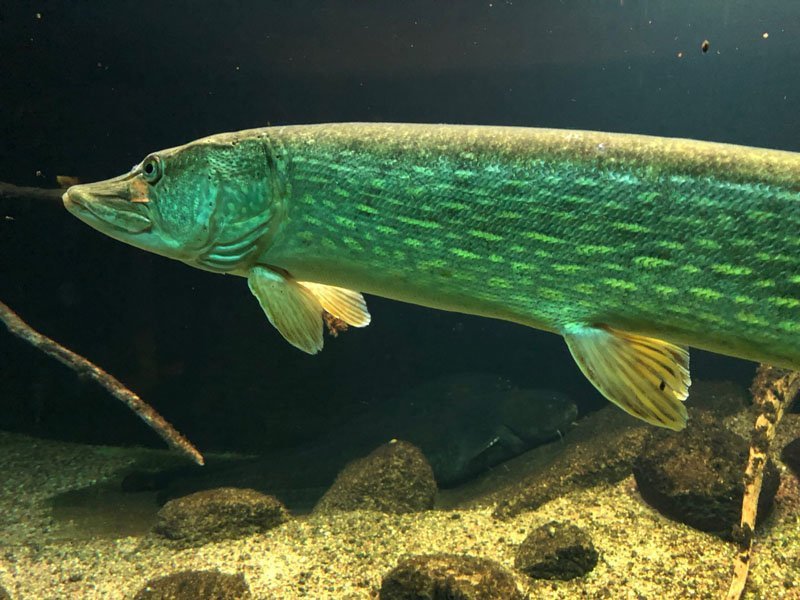
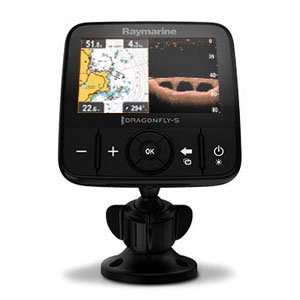
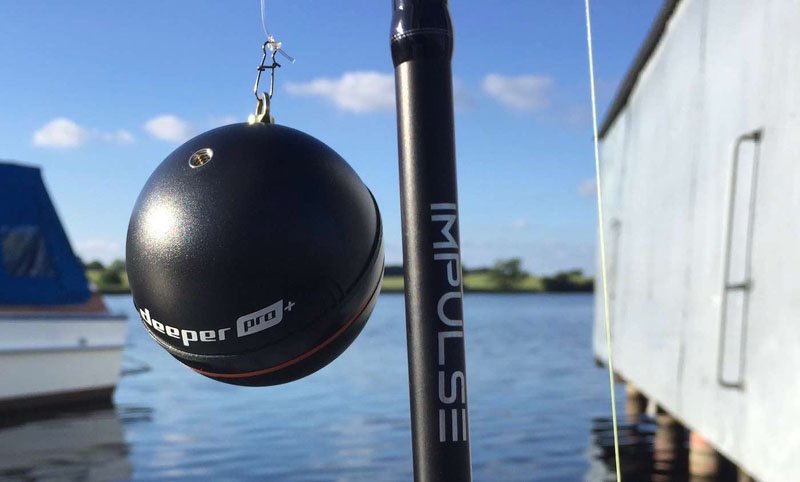
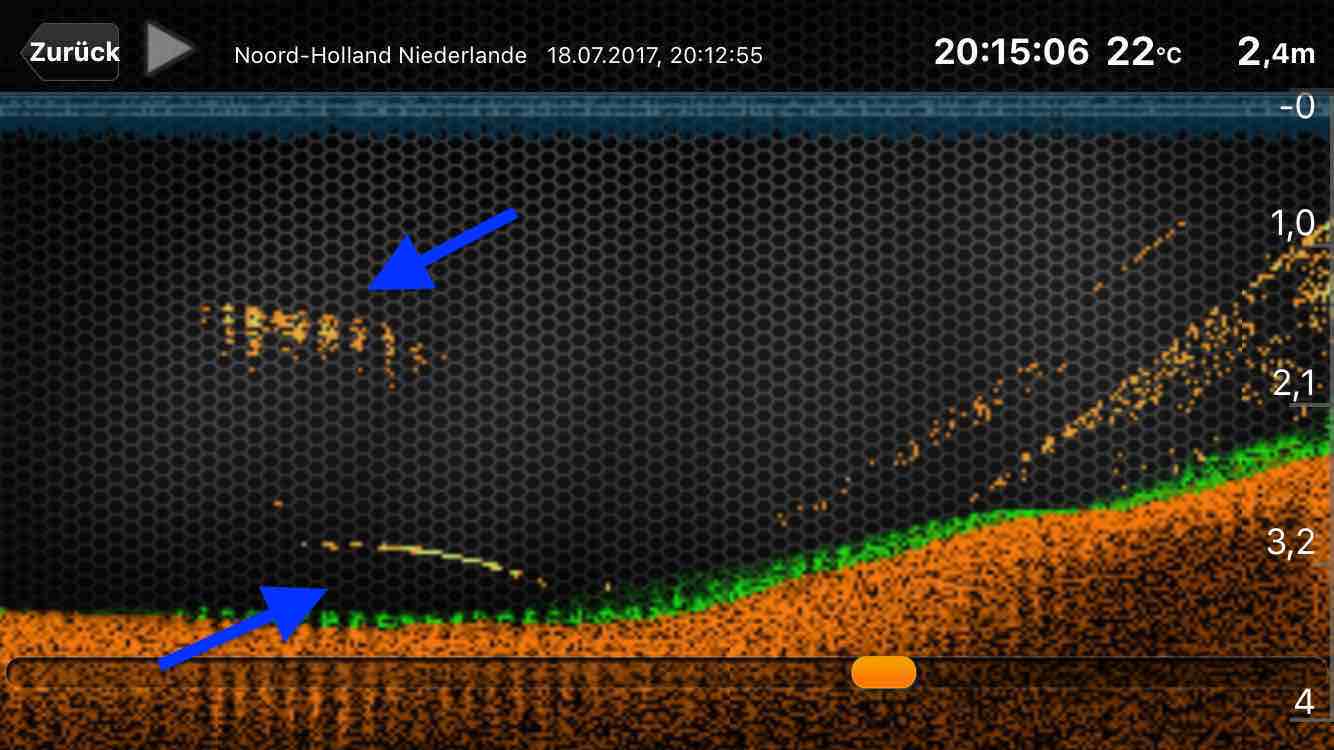
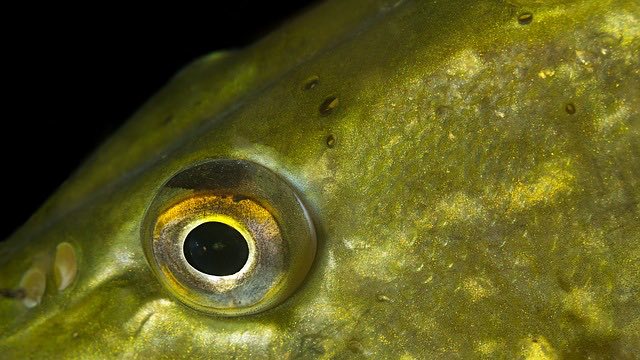


Martin
Garry Gregg
Andreas Eden
Martin
Claus Erhard
Dieter Gundacker
Kurt Sattler
Mirko
Holzblinker
Bruno
Stefan
Fischfreund
Paul KraUS
barney1at
Michael Hügel
frankadam67
Thomas Asamer
Andre Scholz
Manfred Parbs
Fabius Voigt
Julia
Pascal Schlenker
Heinz-Otto Schoel
Andreas Hillers
Stephandargel
Rolf Wilde
Blankmaster
Rudolf Knopf
markus s
Mitja
schoenfeld.oli
Robert Häusler
Martin
Edi Brader
lusox
Stefan Fischer
Lasse Wiedenhöft
Johann Burgstaller
Barschhunter
Andre Scholz
Andreas F.
Pascal Kreutzmann
Ralf B.
Bickes
opto
Adrian Drzezla
Evgenij
Daniel
Jörg
Dirk Lindner
Jörg Thielke
Stefan Klingbeil
Jörg Rolle
Philipp
Ben
Nico Drabner
Kuhnert Giso
David Götze
Peter
Ben
Kantor Alfred (Hatschi)
Patrick
Tacklefever
Andreas
Wolfgang Konter
Catchmaster
Jörg Rolle